Paul van Yperen's Blog, page 103
December 8, 2022
Anita Page
Beautiful Anita Page (1910–2008) was one of the most popular leading ladies of Hollywood during the last years of the silent screen and the first years of the sound era. According to MGM, she received the most fan mail at the time and her nickname was "the girl with the most beautiful face in Hollywood".
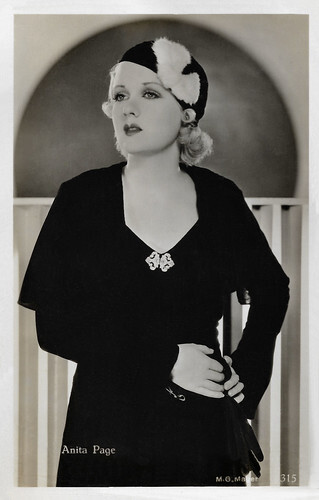
Dutch postcard by JosPe, no. 315. Photo: Metro-Goldwyn-Mayer.
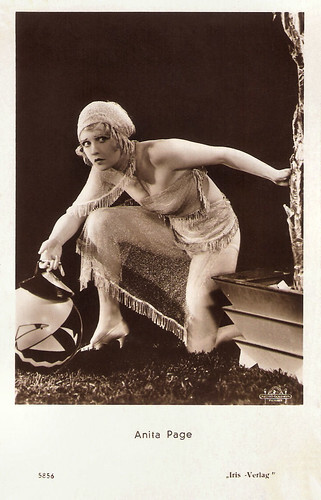
Austrian postcard by Iris-Verlag, no. 5856. Photo: Metro-Goldwyn-Mayer.
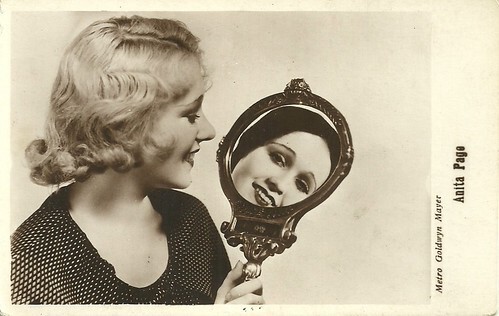
Italian postcard by G.B. Falci, Milano. Photo: Metro-Goldwyn-Mayer.
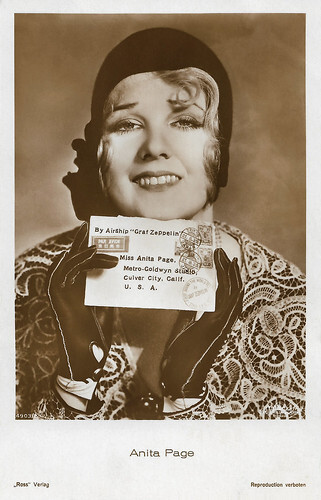
German postcard by Ross Verlag, no. 4903/2, 1929-1930. Photo: Metro-Goldwyn-Mayer.
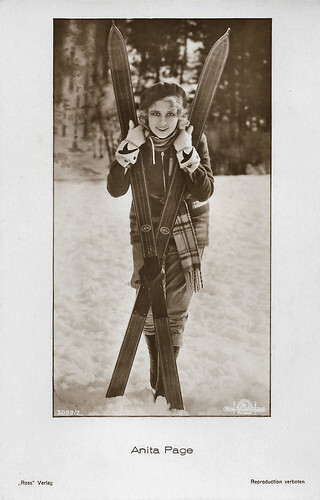
German postcard by Ross Verlag, no. 5099/2, 1930-1931. Photo: Metro-Goldwyn-Mayer.
Our Dancing Daughters
Anita Page was born Anita Pomares in New York in 1910. Her father, Marino Pomares, had an electrical contracting business in Murray Hill, Flushing, New York City.Her mother was Helen "Maude" Mullane. After the birth of her younger brother Marino, the family moved to Astoria, a neighbourhood in the New York borough of Queens. Here she spent her childhood with her neighbours, Betty Bronson 's family.
Betty Bronson made her debut in Peter Pan (Herbert Brenon, 1924), after which her family moved to Hollywood. However, they returned briefly to the East Coast for the filming of A Kiss for Cinderella (Herbert Brenon, 1925). They stayed at the Plaza Hotel and invited the young Page. Page herself had wanted to be an actress since childhood and this was noticed by Bronson. She gave her advice by sharing her own experiences of breaking through as an actress and offered her the role of an extra in A Kiss for Cinderella. Page accepted the offer.
Her one-day stay at the studio led to another bit part in Love 'Em and Leave 'Em (Frank Tuttle, 1926), which starred Evelyn Brent and Louise Brooks . An assistant advised her to take dance and acting lessons so that she "might one day grow into a star". After taking dance lessons from Martha Graham and acting lessons from John Murray Anderson, she met John Robert Powers, and Page was hired as one of his "The Power Girls". One day, he sent her to an audition at the Pathé Studio. She got a role in the short film Beach Nuts (Richard C. Harris, 1927).
Bronson introduced her to agent Harvey Pugh. He arranged a screen test and soon Page was offered a film contract with Metro-Goldwyn-Mayer. Page was cast opposite William Haines in Telling the World (Sam Wood, 1928). The film became a huge success, immediately getting Page noticed. Her next film, Our Dancing Daughters (Harry Beaumont, 1928) opposite Joan Crawford became a major success and caused a huge rise in popularity for both of them. After Lon Chaney saw Page in Our Dancing Daughters, he asked Metro-Goldwyn-Mayer to cast her in his new film, While the City Sleeps (Jack Conway, 1928). She then acted opposite Ramon Novarro in the romantic drama The Flying Fleet (George W. Hill, 1928).
Her success in MGM's first highly publicised musical The Broadway Melody (Harry Beaumont, 1929) opposite Bessie Love paved the way for a smooth career in sound cinema. After the film was released, it became a huge success. The Broadway Melody (Harry Beaumont, 1929) became the first sound film to win an Academy Award for Best Picture. It was one of the first musicals to feature a Technicolor sequence, which sparked the trend of colour being used in a flurry of musicals that would hit the screens in 1929–1930. Page also sang several songs, including the popular hit 'You Were Meant for Me', purposely written by Nacio Herb Brown for her. It would remain her theme song.
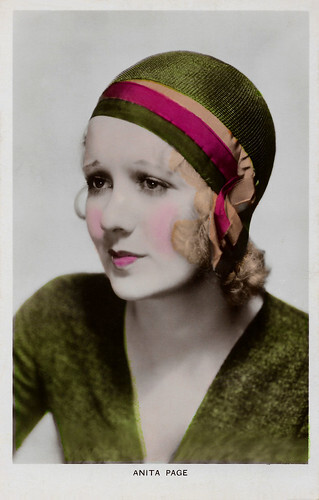
British postcard in the Colourgraph Series, London, no. C 107.
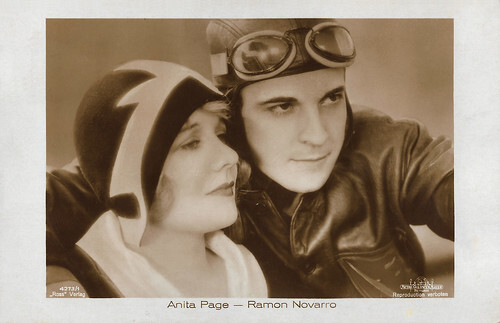
German postcard by Ross Verlag, no. 4273/1, 1929-1930. Photo: Metro-Goldwyn-Mayer. Anita Page and Ramon Novarro in The Flying Fleet (George W. Hill, 1929).
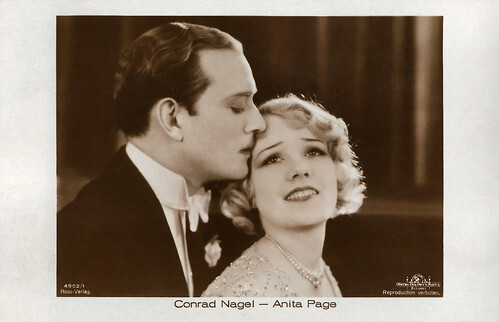
German postcard by Ross Verlag, no. 4902/1, 1929-1930. Photo: Metro Goldwyn Mayer. Conrad Nagel and Anita Page in The Hollywood Revue of 1929 (Charles Reisner, 1929).
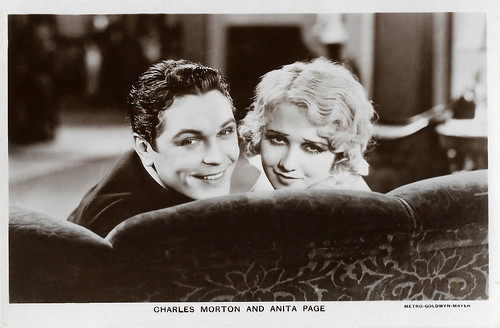
British postcard in the Film Partners Series, London, no. PC 64. Photo: Metro-Goldwyn-Mayer. Charles Morton and Anita Page in Caught Short (Charles Reisner, 1930).
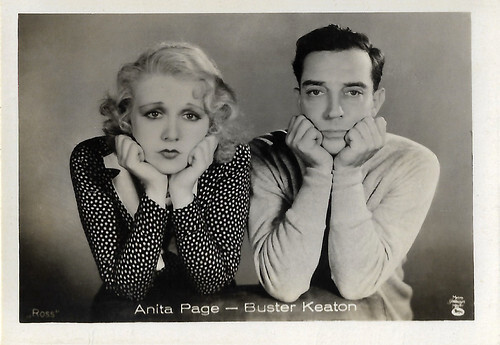
German cigarette card in the Hänsom Filmbilder series, Series V, no. 113 (of 147) by Ross Verlag for Jaszmatzi Cigarettenfabrik G.M.B.H., Dresden. Photo: Metro-Goldwyn-Mayer. Anita Page and Buster Keaton in Free and Easy (Edward Sedgwick, 1930).
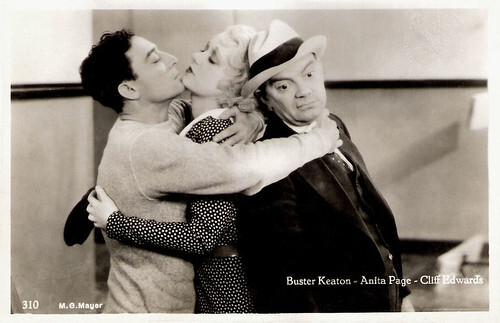
Dutch postcard by JosPe, no. 310. Photo: Metro-Goldwyn-Mayer (MGM). Buster Keaton , Anita Page and Cliff Edwards in Sidewalks of New York (Zion Myers, Jules White, 1931).
Marrying a bigamist
In the early 1930s, Anita Page had a busy career in American films opposite actors like Buster Keaton , John Gilbert , Walter Huston, Robert Montgomery, and Clark Gable with whom she was romantically involved. Her mother, Helen "Maude", was her secretary. Her father, John, was her chauffeur. Her brother, Marino, was her gym instructor.
When not working on films, she was busy with studio photographer George Hurrell creating publicity shots. She was one of his first subjects, and her photograph was his first to be published. After Garbo, she was the actress who got the most fan mail and Italian dictator Benito Mussolini supposedly kept proposing to her.
At the age of 23, Page suddenly quit filming when her contract expired in 1933. She retired as she was denied a pay rise. Nacio Herb Brown, the composer of her song 'You Were Meant For Me', became her husband in 1934 until Page shortly after the wedding discovered he was a bigamist.
She made one more film, the low-budget drama Hitch Hike to Heaven (Frank R. Strayer, 1936), and then retired fully from acting. In an interview in 2004, Page told the reason was she had refused sexual favours to MGM producers Irving Thalberg and Louis B. Mayer, after which Mayer made sure she was banned from any studio. She married Navy pilot Lieutenant Hershel A. House in 1937. They lived in Coronado, California, until his death in 1991. They had two daughters, Linda House and Sandra House. Sandra, who was an artist at Disney, predeceased her.
At age 85, Anita made a come-back in Sunset After Dark (Mark J. Gordon, 1996). After sixty years of absence from cinema, she played in various low-budget horror movies such as Witchcraft XI: Sisters in Blood (Ron Ford, 2000). She loved her old films, did many interviews, and always answered her fan mail. In 2009, Anita Page died in her sleep at the age of 98 in her Los Angeles home where she had lived with her good friend, actor Randal Malone, her caretaker in her final years. They appeared together in her final film, Frankenstein Rising (Eric Swelstad, 2010). Upon her death, her remains were interred at Holy Cross Cemetery in San Diego, California.
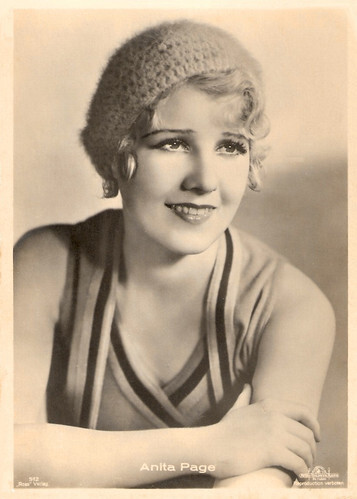
German postcard by Ross Verlag in the Luxus series, no. 512. Photo: Metro-Goldwyn-Mayer.
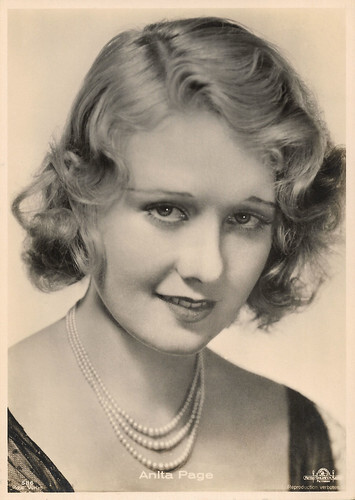
German postcard by Ross-Verlag in the Luxus series, no. 586. Photo: Metro-Goldwyn-Mayer.
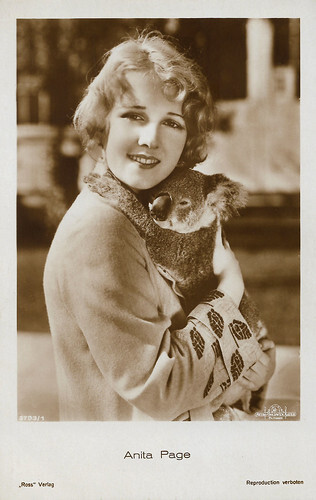
German postcard by Ross Verlag, no. 3793/1, 1928-1929. Photo: Metro-Goldwyn-Mayer.
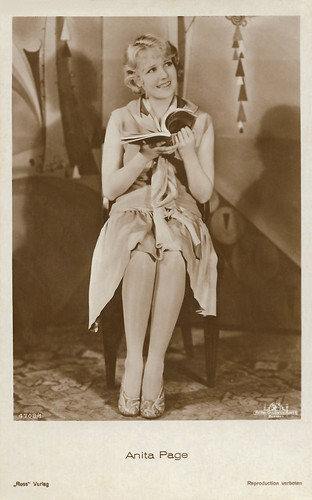
German postcard by Ross Verlag, no. 4708/1, 1929-1930. Photo: Metro-Goldwyn-Mayer.
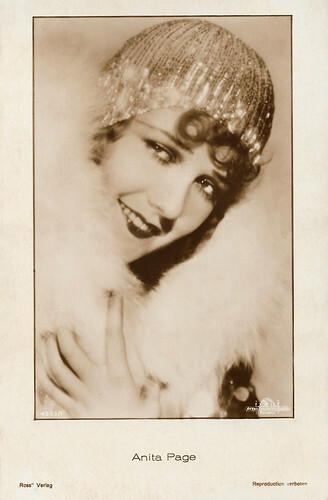
German postcard by Ross Verlag, no. 4903/1, 1929-1930. Photo: Metro-Goldwyn-Mayer.
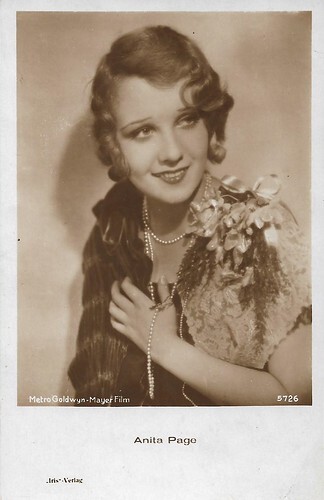
Austrian postcard by Iris Verlag, no. 5726. Photo: Metro-Goldwyn-Mayer.
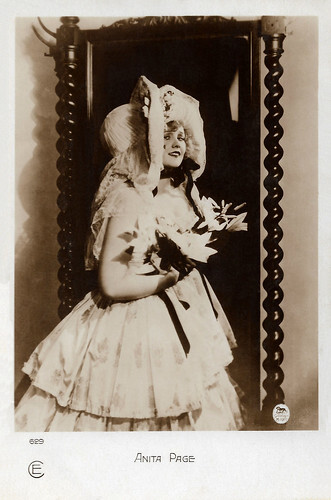
French postcard by Cinémagazine-Editions, no. 629. Photo: Metro-Goldwyn-Mayer.
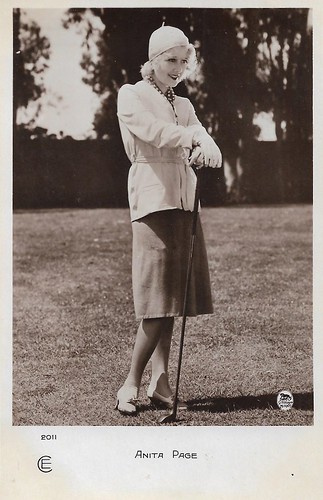
French postcard by Cinémagazine-Edition, Paris, no. 2011. Photo: Metro Goldwyn Mayer.
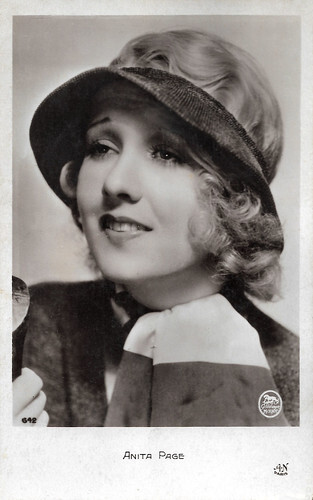
French postcard by A.N., Paris, no. 642. Photo: Metro-Goldwyn-Mayer.
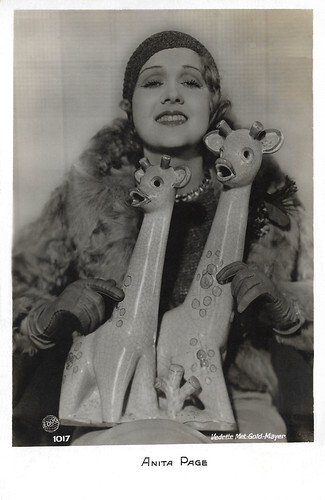
French postcard by E.D.U.G., no. 1017. Photo: Metro-Goldwyn-Mayer.
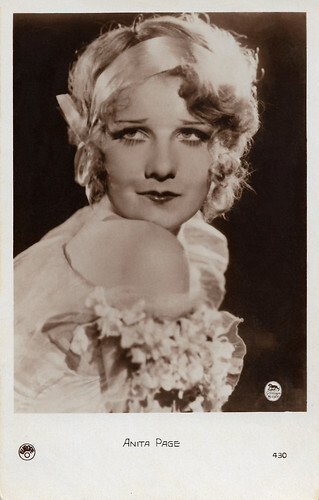
French postcard by Europe, no. 430. Photo: Metro-Goldwyn-Mayer.
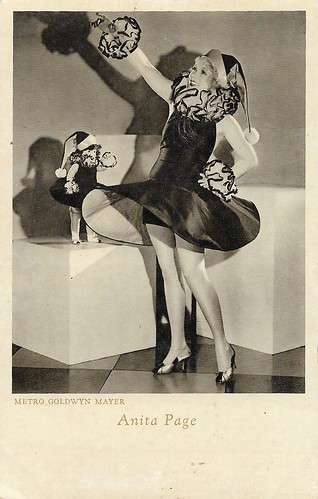
Italian postcard by Cinema-Illustrazione, Milano, Serie 1, no. 30. Photo: Metro-Goldwyn-Mayer. Cinema Illustrazione was an Italian popular film journal that existed between 1926 and 1939.
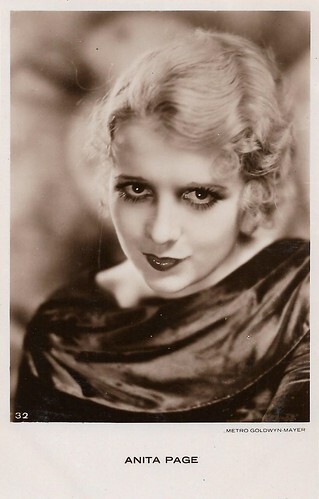
Dutch postcard by JosPe, no. 32. Photo: Metro-Goldwyn-Mayer.
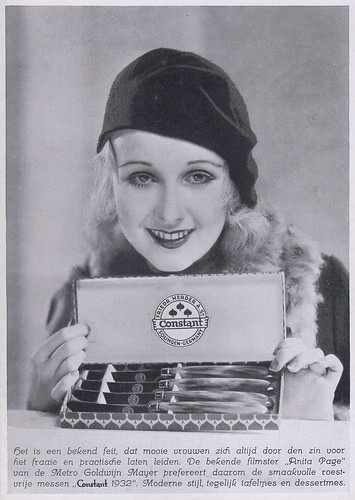
Dutch postcard for Constant knives. Photo: Metro-Goldwyn-Mayer. Collection: Marlene Pilaete.
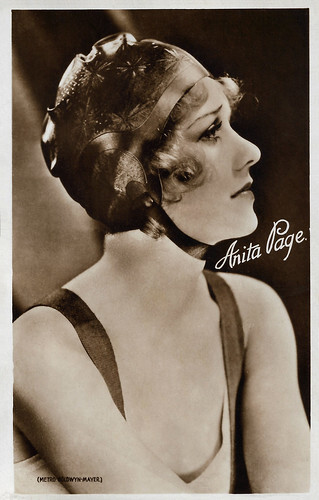
British postcard, no. 56 of a second Series of 42 Cinema Stars, issued with Sarony Cigarettes. Photo: Metro-Goldwyn-Mayer.
Sources: Wikipedia (English and Dutch), the Anita Page website and .

Dutch postcard by JosPe, no. 315. Photo: Metro-Goldwyn-Mayer.

Austrian postcard by Iris-Verlag, no. 5856. Photo: Metro-Goldwyn-Mayer.

Italian postcard by G.B. Falci, Milano. Photo: Metro-Goldwyn-Mayer.

German postcard by Ross Verlag, no. 4903/2, 1929-1930. Photo: Metro-Goldwyn-Mayer.

German postcard by Ross Verlag, no. 5099/2, 1930-1931. Photo: Metro-Goldwyn-Mayer.
Our Dancing Daughters
Anita Page was born Anita Pomares in New York in 1910. Her father, Marino Pomares, had an electrical contracting business in Murray Hill, Flushing, New York City.Her mother was Helen "Maude" Mullane. After the birth of her younger brother Marino, the family moved to Astoria, a neighbourhood in the New York borough of Queens. Here she spent her childhood with her neighbours, Betty Bronson 's family.
Betty Bronson made her debut in Peter Pan (Herbert Brenon, 1924), after which her family moved to Hollywood. However, they returned briefly to the East Coast for the filming of A Kiss for Cinderella (Herbert Brenon, 1925). They stayed at the Plaza Hotel and invited the young Page. Page herself had wanted to be an actress since childhood and this was noticed by Bronson. She gave her advice by sharing her own experiences of breaking through as an actress and offered her the role of an extra in A Kiss for Cinderella. Page accepted the offer.
Her one-day stay at the studio led to another bit part in Love 'Em and Leave 'Em (Frank Tuttle, 1926), which starred Evelyn Brent and Louise Brooks . An assistant advised her to take dance and acting lessons so that she "might one day grow into a star". After taking dance lessons from Martha Graham and acting lessons from John Murray Anderson, she met John Robert Powers, and Page was hired as one of his "The Power Girls". One day, he sent her to an audition at the Pathé Studio. She got a role in the short film Beach Nuts (Richard C. Harris, 1927).
Bronson introduced her to agent Harvey Pugh. He arranged a screen test and soon Page was offered a film contract with Metro-Goldwyn-Mayer. Page was cast opposite William Haines in Telling the World (Sam Wood, 1928). The film became a huge success, immediately getting Page noticed. Her next film, Our Dancing Daughters (Harry Beaumont, 1928) opposite Joan Crawford became a major success and caused a huge rise in popularity for both of them. After Lon Chaney saw Page in Our Dancing Daughters, he asked Metro-Goldwyn-Mayer to cast her in his new film, While the City Sleeps (Jack Conway, 1928). She then acted opposite Ramon Novarro in the romantic drama The Flying Fleet (George W. Hill, 1928).
Her success in MGM's first highly publicised musical The Broadway Melody (Harry Beaumont, 1929) opposite Bessie Love paved the way for a smooth career in sound cinema. After the film was released, it became a huge success. The Broadway Melody (Harry Beaumont, 1929) became the first sound film to win an Academy Award for Best Picture. It was one of the first musicals to feature a Technicolor sequence, which sparked the trend of colour being used in a flurry of musicals that would hit the screens in 1929–1930. Page also sang several songs, including the popular hit 'You Were Meant for Me', purposely written by Nacio Herb Brown for her. It would remain her theme song.

British postcard in the Colourgraph Series, London, no. C 107.

German postcard by Ross Verlag, no. 4273/1, 1929-1930. Photo: Metro-Goldwyn-Mayer. Anita Page and Ramon Novarro in The Flying Fleet (George W. Hill, 1929).

German postcard by Ross Verlag, no. 4902/1, 1929-1930. Photo: Metro Goldwyn Mayer. Conrad Nagel and Anita Page in The Hollywood Revue of 1929 (Charles Reisner, 1929).

British postcard in the Film Partners Series, London, no. PC 64. Photo: Metro-Goldwyn-Mayer. Charles Morton and Anita Page in Caught Short (Charles Reisner, 1930).

German cigarette card in the Hänsom Filmbilder series, Series V, no. 113 (of 147) by Ross Verlag for Jaszmatzi Cigarettenfabrik G.M.B.H., Dresden. Photo: Metro-Goldwyn-Mayer. Anita Page and Buster Keaton in Free and Easy (Edward Sedgwick, 1930).

Dutch postcard by JosPe, no. 310. Photo: Metro-Goldwyn-Mayer (MGM). Buster Keaton , Anita Page and Cliff Edwards in Sidewalks of New York (Zion Myers, Jules White, 1931).
Marrying a bigamist
In the early 1930s, Anita Page had a busy career in American films opposite actors like Buster Keaton , John Gilbert , Walter Huston, Robert Montgomery, and Clark Gable with whom she was romantically involved. Her mother, Helen "Maude", was her secretary. Her father, John, was her chauffeur. Her brother, Marino, was her gym instructor.
When not working on films, she was busy with studio photographer George Hurrell creating publicity shots. She was one of his first subjects, and her photograph was his first to be published. After Garbo, she was the actress who got the most fan mail and Italian dictator Benito Mussolini supposedly kept proposing to her.
At the age of 23, Page suddenly quit filming when her contract expired in 1933. She retired as she was denied a pay rise. Nacio Herb Brown, the composer of her song 'You Were Meant For Me', became her husband in 1934 until Page shortly after the wedding discovered he was a bigamist.
She made one more film, the low-budget drama Hitch Hike to Heaven (Frank R. Strayer, 1936), and then retired fully from acting. In an interview in 2004, Page told the reason was she had refused sexual favours to MGM producers Irving Thalberg and Louis B. Mayer, after which Mayer made sure she was banned from any studio. She married Navy pilot Lieutenant Hershel A. House in 1937. They lived in Coronado, California, until his death in 1991. They had two daughters, Linda House and Sandra House. Sandra, who was an artist at Disney, predeceased her.
At age 85, Anita made a come-back in Sunset After Dark (Mark J. Gordon, 1996). After sixty years of absence from cinema, she played in various low-budget horror movies such as Witchcraft XI: Sisters in Blood (Ron Ford, 2000). She loved her old films, did many interviews, and always answered her fan mail. In 2009, Anita Page died in her sleep at the age of 98 in her Los Angeles home where she had lived with her good friend, actor Randal Malone, her caretaker in her final years. They appeared together in her final film, Frankenstein Rising (Eric Swelstad, 2010). Upon her death, her remains were interred at Holy Cross Cemetery in San Diego, California.

German postcard by Ross Verlag in the Luxus series, no. 512. Photo: Metro-Goldwyn-Mayer.

German postcard by Ross-Verlag in the Luxus series, no. 586. Photo: Metro-Goldwyn-Mayer.

German postcard by Ross Verlag, no. 3793/1, 1928-1929. Photo: Metro-Goldwyn-Mayer.

German postcard by Ross Verlag, no. 4708/1, 1929-1930. Photo: Metro-Goldwyn-Mayer.

German postcard by Ross Verlag, no. 4903/1, 1929-1930. Photo: Metro-Goldwyn-Mayer.

Austrian postcard by Iris Verlag, no. 5726. Photo: Metro-Goldwyn-Mayer.

French postcard by Cinémagazine-Editions, no. 629. Photo: Metro-Goldwyn-Mayer.

French postcard by Cinémagazine-Edition, Paris, no. 2011. Photo: Metro Goldwyn Mayer.

French postcard by A.N., Paris, no. 642. Photo: Metro-Goldwyn-Mayer.

French postcard by E.D.U.G., no. 1017. Photo: Metro-Goldwyn-Mayer.

French postcard by Europe, no. 430. Photo: Metro-Goldwyn-Mayer.

Italian postcard by Cinema-Illustrazione, Milano, Serie 1, no. 30. Photo: Metro-Goldwyn-Mayer. Cinema Illustrazione was an Italian popular film journal that existed between 1926 and 1939.

Dutch postcard by JosPe, no. 32. Photo: Metro-Goldwyn-Mayer.

Dutch postcard for Constant knives. Photo: Metro-Goldwyn-Mayer. Collection: Marlene Pilaete.

British postcard, no. 56 of a second Series of 42 Cinema Stars, issued with Sarony Cigarettes. Photo: Metro-Goldwyn-Mayer.
Sources: Wikipedia (English and Dutch), the Anita Page website and .
Published on December 08, 2022 22:00
December 7, 2022
Agnès Laurent
Beautiful French actress Agnès Laurent (1936-2010) featured in a dozen European sexploitation films of the late 1950s and early 1960s. She was touted as 'The New French sex kitten', a rival to Brigitte Bardot.
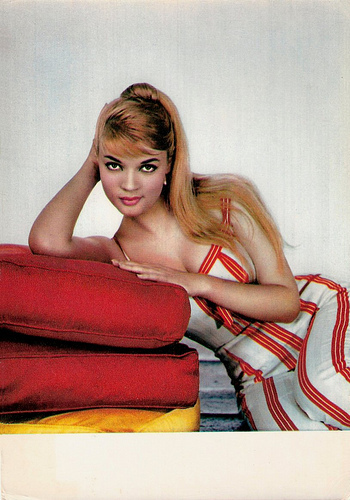
French postcard by Editions P.I., Paris, no. 1013. Photo: Sam Lévin.
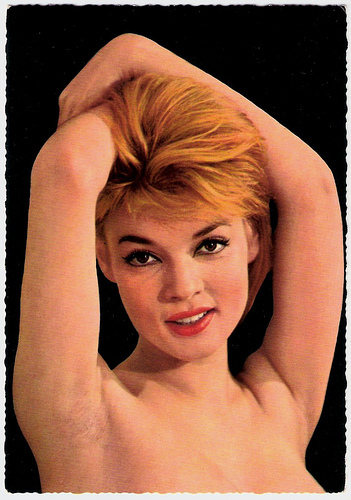
German postcard by Krüger, no. 902/233. Photo: Gérard Decaux.
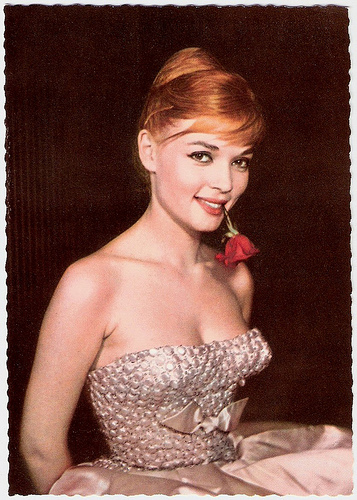
German postcard by Ufa (Universum-Film Aktiengesellschaft), Berlin-Tempelhof, no. CK-182. Retail price: 30 Pfg. Photo: Sam Lévin / Ufa.
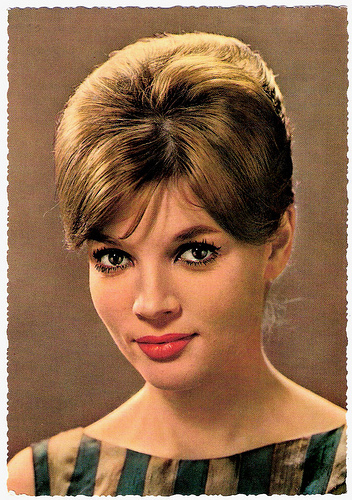
German postcard by Krüger, no. 902/77.
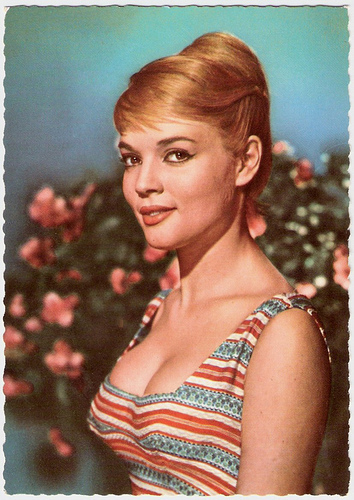
German postcard by Ufa (Universum-Film Aktiengesellschaft), Berlin-Tempelhof, no. CK-199. Retail price: 30 Pfg. Photo: Sam Lévin / Ufa.
Striptease
Agnès Laurent was born Josette Chouleur in Lyon, France in 1936 (according to Les Gens du Cinema , based on her birth certificate) or 1938 (according to CITWF ). After working for a few months as a secretary, she had some acting classes from Eve Francis and Charles Dullin .
She made her film début in the short film Axelle et son Clochard/Axelle and her Tramp (Pierre Foucaud, 1956). The film was produced by René Thévenet, who would also produce some of her later films. Her next stint was a small part in Mannequins de Paris/Mannequins of Paris (André Hunebelle, 1956) starring Madeleine Robinson and Ivan Desny .
In her following film she was already top-billed, Les Collegiennes/The Twilight Girls (André Hunebelle, 1956) about the turbulent emotions among girls in a regimented French girls' school. In the film also appeared a young Catherine Deneuve . In the sexploitation melodrama Marchands De Filles/Sellers Of Girls (Maurice Cloche, 1957) she gets involved with a white slavery racket. While on a ship to South America, she becomes engaged to a crewman, played by Georges Marchal , and then she tackles the syndicate head-on.
In the sex comedy Mademoiselle Striptease/The Nude Set (Pierre Foucaud, 1957), she played a spoiled young provincial girl who coerces her wealthy parents into sending her to Paris. In gay Paris, Agnes discovers the bohemian nightclubs where striptease has become so popular - in no time the timid country girl goes from spectator to performer.
Mark Deming calls it at AllMovie ‘a charming sexual frolic that features outstanding striptease and cabaret performances.' When Audubon Films released The Nude Set in 1961 in the US, the big selling point was Agnès Laurent. The film's sexy young star was touted by Audubon as 'The New French Sex Kitten'. She was hailed as a rival to Brigitte Bardot .
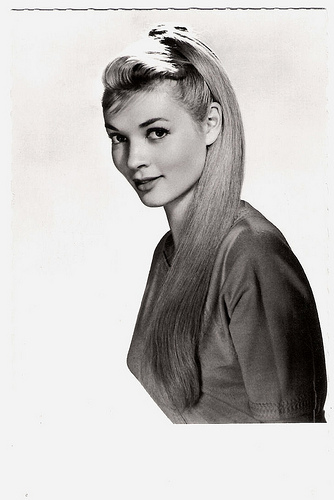
French postcard by Editions P.I., Paris, offered by Les Carbones Korès 'Carboplane', no. 896. Photo: Sam Lévin.
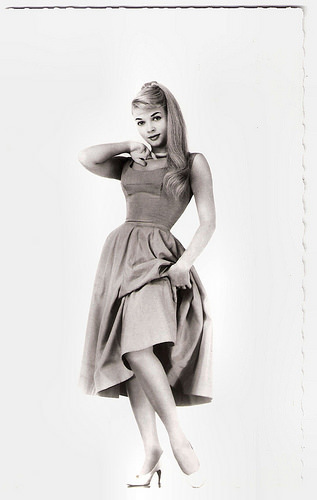
French postcard by Editions P.I., Paris, no. 935. Photo: Sam Lévin.
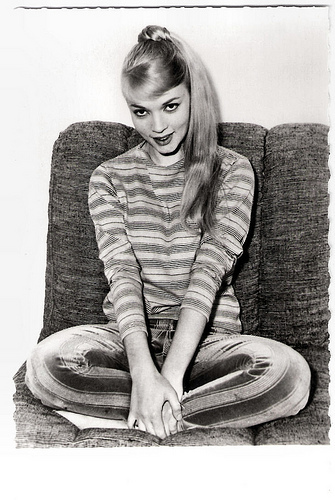
French postcard by Editions P.I., Paris, offered by Les Carbones Korès 'Carboplane', no. 964. Photo: Studio Vauclair.
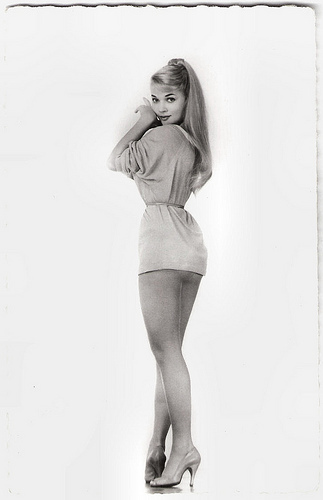
French postcard by Editions du Globe, Paris, no. 727. Photo: Sam Lévin.
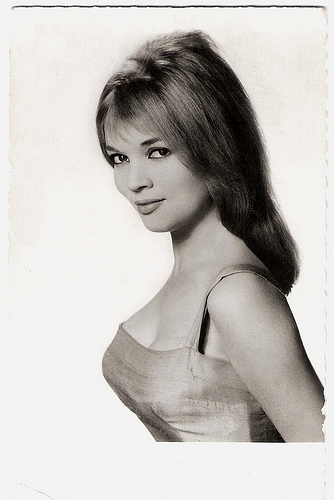
French postcard by Editions P.I., Paris, no. 1025. Photo: Sam Lévin.
Miniature girl
1957 was a busy year for Agnès Laurent. She also appeared as Monette, the sexy assistant of scientist Prof. Jerome ( Jean Marais ) in the Sci-Fi comedy Un amour de poche/Girl in His Pocket (Pierre Kast, 1957).
The professor stumbles upon a formula that shrinks people. When his wife suspects that her husband is carrying on a romance with Monette (she's right), the naked Monette hides herself by drinking the potion and shrinks to 3 inches tall. The professor keeps her in his pocket until he can find an antidote. The film was based on The Diminishing Draft, a short story by Waldemar Kaempfert from 1918.
The following year she appeared in the German-French war film Die grünen Teufel von Monte Cassino/The green Devils of Monte Cassino (Harald Reinl, 1958) featuring Joachim Fuchsberger.
In 1959, Lauerent starred in the Spanish production Un mundo para mí/Soft Skin and Black Lace (José Antonio de la Loma, 1959). Scenes were later edited in Radley Metzger’s compilation film Dictionary of Sex (1964).
In Spain, she also appeared in Altas variedades/The Big Show (Francisco Rovira Beleta, 1960) opposite Christian Marquand , and in Italy, she made the adventure film La notte del grande assalto/The Night of the Great Attack (Giuseppe Maria Scotese, 1960).
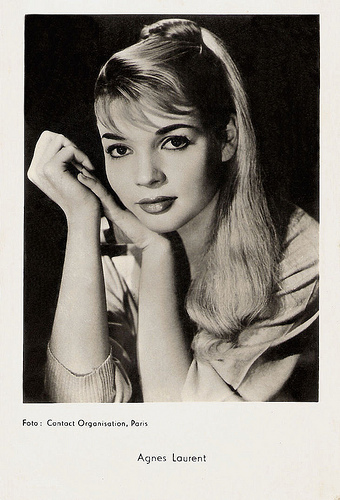
French postcard by Editions P.I., Paris, no. FK 4138. Photo: Contact Organisation, Paris / Ufa, Berlin-Tempelhof.
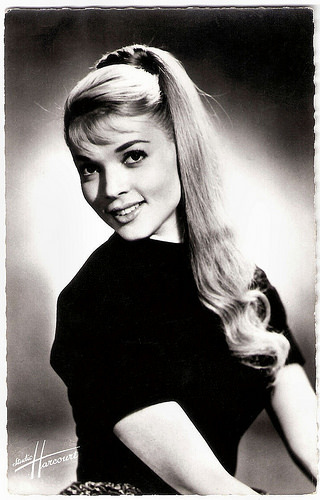
French postcard by Editions du Globe, Paris, no. 692 Photo: Studio Harcourt.
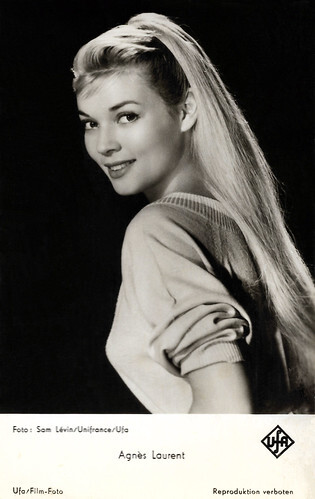
German postcard by Ufa/Film-Foto, no. FK 4502. Photo: Sam Lévin / Unifrance / Ufa.
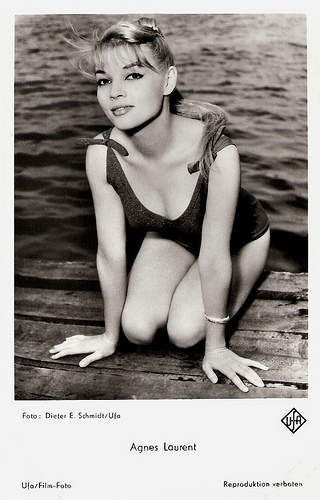
German postcard by Ufa. Photo: Dieter E. Schmidt / Ufa.
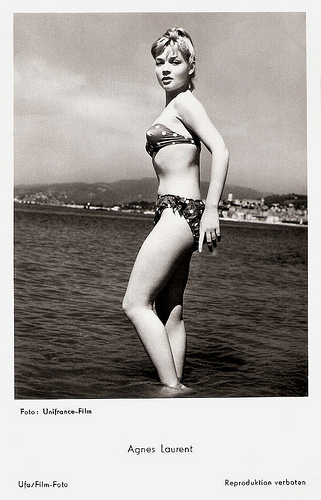
German postcard by Ufa. Photo: Unifrance-Film.
Plenty of ooh la la!
In 1960 Agnès Laurent moved to England to appear in the British comedy A French Mistress (Roy Boulting, 1960). She played a gorgeous new French language teacher at a traditional British boys' school, who causes countless crushes of the young lads and their profs. Jenny Evans at IMDb calls it ‘a breezy comedy with plenty of ooh la la!’.
The following year she appeared in another British comedy Mary Had A Little... (Edward Buzzell, 1961). This was Britain's first sex comedy, according to David McGillivray in his history of the British sex film, Doing Rude Things.
In 1961 she also appeared opposite Jean-Paul Belmondo in the episode Lauzun of the anthology film Amours célèbres/Famous Love Affairs (Michel Boisrond a.o., 1961).
Later she worked for television in TV films like Peril au Paradis/Peril in the Paradise (Edmond T. Greville, 1964).
Laurent then abandoned acting and wrote some crime novels, including 'Au cœur de ma nuit' (In the heart of my night, 1970) and 'Requiem pour un fantôme' (Requiem for a ghost, 1973).
In 2010, Agnés Laurent passed away in Grenoble, France. She was 74.
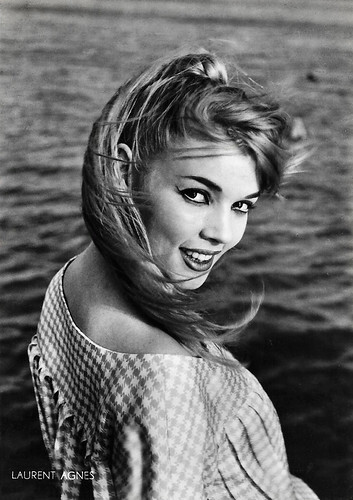
Italian postcard, no. 507.
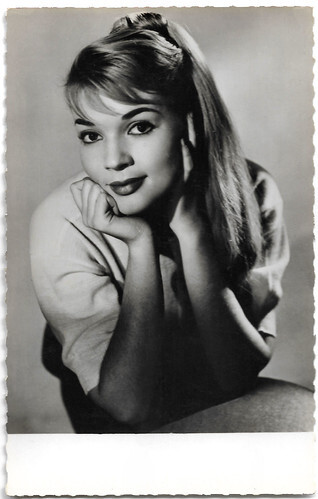
French postcard by Editions P.I., Paris, no. 296, presented by Les Carbones Korès. Studio: Bernard & Vauclair.
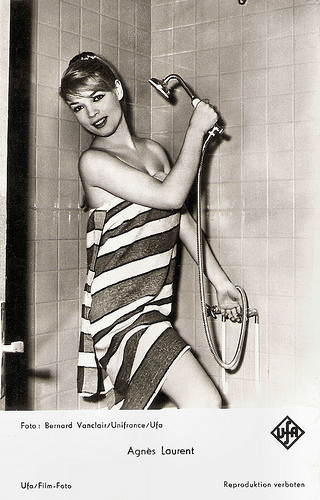
German postcard by UFA, Berlin-Tempelhof, no. FK 4503. Photo: Bernard Vauclair / Unifrance / Ufa.
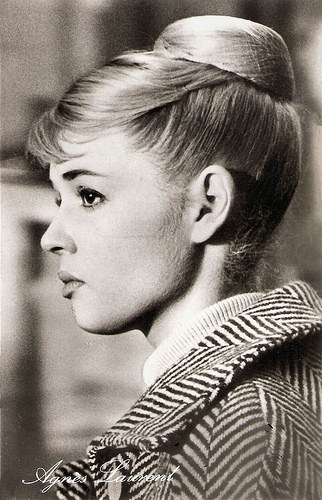
East-German postcard by VEB Progress Film-Vertrieb, Berlin, no. 1103, 1959. Photo: publicity still for Péché de jeunesse/Sins of Youth (Louis Duchesne, 1958).
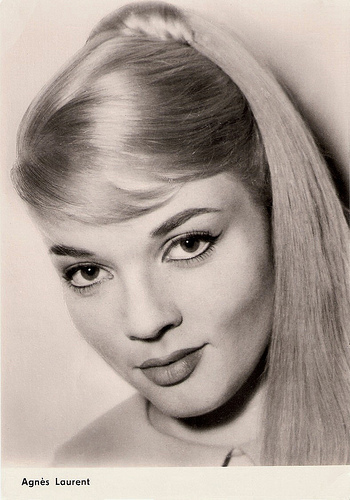
East-German postcard by VEB Progress Film-Vertrieb, Berlin, no. 1105, 1962. Photo: Progress.
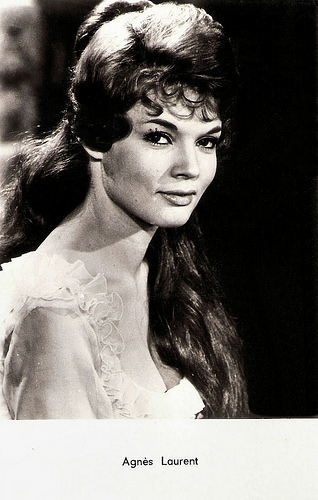
French postcard by Editions P.I., Paris, offered by Les Carbones Korès 'Carboplane', no. 1122. Photo: Unidex. Publicity still for Amours célèbres/Famous Love Affairs (Michel Boisrond, 1961).
American trailer for Marchands De Filles/Sellers Of Girls (1957). Source: SomethingWeirdDotCom (YouTube).
Sources: Mark Deming (AllMovie), Yvan Foucart (Le coin du cinéphage - French), CITWF, Les gens du cinema (French), Wikipedia (Dutch) and .

French postcard by Editions P.I., Paris, no. 1013. Photo: Sam Lévin.

German postcard by Krüger, no. 902/233. Photo: Gérard Decaux.

German postcard by Ufa (Universum-Film Aktiengesellschaft), Berlin-Tempelhof, no. CK-182. Retail price: 30 Pfg. Photo: Sam Lévin / Ufa.

German postcard by Krüger, no. 902/77.

German postcard by Ufa (Universum-Film Aktiengesellschaft), Berlin-Tempelhof, no. CK-199. Retail price: 30 Pfg. Photo: Sam Lévin / Ufa.
Striptease
Agnès Laurent was born Josette Chouleur in Lyon, France in 1936 (according to Les Gens du Cinema , based on her birth certificate) or 1938 (according to CITWF ). After working for a few months as a secretary, she had some acting classes from Eve Francis and Charles Dullin .
She made her film début in the short film Axelle et son Clochard/Axelle and her Tramp (Pierre Foucaud, 1956). The film was produced by René Thévenet, who would also produce some of her later films. Her next stint was a small part in Mannequins de Paris/Mannequins of Paris (André Hunebelle, 1956) starring Madeleine Robinson and Ivan Desny .
In her following film she was already top-billed, Les Collegiennes/The Twilight Girls (André Hunebelle, 1956) about the turbulent emotions among girls in a regimented French girls' school. In the film also appeared a young Catherine Deneuve . In the sexploitation melodrama Marchands De Filles/Sellers Of Girls (Maurice Cloche, 1957) she gets involved with a white slavery racket. While on a ship to South America, she becomes engaged to a crewman, played by Georges Marchal , and then she tackles the syndicate head-on.
In the sex comedy Mademoiselle Striptease/The Nude Set (Pierre Foucaud, 1957), she played a spoiled young provincial girl who coerces her wealthy parents into sending her to Paris. In gay Paris, Agnes discovers the bohemian nightclubs where striptease has become so popular - in no time the timid country girl goes from spectator to performer.
Mark Deming calls it at AllMovie ‘a charming sexual frolic that features outstanding striptease and cabaret performances.' When Audubon Films released The Nude Set in 1961 in the US, the big selling point was Agnès Laurent. The film's sexy young star was touted by Audubon as 'The New French Sex Kitten'. She was hailed as a rival to Brigitte Bardot .

French postcard by Editions P.I., Paris, offered by Les Carbones Korès 'Carboplane', no. 896. Photo: Sam Lévin.

French postcard by Editions P.I., Paris, no. 935. Photo: Sam Lévin.

French postcard by Editions P.I., Paris, offered by Les Carbones Korès 'Carboplane', no. 964. Photo: Studio Vauclair.

French postcard by Editions du Globe, Paris, no. 727. Photo: Sam Lévin.

French postcard by Editions P.I., Paris, no. 1025. Photo: Sam Lévin.
Miniature girl
1957 was a busy year for Agnès Laurent. She also appeared as Monette, the sexy assistant of scientist Prof. Jerome ( Jean Marais ) in the Sci-Fi comedy Un amour de poche/Girl in His Pocket (Pierre Kast, 1957).
The professor stumbles upon a formula that shrinks people. When his wife suspects that her husband is carrying on a romance with Monette (she's right), the naked Monette hides herself by drinking the potion and shrinks to 3 inches tall. The professor keeps her in his pocket until he can find an antidote. The film was based on The Diminishing Draft, a short story by Waldemar Kaempfert from 1918.
The following year she appeared in the German-French war film Die grünen Teufel von Monte Cassino/The green Devils of Monte Cassino (Harald Reinl, 1958) featuring Joachim Fuchsberger.
In 1959, Lauerent starred in the Spanish production Un mundo para mí/Soft Skin and Black Lace (José Antonio de la Loma, 1959). Scenes were later edited in Radley Metzger’s compilation film Dictionary of Sex (1964).
In Spain, she also appeared in Altas variedades/The Big Show (Francisco Rovira Beleta, 1960) opposite Christian Marquand , and in Italy, she made the adventure film La notte del grande assalto/The Night of the Great Attack (Giuseppe Maria Scotese, 1960).

French postcard by Editions P.I., Paris, no. FK 4138. Photo: Contact Organisation, Paris / Ufa, Berlin-Tempelhof.

French postcard by Editions du Globe, Paris, no. 692 Photo: Studio Harcourt.

German postcard by Ufa/Film-Foto, no. FK 4502. Photo: Sam Lévin / Unifrance / Ufa.

German postcard by Ufa. Photo: Dieter E. Schmidt / Ufa.

German postcard by Ufa. Photo: Unifrance-Film.
Plenty of ooh la la!
In 1960 Agnès Laurent moved to England to appear in the British comedy A French Mistress (Roy Boulting, 1960). She played a gorgeous new French language teacher at a traditional British boys' school, who causes countless crushes of the young lads and their profs. Jenny Evans at IMDb calls it ‘a breezy comedy with plenty of ooh la la!’.
The following year she appeared in another British comedy Mary Had A Little... (Edward Buzzell, 1961). This was Britain's first sex comedy, according to David McGillivray in his history of the British sex film, Doing Rude Things.
In 1961 she also appeared opposite Jean-Paul Belmondo in the episode Lauzun of the anthology film Amours célèbres/Famous Love Affairs (Michel Boisrond a.o., 1961).
Later she worked for television in TV films like Peril au Paradis/Peril in the Paradise (Edmond T. Greville, 1964).
Laurent then abandoned acting and wrote some crime novels, including 'Au cœur de ma nuit' (In the heart of my night, 1970) and 'Requiem pour un fantôme' (Requiem for a ghost, 1973).
In 2010, Agnés Laurent passed away in Grenoble, France. She was 74.

Italian postcard, no. 507.

French postcard by Editions P.I., Paris, no. 296, presented by Les Carbones Korès. Studio: Bernard & Vauclair.

German postcard by UFA, Berlin-Tempelhof, no. FK 4503. Photo: Bernard Vauclair / Unifrance / Ufa.

East-German postcard by VEB Progress Film-Vertrieb, Berlin, no. 1103, 1959. Photo: publicity still for Péché de jeunesse/Sins of Youth (Louis Duchesne, 1958).

East-German postcard by VEB Progress Film-Vertrieb, Berlin, no. 1105, 1962. Photo: Progress.

French postcard by Editions P.I., Paris, offered by Les Carbones Korès 'Carboplane', no. 1122. Photo: Unidex. Publicity still for Amours célèbres/Famous Love Affairs (Michel Boisrond, 1961).
American trailer for Marchands De Filles/Sellers Of Girls (1957). Source: SomethingWeirdDotCom (YouTube).
Sources: Mark Deming (AllMovie), Yvan Foucart (Le coin du cinéphage - French), CITWF, Les gens du cinema (French), Wikipedia (Dutch) and .
Published on December 07, 2022 22:00
December 6, 2022
Roman Holiday (1953)
Tonight, Ivo Blom, university lecturer Arts & Culture at the Vrije Universiteit and EFSP colloborator, will introduce a screening of Roman Holiday (William Wyler, 1953) at the Rialto VU cinema in Amsterdam. This delightful romantic comedy about a princess who escapes her entourage in Rome and meets a journalist was a huge success, not least because of the chemistry between the two leads, Gregory Peck and Audrey Hepburn. The film won three Oscars, including one for Hepburn, who became a star overnight. The film was shot entirely in Rome. Ivo, a former resident of Rome, will elaborate on the film's (top) locations and the context of the production.
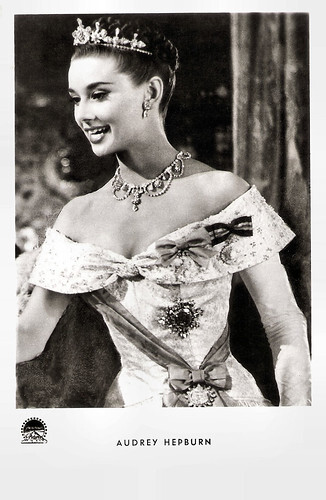
German postcard by Kunst und Bild, Berlin, no. A 1031. Photo: Paramount. Audrey Hepburn in Roman Holiday (William Wyler, 1953).
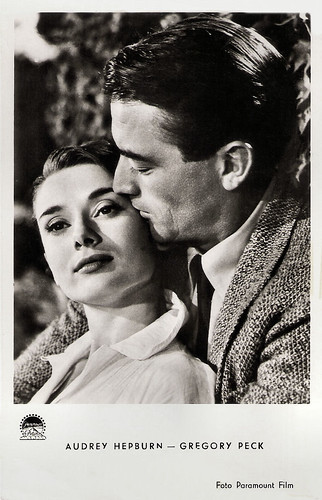
German postcard by Kunst und Bild, Berlin, no. A 1079. Photo: Paramount. Audrey Hepburn and Gregory Peck in Roman Holiday (William Wyler, 1953).
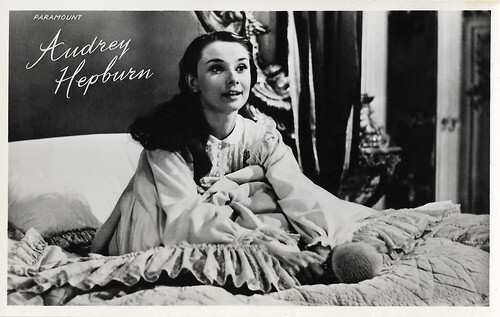
Dutch postcard by Takken / 't Sticht, Utrecht, no. 1469. Photo: Paramount. Audrey Hepburn in Roman Holiday (William Wyler, 1953).
Having a wonderful, romantic time together
Audrey Hepburn plays Princess Ann, a young princess who is on an exhausting tour of European capitals with her entourage. This is how she ends up at the embassy in Rome. She is tired and she is fed up with all the handshaking and all the formalities. In the evening, she rebels against protocol. Her doctor gives her an injection of a sedative after which she is left in her room. She manages to escape through the window.
In the nightly streets of Rome, she is found on a bench by Joe Bradley ( Gregory Peck ), a single American journalist living in the city for a while. First, he tries to get her in a taxi towards her house and when that fails, he takes her to his own house, to stay the night at his place.
Only the next day at the newsroom does he realises who he has actually brought into his house. With this great scoop in his hands, he persuades her into a fun 'day of doing nothing' with him. They do all the things that 'normal people' think are ordinary, but are special for a princess. Like going out on a terrace, riding a scooter around town and going to a dance night. During their outing, everything is photographed by Irving Radovich (Eddie Albert), a photographer friend. He uses a mini camera hidden in a lighter for this purpose.
Ann and Bradley are having a wonderful, romantic time together, but how long can it last? When Ann realises that her country is in trouble because of her sudden absence, she decides to return and carry out her duties. The next day, she gives a press conference to talk about her visits. She is advised to say she liked all the cities equally, but steps away from that protocol and calls Rome her best experience. She is surprised to see Joe in the room and is shocked to see Irving taking pictures with his lighter.
In the end, Irving and Joe offer her an envelope with a memento of the city, which contains the photos. Ann understands that their secret will remain secret. In her speech, Ann then says how grateful she is for her beautiful stay in town, but Joe clearly hears in this a packaged message of gratitude to him. Both realise that they feel a lot for each other, but that their love is doomed to remain unfulfilled.
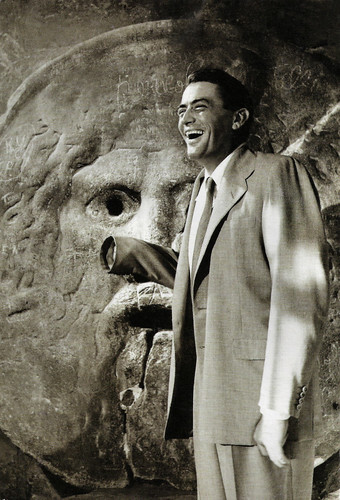
Italian postcard by W. Di Giovanni. Photo: Augusto Di Giovanni. Gregory Peck in Roman Holiday (William Wyler, 1953).
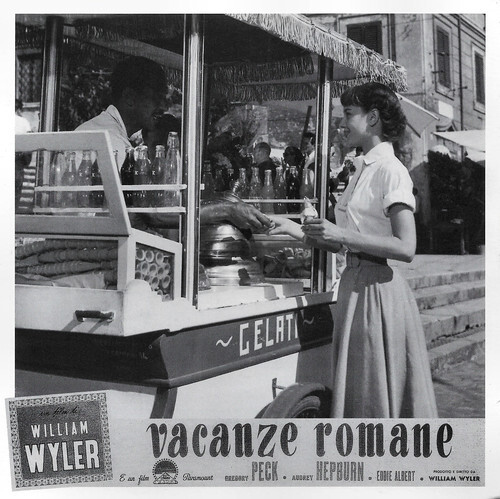
Italian postcard by W. Di Giovanni. Image: Italian lobby card by Paramount with a photo by Augusto Di Giovanni. Audrey Hepburn in Roman Holiday (William Wyler, 1953).
Bitten by the Mouth of Truth
Director Frank Capra toyed with the idea of Roman Holiday back in 1949. It was to be a variation on his successful film It Happened One Night (1934), but this time starring Cary Grant and Elizabeth Taylor. But Capra's production company Liberty Films was in financial trouble after the flop of It's a Wonderful Life. Capra sold Liberty to Paramount Pictures, where screenwriter Dalton Trumbo went to work on the screenplay. Capra withdrew from the film when it turned out that the budget for the film was too tight.
Paramount then sought George Stevens as director, but he also saw little in the production, after which William Wyler was approached. Wyler who had just directed two heavy dramas, The Heiress (1949) and Detective Story(1951), was happy with this lightweight comedy. Wyler suggested to Paramount to shoot the film in Italy. After all, he had no desire to appear before the House Un-American Activities Committee, which was investigating communist infiltration of the film industry and wanted to be far away from Hollywood. It was therefore a wry coincidence that the screenplay's writer, Dalton Trumbo had been blacklisted by the same House Un-American Activities Committee. Trumbo was one of the Hollywood Ten, a group of screenwriters who were banned from working in Hollywood because of alleged communist sympathies.
For this reason, Trumbo's name does not appear in the credits, nor could he receive the Oscar for Best Screenplay. His friend Ian McLellan Hunter got the credits and the Oscar. It was not until 1993 that the widow of Trumbo, who died in 1976, was finally awarded the Oscar. Paramount was initially not happy with the proposal to shoot the film on location. They wanted to shoot everything at the studio in Hollywood. They eventually relented, partly because Paramount could use frozen assets in Europe. However, Wyler was told that the budget was going down and the film had to be shot in black-and-white. With a budget of one and a half million dollars, Wyler went to work.
Initially, Cary Grant had been tapped for the male lead. However, Grant felt too old for the role and he renounced the film. Gregory Peck was interested though, especially since Roman Holiday was a comedy, and Peck had wanted to be in such a film for years. For the role of Princess Ann, they originally had Elizabeth Taylor in mind. However, director William Wyler wanted Jean Simmons for the role. When Simmons was not available, Wyler wanted to cancel the whole project. However, the studio went ahead and the next person approached was Suzanne Cloutier. However, she was also taken. More actresses were tested, but eventually, the role went to the then virtually unknown Audrey Hepburn , despite the fact that her test shot was actually a failure. She acted far too stiff and unnatural. After the audition, however, the camera kept rolling and recorded a relaxed Hepburn who stood talking enthusiastically to the director. It was this 'performance' that ensured Hepburn got the role.
Shooting in Rome was not always easy. It was extremely hot that summer with temperatures exceeding 35 degrees. The heat also rose to the heads of Rome's residents and strikes broke out regularly and film production suffered considerably. Filming was done without cordoning off streets and with the general public as casual extras. On the other hand, there were also fewer casual extras. Members of the Italian nobility figured at the Ambassador's ball (they donated their wages to charity) and members of the real press attended the press conference.
Among all the veterans like Peck and Wyler, debutante Hepburn struggled to find her way. During a take, for instance, she could not produce the tears she wanted. Take after take, the now boiling Wyler spent on his leading actress. He screamed his anger at all the failed shots, to which Hepburn burst into tears. Wyler immediately ran the camera and the scene was on. Gregory Peck had his own method of pulling Hepburn along. When shooting at the Mouth of Truth, Peck's character, Joe, had to put his hand in the mouth of a statue. According to legend, the mouth would bite the hand off if he was a liar. Wyler was keen to get a natural scare reaction from Hepburn and Peck helped him do that. The moment he withdrew his hand he gave a cry of pain and retracted his hand into the sleeve of his jacket. Hepburn knew nothing and her look of horror and surprise was genuine, as was the scream of terror that escaped her. Wyler could be satisfied, he only needed one take.
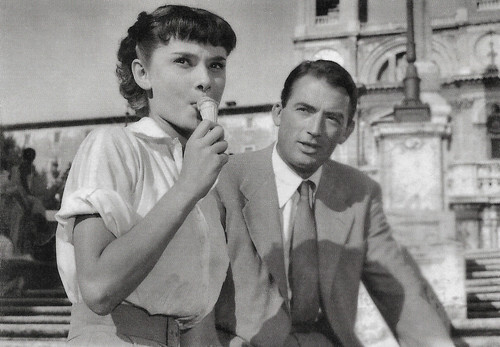
French postcard by Editions Art & Scène, Paris, no. CA 94, 1995, 1995. Photo: Paramount. Audrey Hepburn and Gregory Peck in Roman Holiday (William Wyler, 1953).
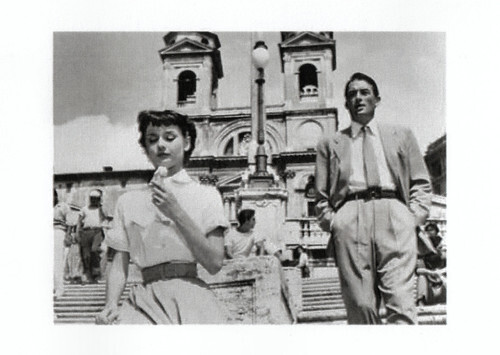
Italian postcard. Photo: Paramount. Audrey Hepburn and Gregory Peck in Roman Holiday (William Wyler, 1953).
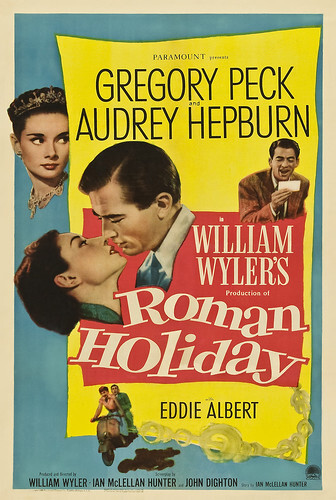
Postcard. Poster for the Paramount film Roman Holiday (William Wyler, 1953).
Sources: Rialto VU, Wikipedia (Dutch) and IMDb

German postcard by Kunst und Bild, Berlin, no. A 1031. Photo: Paramount. Audrey Hepburn in Roman Holiday (William Wyler, 1953).

German postcard by Kunst und Bild, Berlin, no. A 1079. Photo: Paramount. Audrey Hepburn and Gregory Peck in Roman Holiday (William Wyler, 1953).

Dutch postcard by Takken / 't Sticht, Utrecht, no. 1469. Photo: Paramount. Audrey Hepburn in Roman Holiday (William Wyler, 1953).
Having a wonderful, romantic time together
Audrey Hepburn plays Princess Ann, a young princess who is on an exhausting tour of European capitals with her entourage. This is how she ends up at the embassy in Rome. She is tired and she is fed up with all the handshaking and all the formalities. In the evening, she rebels against protocol. Her doctor gives her an injection of a sedative after which she is left in her room. She manages to escape through the window.
In the nightly streets of Rome, she is found on a bench by Joe Bradley ( Gregory Peck ), a single American journalist living in the city for a while. First, he tries to get her in a taxi towards her house and when that fails, he takes her to his own house, to stay the night at his place.
Only the next day at the newsroom does he realises who he has actually brought into his house. With this great scoop in his hands, he persuades her into a fun 'day of doing nothing' with him. They do all the things that 'normal people' think are ordinary, but are special for a princess. Like going out on a terrace, riding a scooter around town and going to a dance night. During their outing, everything is photographed by Irving Radovich (Eddie Albert), a photographer friend. He uses a mini camera hidden in a lighter for this purpose.
Ann and Bradley are having a wonderful, romantic time together, but how long can it last? When Ann realises that her country is in trouble because of her sudden absence, she decides to return and carry out her duties. The next day, she gives a press conference to talk about her visits. She is advised to say she liked all the cities equally, but steps away from that protocol and calls Rome her best experience. She is surprised to see Joe in the room and is shocked to see Irving taking pictures with his lighter.
In the end, Irving and Joe offer her an envelope with a memento of the city, which contains the photos. Ann understands that their secret will remain secret. In her speech, Ann then says how grateful she is for her beautiful stay in town, but Joe clearly hears in this a packaged message of gratitude to him. Both realise that they feel a lot for each other, but that their love is doomed to remain unfulfilled.

Italian postcard by W. Di Giovanni. Photo: Augusto Di Giovanni. Gregory Peck in Roman Holiday (William Wyler, 1953).

Italian postcard by W. Di Giovanni. Image: Italian lobby card by Paramount with a photo by Augusto Di Giovanni. Audrey Hepburn in Roman Holiday (William Wyler, 1953).
Bitten by the Mouth of Truth
Director Frank Capra toyed with the idea of Roman Holiday back in 1949. It was to be a variation on his successful film It Happened One Night (1934), but this time starring Cary Grant and Elizabeth Taylor. But Capra's production company Liberty Films was in financial trouble after the flop of It's a Wonderful Life. Capra sold Liberty to Paramount Pictures, where screenwriter Dalton Trumbo went to work on the screenplay. Capra withdrew from the film when it turned out that the budget for the film was too tight.
Paramount then sought George Stevens as director, but he also saw little in the production, after which William Wyler was approached. Wyler who had just directed two heavy dramas, The Heiress (1949) and Detective Story(1951), was happy with this lightweight comedy. Wyler suggested to Paramount to shoot the film in Italy. After all, he had no desire to appear before the House Un-American Activities Committee, which was investigating communist infiltration of the film industry and wanted to be far away from Hollywood. It was therefore a wry coincidence that the screenplay's writer, Dalton Trumbo had been blacklisted by the same House Un-American Activities Committee. Trumbo was one of the Hollywood Ten, a group of screenwriters who were banned from working in Hollywood because of alleged communist sympathies.
For this reason, Trumbo's name does not appear in the credits, nor could he receive the Oscar for Best Screenplay. His friend Ian McLellan Hunter got the credits and the Oscar. It was not until 1993 that the widow of Trumbo, who died in 1976, was finally awarded the Oscar. Paramount was initially not happy with the proposal to shoot the film on location. They wanted to shoot everything at the studio in Hollywood. They eventually relented, partly because Paramount could use frozen assets in Europe. However, Wyler was told that the budget was going down and the film had to be shot in black-and-white. With a budget of one and a half million dollars, Wyler went to work.
Initially, Cary Grant had been tapped for the male lead. However, Grant felt too old for the role and he renounced the film. Gregory Peck was interested though, especially since Roman Holiday was a comedy, and Peck had wanted to be in such a film for years. For the role of Princess Ann, they originally had Elizabeth Taylor in mind. However, director William Wyler wanted Jean Simmons for the role. When Simmons was not available, Wyler wanted to cancel the whole project. However, the studio went ahead and the next person approached was Suzanne Cloutier. However, she was also taken. More actresses were tested, but eventually, the role went to the then virtually unknown Audrey Hepburn , despite the fact that her test shot was actually a failure. She acted far too stiff and unnatural. After the audition, however, the camera kept rolling and recorded a relaxed Hepburn who stood talking enthusiastically to the director. It was this 'performance' that ensured Hepburn got the role.
Shooting in Rome was not always easy. It was extremely hot that summer with temperatures exceeding 35 degrees. The heat also rose to the heads of Rome's residents and strikes broke out regularly and film production suffered considerably. Filming was done without cordoning off streets and with the general public as casual extras. On the other hand, there were also fewer casual extras. Members of the Italian nobility figured at the Ambassador's ball (they donated their wages to charity) and members of the real press attended the press conference.
Among all the veterans like Peck and Wyler, debutante Hepburn struggled to find her way. During a take, for instance, she could not produce the tears she wanted. Take after take, the now boiling Wyler spent on his leading actress. He screamed his anger at all the failed shots, to which Hepburn burst into tears. Wyler immediately ran the camera and the scene was on. Gregory Peck had his own method of pulling Hepburn along. When shooting at the Mouth of Truth, Peck's character, Joe, had to put his hand in the mouth of a statue. According to legend, the mouth would bite the hand off if he was a liar. Wyler was keen to get a natural scare reaction from Hepburn and Peck helped him do that. The moment he withdrew his hand he gave a cry of pain and retracted his hand into the sleeve of his jacket. Hepburn knew nothing and her look of horror and surprise was genuine, as was the scream of terror that escaped her. Wyler could be satisfied, he only needed one take.

French postcard by Editions Art & Scène, Paris, no. CA 94, 1995, 1995. Photo: Paramount. Audrey Hepburn and Gregory Peck in Roman Holiday (William Wyler, 1953).

Italian postcard. Photo: Paramount. Audrey Hepburn and Gregory Peck in Roman Holiday (William Wyler, 1953).

Postcard. Poster for the Paramount film Roman Holiday (William Wyler, 1953).
Sources: Rialto VU, Wikipedia (Dutch) and IMDb
Published on December 06, 2022 22:00
December 5, 2022
Lia Formia
Italian actress Lia Formia appeared in 20 silent films between 1918 and 1925. For years she was the leading actress of director Lucio D'Ambra.
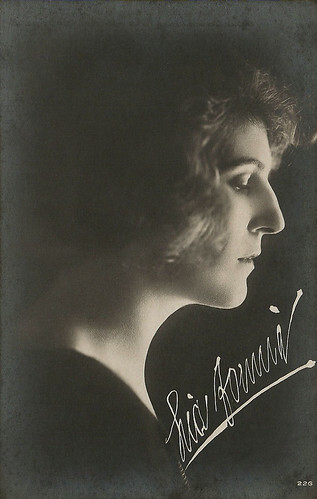
Italian postcard, no. 226. Collection: Didier Hanson.
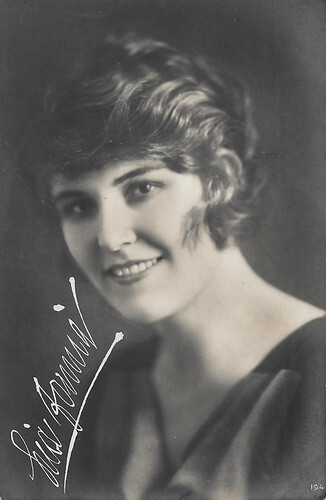
Italian postcard by Fotocelere, Turin, no. 194.
A lovely, humorous and action-packed spoof
Lia Formia was born in Naples, her birth date is unknown. She probably made her film debut in Le figlie del mare/The daughters of the sea (Luigi Caramba, 1918).
From 1920 on Formia played for years under the direction of Lucio D'Ambra, mostly with Umberto Zanuccoli as her male co-actor. Probably her first film with D'Ambra was La storia della dama dal ventaglio bianco/The story of the lady with the white fan (Lucio D'Ambra, 1920), the story about a woman of easy virtues as soon as her husband is away. Formia already had the female lead in the film.
She played then the lead roles in Due sogni ad occhi aperti/Two dreams with eyes wide open (Lucio D'Ambra, 1921), La fine dell'amore (Gian Bistolfi, 1921), Gli angeli custodi/The guardian angels (Lucio D'Ambra, 1922), Crocetta d'oro/The little golden cross (Lucio D'Ambra, 1922), and La sentinella morta/The dead sentinel (Gian Bistolfi, 1922).
L'illustre attrice Cicala Formica/The Illustrious Actress Cicada Ant (D'Ambra 1920) was a short fantasy, perhaps intended to be released together with La favola di La Fontaine (Lucio D'Ambra 1921). The film parodied divismo and still exists, as one of the few films of D'Ambra and Formia found and restored. Angela Dalle Vacche: "The film is a lovely, humorous and action-packed spoof about a young woman (Lia Formia) who wants to be both a director and a diva."
In the end, she fails and the rebellious daughter is tamed by her father. Other films Formia made in the same year were Miss Dorothy (Giulio Antamoro, 1921) starring Diana Karenne and with Romano Calò, Carmen Boni and Formia co-acting, and La falsa amante/The false lover (Carmine Gallone, 1921), starring Formia herself and based on a novel by Honoré de Balzac.
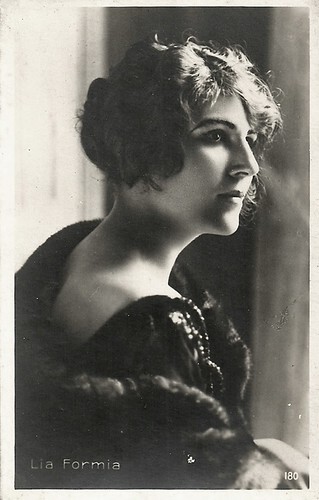
Italian postcard by Ed. Vettori, Bologna, no. 180.
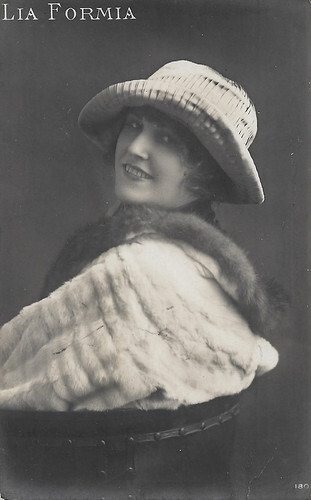
Italian postcard by Fotocelere, Turin, no. 180.
The bankruptcy of D’Ambra Film
Lia Formia kept very busy in the early 1920s. In 1921 she starred in such silent films as Le confessioni di un figlio del secolo/Confessions of a son of the century (Gian Bistolfi, 1921), Il granatiere di Pomerania/The Pomeranian grenadier (Lucio D'Ambra, 1921), and Monique (Lucio D'Ambra, 1921).
In the following year, she could be seen in La favola di La Fontaine/The fable of La Fontaine (Lucio D'Ambra, 1922), Il miraggio/The mirage (1921, Lucio D'Ambra), La principessa Bébé (Lucio D'Ambra or Carmine Gallone, 1921), all produced by D’Ambra Film.
For the same studio, she appeared in S. E. l'Ambasciatrice/S. E. Ambassador (Lucio D'Ambra, Carmine Gallone, 1922) and Tragedia su tre carte/Tragedy in three papers (Lucio D'Ambra). Then D’Ambra Film probably went bankrupt in the crisis of the Italian film industry.
Lia Formia made only one more film, apart from a bit part in La via del peccato (Amleto Palermi, 1925). In 1925 she appeared in Il tacchino/The turkey (Mario Bonnard, 1925), co-starring Mario Bonnard himself, the French comedian Marcel Lévesque and Maryse Dauvray, the actress from J'accuse. It was an adaptation of the Georges Feydeau comedy 'Le Dindon'. Though the film was internationally successful, Lia Formia's career stopped after 20 films.
About the later life of Lia Formia nor about the place or date of her death, we could not find any information on the net. Do you know more about this Italian actress? Please write a comment and share.
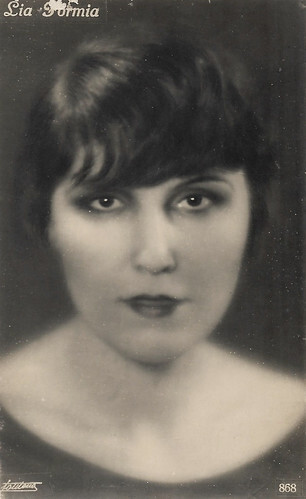
Italian postcard by Ed. A. Traldi, Milano, no. 868. Photo: Fontana.
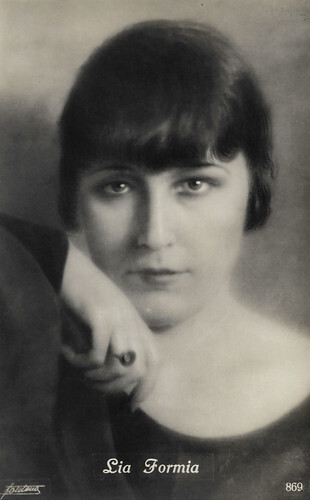
Italian postcard by Ed. A. Traldi, Milano, no. 869. Photo: Fontana.
Sources: Vittorio Martinelli (Il cinema muto italiano - Italian), Angela dalle Vacche (Diva: defiance and passion in early Italian cinema), Andrea Meneghelli (Lucio D'Ambra: ipotesi per un'indagine isocronica, in Fotogenia 1997-1998 - Italian), and .

Italian postcard, no. 226. Collection: Didier Hanson.

Italian postcard by Fotocelere, Turin, no. 194.
A lovely, humorous and action-packed spoof
Lia Formia was born in Naples, her birth date is unknown. She probably made her film debut in Le figlie del mare/The daughters of the sea (Luigi Caramba, 1918).
From 1920 on Formia played for years under the direction of Lucio D'Ambra, mostly with Umberto Zanuccoli as her male co-actor. Probably her first film with D'Ambra was La storia della dama dal ventaglio bianco/The story of the lady with the white fan (Lucio D'Ambra, 1920), the story about a woman of easy virtues as soon as her husband is away. Formia already had the female lead in the film.
She played then the lead roles in Due sogni ad occhi aperti/Two dreams with eyes wide open (Lucio D'Ambra, 1921), La fine dell'amore (Gian Bistolfi, 1921), Gli angeli custodi/The guardian angels (Lucio D'Ambra, 1922), Crocetta d'oro/The little golden cross (Lucio D'Ambra, 1922), and La sentinella morta/The dead sentinel (Gian Bistolfi, 1922).
L'illustre attrice Cicala Formica/The Illustrious Actress Cicada Ant (D'Ambra 1920) was a short fantasy, perhaps intended to be released together with La favola di La Fontaine (Lucio D'Ambra 1921). The film parodied divismo and still exists, as one of the few films of D'Ambra and Formia found and restored. Angela Dalle Vacche: "The film is a lovely, humorous and action-packed spoof about a young woman (Lia Formia) who wants to be both a director and a diva."
In the end, she fails and the rebellious daughter is tamed by her father. Other films Formia made in the same year were Miss Dorothy (Giulio Antamoro, 1921) starring Diana Karenne and with Romano Calò, Carmen Boni and Formia co-acting, and La falsa amante/The false lover (Carmine Gallone, 1921), starring Formia herself and based on a novel by Honoré de Balzac.

Italian postcard by Ed. Vettori, Bologna, no. 180.

Italian postcard by Fotocelere, Turin, no. 180.
The bankruptcy of D’Ambra Film
Lia Formia kept very busy in the early 1920s. In 1921 she starred in such silent films as Le confessioni di un figlio del secolo/Confessions of a son of the century (Gian Bistolfi, 1921), Il granatiere di Pomerania/The Pomeranian grenadier (Lucio D'Ambra, 1921), and Monique (Lucio D'Ambra, 1921).
In the following year, she could be seen in La favola di La Fontaine/The fable of La Fontaine (Lucio D'Ambra, 1922), Il miraggio/The mirage (1921, Lucio D'Ambra), La principessa Bébé (Lucio D'Ambra or Carmine Gallone, 1921), all produced by D’Ambra Film.
For the same studio, she appeared in S. E. l'Ambasciatrice/S. E. Ambassador (Lucio D'Ambra, Carmine Gallone, 1922) and Tragedia su tre carte/Tragedy in three papers (Lucio D'Ambra). Then D’Ambra Film probably went bankrupt in the crisis of the Italian film industry.
Lia Formia made only one more film, apart from a bit part in La via del peccato (Amleto Palermi, 1925). In 1925 she appeared in Il tacchino/The turkey (Mario Bonnard, 1925), co-starring Mario Bonnard himself, the French comedian Marcel Lévesque and Maryse Dauvray, the actress from J'accuse. It was an adaptation of the Georges Feydeau comedy 'Le Dindon'. Though the film was internationally successful, Lia Formia's career stopped after 20 films.
About the later life of Lia Formia nor about the place or date of her death, we could not find any information on the net. Do you know more about this Italian actress? Please write a comment and share.

Italian postcard by Ed. A. Traldi, Milano, no. 868. Photo: Fontana.

Italian postcard by Ed. A. Traldi, Milano, no. 869. Photo: Fontana.
Sources: Vittorio Martinelli (Il cinema muto italiano - Italian), Angela dalle Vacche (Diva: defiance and passion in early Italian cinema), Andrea Meneghelli (Lucio D'Ambra: ipotesi per un'indagine isocronica, in Fotogenia 1997-1998 - Italian), and .
Published on December 05, 2022 22:00
December 4, 2022
Monsieur Beaucaire (1924)
This post is the first of three film specials on the work of Rudolph Valentino. Monsieur Beaucaire (1924) is an American silent romantic historical drama in which Valentino co-starred with Bebe Daniels and Lois Wilson. For Valentino, this film heralded his return to the big screen after a two-year absence. The film sets and costumes were designed by his wife Natacha Rambova. Produced and directed by Sidney Olcott, the film is based on Pulitzer Prize-winning author Booth Tarkington's 1900 novel of the same name and the 1904 play of the same name by Tarkington and Evelyn Greenleaf Sutherland.

French postcard by Cinémagazine-Édition, no. 23. Paramount. Photo: Rudolph Valentino and Doris Kenyon in Monsieur Beaucaire (Sidney Olcott, 1924).
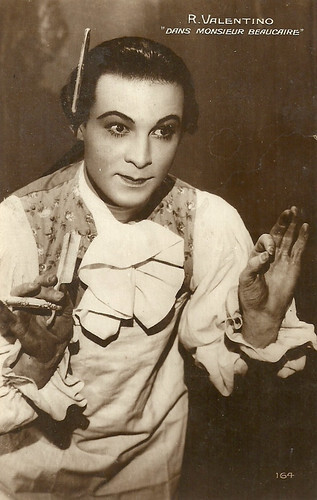
French postcard by Cinémagazine-Édition, no. 164. Photo: Rudolph Valentino in Monsieur Beaucaire (Sidney Olcott, 1924).
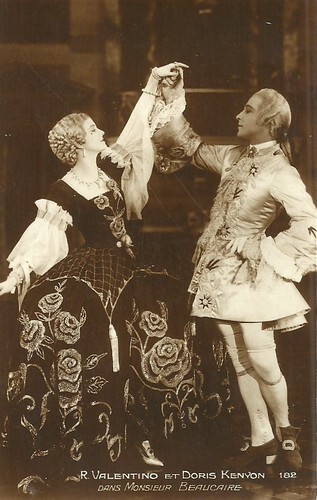
French postcard by Cinémagazine-Édition, no. 182. Rudolph Valentino and Doris Kenyon in Monsieur Beaucaire (Sidney Olcott, 1924).
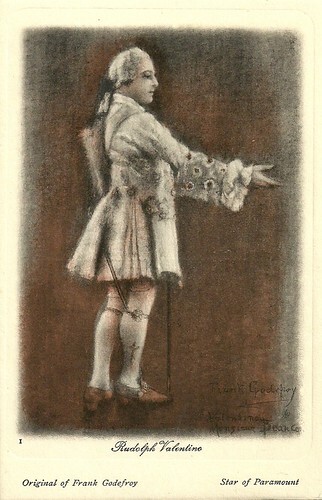
Dutch postcard by J.[Jos] M.H. Nuss, Laren, no. 1. Rudolph Valentino in Monsieur Beaucaire (Sidney Olcott 1924). Picture: Frank Godefroy. Paramount.
Humiliated and insulted he flees to England
'Monsieur Beaucaire' is a short novel by Pulitzer Prize-winning author Booth Tarkington that was first published in 1900. The story has been adapted several times. In collaboration with Evelyn Greenleaf Sutherland, Tarkington adapted it as a play in 1904 starring Evelyn Millard and Lewis Waller .
The play received a Royal Command Performance at Windsor Castle before Edward VII. André Messager used it as the basis for an opera of the same name in 1919. Tarkington was credited as co-author of the screenplay of the 1924 film adaptation which starred Rudolph Valentino .
The Duke of Chartres ( Rudolph Valentino ), a favourite at the court of France's King Louis XV (Lowell Sherman), has fallen in love with Princess Henriette ( Bebe Daniels ), who, to his greatest regret, does not seem interested in him. Rather, she continually humiliates and insults him out of jealousy, whereupon he flees to England, banished by the king. But Louis XV insists that the two marry each other. As a result, His Highness leaves his high noble existence and becomes a bourgeois.
As Monsieur Beaucaire, he advances to become the barber of the French ambassador in London and begins to enjoy life beyond aristocratic obligations. After catching the British Duke of Winterset (Ian McLaren) cheating at cards, he forces Winterset in sneaking Beaucaire into a great ball, disguised as the Duke de Chartres, and to introduce him to the beautiful Lady Mary (Doris Kenyon), whom he adores.
Winterset complies with this blackmail but secretly seeks revenge in order to expose the suspected barber to ridicule. He makes Lady Mary believe that the supposed nobleman introduced to her has to eke out a living as a barber. As a result, the smug British woman abruptly loses interest in the French beau.
Eventually, however, she learns that the barber she has spurned is in fact the Duke of Chartres and now tries to win him back with the weapons of a woman. But the Duke of Chartres returns to France, where Princess Henriette, who had secretly pursued his return to the French court, finally begins to reciprocate his affection.
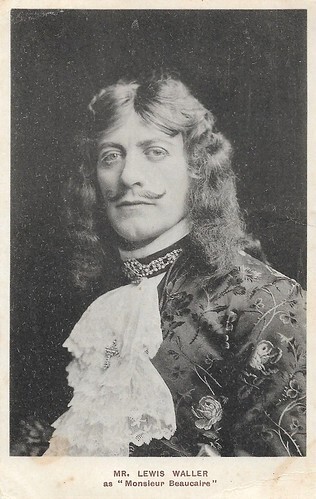
British postcard. Photo: Lewis Waller in the tile role of the stage play 'Monsieur Beaucaire'.
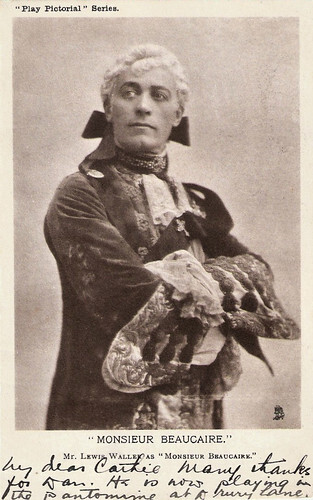
British postcard by Raphael Tuck & Sons in the Play Pictorial Series, nr. 5A. Photo: Lewis Waller as Monsieur Beaucaire in the stage play 'Monsieur Beaucaire'.
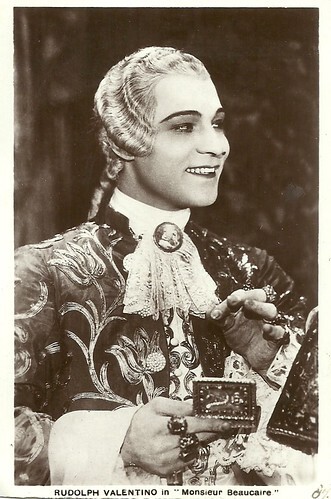
British postcard. Rudolph Valentino in Monsieur Beaucaire (Sidney Olcott 1924).
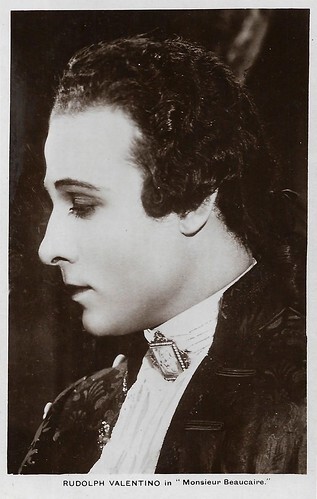
British postcard in the Picturegoer Series, London, no. 193. Rudolph Valentino in Monsieur Beaucaire (Sidney Olcott, 1924).
Part of a series of box office and critical disappointments
Monsieur Beaucaire (Sidney Olcott, 1924) was produced by Famous Players-Lasky and distributed by Paramount Pictures. It was filmed at Kaufman Astoria Studios in New York City.
The action is set at the court of King Louis XV of France. Therefore Olcott chose the atmosphere to be resolutely French and French-speaking. It is French dancer Paulette Duval's second American picture. The Belgian André Daven, who plays the brother of Valentino's character, was hired for his resemblance to the Latin lover. The Nantes-based Georges Barbier designed the 350 costumes. The film's dialogues were written in French for more realism. Valentino speaks French, as do Bebe Daniels , Lowell Sherman and Sidney Olcott.
Monsieur Beaucaire was part of a series of box office and critical disappointments that plagued Valentino's mid-career. Although the film did fairly well in big cities, it flopped in smaller locales, and could not exceed the expensive budget Olcott put into the film's production. Historians Kevin Brownlow and John Kobal suggested that the film's shortcomings stemmed more from Olcott's "pedestrian" direction.
Many viewers and critics, perhaps expecting the more virile Valentino of his earlier films, felt that his onscreen persona with its heavy makeup, frilled attire, and arch mannerisms (particularly in the first half) was overly feminised in Monsieur Beaucaire: a somewhat unfair accusation, considering that much of the film satirises the excesses of the court of Louis XV.
Much of the blame for the film's alleged shortcomings was assigned to Valentino's wife Natacha Rambova who was felt by many of Valentino's colleagues to have had an undue influence on the costumes, set and direction of the film. Alicia Annas wrote that audiences were most likely alienated by the general design of the film which, while historically accurate, was not tailored to 1920s American filmgoers' tastes. The Stan Laurel parody Monsieur Don't Care (Scott Pembroke, Joe Rock, 1924) reflected the general public attitude toward Monsieur Beaucaire.
The novel 'Monsieur Beaucaire' was later adapted into a musical film, Monte Carlo (1930), directed by Ernst Lubitsch . The story was filmed again as a comedy, Monsieur Beaucaire (George Marshall, 1946) starring Bob Hope and Joan Caulfield. The biopic Valentino (Lewis Allen, 1951) with Anthony Dexter, includes a sequence dedicated to Monsieur Beaucaire. A long sequence dedicated to Monsieur Beaucaire also appears in the film Valentino (Ken Russell, 1977), with Rudolf Nureyev in the title role and John Justin in the role of Sidney Olcott.
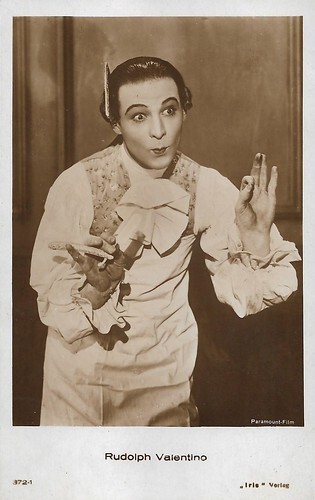
Austrian postcard by Iris Verlag, no. 372/1. Photo: Paramount-Film. Photo: Rudolph Valentino in Monsieur Beaucaire (Sidney Olcott, 1924).
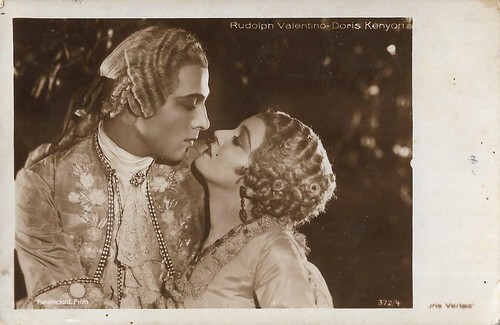
Austrian postcard by Iris Verlag, no. 372/4. Photo: Paramount-Film. Rudolph Valentino and Doris Kenyon in Monsieur Beaucaire (Sidney Olcott, 1924).
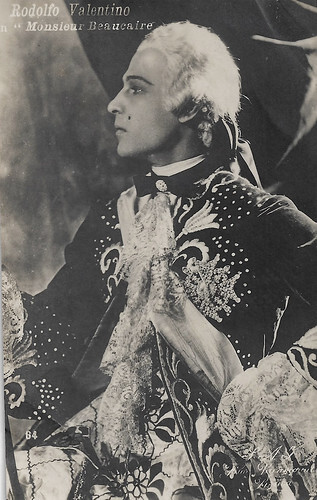
Italian postcard by Ed. Ballerini & Fratini, Florence, no. 64. Photo: SAI Films Paramount, Roma. Rudolph Valentino in Monsieur Beaucaire (Sidney Olcott, 1924).
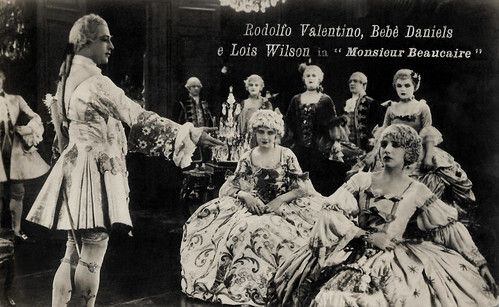
Italian postcard by Ed. Ballerini & Fratini, Firenze. Photo: Rudolph Valentino , Lois Wilson and Bebe Daniels in Monsieur Beaucaire (Sidney Olcott, 1924).
Sources: Wikipedia (English and German), and IMDb.

French postcard by Cinémagazine-Édition, no. 23. Paramount. Photo: Rudolph Valentino and Doris Kenyon in Monsieur Beaucaire (Sidney Olcott, 1924).

French postcard by Cinémagazine-Édition, no. 164. Photo: Rudolph Valentino in Monsieur Beaucaire (Sidney Olcott, 1924).

French postcard by Cinémagazine-Édition, no. 182. Rudolph Valentino and Doris Kenyon in Monsieur Beaucaire (Sidney Olcott, 1924).

Dutch postcard by J.[Jos] M.H. Nuss, Laren, no. 1. Rudolph Valentino in Monsieur Beaucaire (Sidney Olcott 1924). Picture: Frank Godefroy. Paramount.
Humiliated and insulted he flees to England
'Monsieur Beaucaire' is a short novel by Pulitzer Prize-winning author Booth Tarkington that was first published in 1900. The story has been adapted several times. In collaboration with Evelyn Greenleaf Sutherland, Tarkington adapted it as a play in 1904 starring Evelyn Millard and Lewis Waller .
The play received a Royal Command Performance at Windsor Castle before Edward VII. André Messager used it as the basis for an opera of the same name in 1919. Tarkington was credited as co-author of the screenplay of the 1924 film adaptation which starred Rudolph Valentino .
The Duke of Chartres ( Rudolph Valentino ), a favourite at the court of France's King Louis XV (Lowell Sherman), has fallen in love with Princess Henriette ( Bebe Daniels ), who, to his greatest regret, does not seem interested in him. Rather, she continually humiliates and insults him out of jealousy, whereupon he flees to England, banished by the king. But Louis XV insists that the two marry each other. As a result, His Highness leaves his high noble existence and becomes a bourgeois.
As Monsieur Beaucaire, he advances to become the barber of the French ambassador in London and begins to enjoy life beyond aristocratic obligations. After catching the British Duke of Winterset (Ian McLaren) cheating at cards, he forces Winterset in sneaking Beaucaire into a great ball, disguised as the Duke de Chartres, and to introduce him to the beautiful Lady Mary (Doris Kenyon), whom he adores.
Winterset complies with this blackmail but secretly seeks revenge in order to expose the suspected barber to ridicule. He makes Lady Mary believe that the supposed nobleman introduced to her has to eke out a living as a barber. As a result, the smug British woman abruptly loses interest in the French beau.
Eventually, however, she learns that the barber she has spurned is in fact the Duke of Chartres and now tries to win him back with the weapons of a woman. But the Duke of Chartres returns to France, where Princess Henriette, who had secretly pursued his return to the French court, finally begins to reciprocate his affection.

British postcard. Photo: Lewis Waller in the tile role of the stage play 'Monsieur Beaucaire'.

British postcard by Raphael Tuck & Sons in the Play Pictorial Series, nr. 5A. Photo: Lewis Waller as Monsieur Beaucaire in the stage play 'Monsieur Beaucaire'.

British postcard. Rudolph Valentino in Monsieur Beaucaire (Sidney Olcott 1924).

British postcard in the Picturegoer Series, London, no. 193. Rudolph Valentino in Monsieur Beaucaire (Sidney Olcott, 1924).
Part of a series of box office and critical disappointments
Monsieur Beaucaire (Sidney Olcott, 1924) was produced by Famous Players-Lasky and distributed by Paramount Pictures. It was filmed at Kaufman Astoria Studios in New York City.
The action is set at the court of King Louis XV of France. Therefore Olcott chose the atmosphere to be resolutely French and French-speaking. It is French dancer Paulette Duval's second American picture. The Belgian André Daven, who plays the brother of Valentino's character, was hired for his resemblance to the Latin lover. The Nantes-based Georges Barbier designed the 350 costumes. The film's dialogues were written in French for more realism. Valentino speaks French, as do Bebe Daniels , Lowell Sherman and Sidney Olcott.
Monsieur Beaucaire was part of a series of box office and critical disappointments that plagued Valentino's mid-career. Although the film did fairly well in big cities, it flopped in smaller locales, and could not exceed the expensive budget Olcott put into the film's production. Historians Kevin Brownlow and John Kobal suggested that the film's shortcomings stemmed more from Olcott's "pedestrian" direction.
Many viewers and critics, perhaps expecting the more virile Valentino of his earlier films, felt that his onscreen persona with its heavy makeup, frilled attire, and arch mannerisms (particularly in the first half) was overly feminised in Monsieur Beaucaire: a somewhat unfair accusation, considering that much of the film satirises the excesses of the court of Louis XV.
Much of the blame for the film's alleged shortcomings was assigned to Valentino's wife Natacha Rambova who was felt by many of Valentino's colleagues to have had an undue influence on the costumes, set and direction of the film. Alicia Annas wrote that audiences were most likely alienated by the general design of the film which, while historically accurate, was not tailored to 1920s American filmgoers' tastes. The Stan Laurel parody Monsieur Don't Care (Scott Pembroke, Joe Rock, 1924) reflected the general public attitude toward Monsieur Beaucaire.
The novel 'Monsieur Beaucaire' was later adapted into a musical film, Monte Carlo (1930), directed by Ernst Lubitsch . The story was filmed again as a comedy, Monsieur Beaucaire (George Marshall, 1946) starring Bob Hope and Joan Caulfield. The biopic Valentino (Lewis Allen, 1951) with Anthony Dexter, includes a sequence dedicated to Monsieur Beaucaire. A long sequence dedicated to Monsieur Beaucaire also appears in the film Valentino (Ken Russell, 1977), with Rudolf Nureyev in the title role and John Justin in the role of Sidney Olcott.

Austrian postcard by Iris Verlag, no. 372/1. Photo: Paramount-Film. Photo: Rudolph Valentino in Monsieur Beaucaire (Sidney Olcott, 1924).

Austrian postcard by Iris Verlag, no. 372/4. Photo: Paramount-Film. Rudolph Valentino and Doris Kenyon in Monsieur Beaucaire (Sidney Olcott, 1924).

Italian postcard by Ed. Ballerini & Fratini, Florence, no. 64. Photo: SAI Films Paramount, Roma. Rudolph Valentino in Monsieur Beaucaire (Sidney Olcott, 1924).

Italian postcard by Ed. Ballerini & Fratini, Firenze. Photo: Rudolph Valentino , Lois Wilson and Bebe Daniels in Monsieur Beaucaire (Sidney Olcott, 1924).
Sources: Wikipedia (English and German), and IMDb.
Published on December 04, 2022 22:00
December 3, 2022
Mylène Demongeot (1936-2022)
On 1 December 2022, beautiful and talented Mylène Demongeot (1936) passed away in Paris. In 1957, she became one of the blond sex symbols of the French cinema when she seduced Yves Montand in Les sorcières de Salem/The Crucible. The coquettish French actress would go on to co-star in the three Fantômas adventures and many other European films of the 1950s and 1960s. In the 1980s she also became a producer. Demongeot was 87.
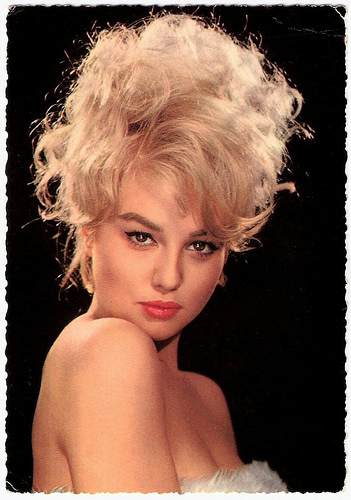
German postcard by Kruger, no. 902/162.
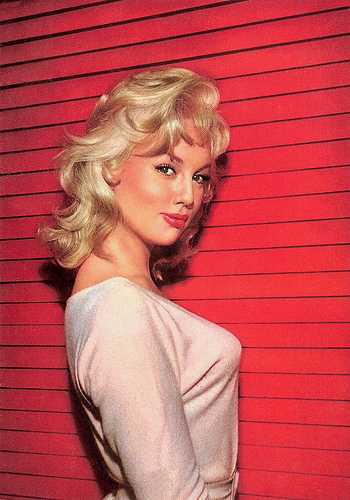
French postcard by Editions P.I., Paris, no. 1066. Photo: Dimitri/Dalmas.
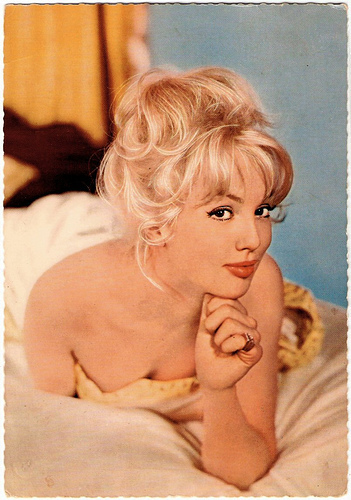
German postcard by Kruger, no. 902/76.
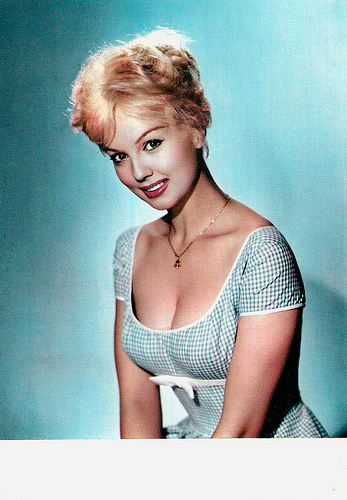
French postcard by Editions P.I., Paris, no. 1014. Photo: Sam Lévin.
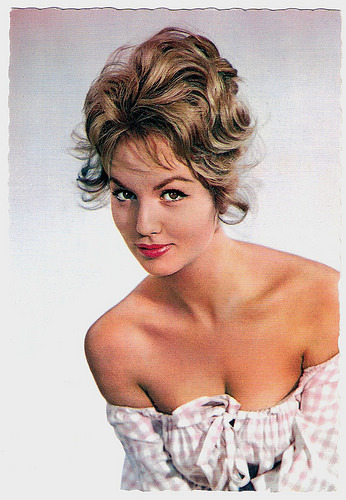
French postcard by E.D.U.G., no. 143. Photo: Sam Lévin.
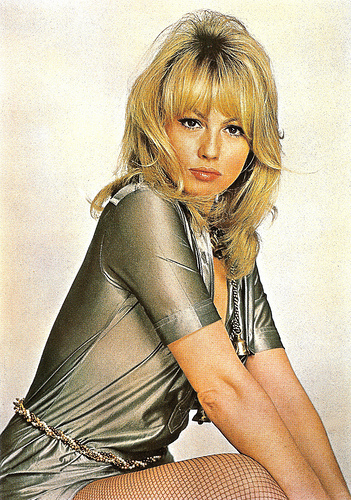
French postcard by E.D.U.G., no. 501. Photo: Sam Lévin.
Seduction Scene
Marie-Helene Demongeot was born in Nice, France in 1935 into a family of actors. Her parents met in Shanghai, China, and moved to Nice, France.
Her mother, Klaudia Trubnikova, was a Russian-Ukrainian emigre from Kharkiv who escaped from the horrors of the Russian Civil War. Her father, Alfred Demongeot, was of French-Italian heritage. The family was bilingual and young Demongeot was able to use Russian and French, but eventually switched to French. She grew up in Nice.
After the war, at 13 she went to Paris and continued her education there. She studied piano under the tutelage of Marguerite Long and Yves Nat. At the age of 15, she became a model in the atelier of Pierre Cardin and studied dramatic art with Marie Ventura at Le Cours Simon in Paris.
Two years later she made her film debut with a supporting role in Les enfants de l'amour/Children of Love (Léonide Moguy, 1953) starring Etchika Choureau .
More small roles followed in Futures Vedettes/Joy of Living (Marc Allégret, 1955) with Brigitte Bardot , and the British musical comedy It's a Wonderful World (Val Guest, 1956).
Then she had her breakthrough at the side of Yves Montand and Simone Signoret with a memorable seduction scene in Les sorcières de Salem/The Crucible (Raymond Rouleau, 1957), based on the play by Arthur Miller.
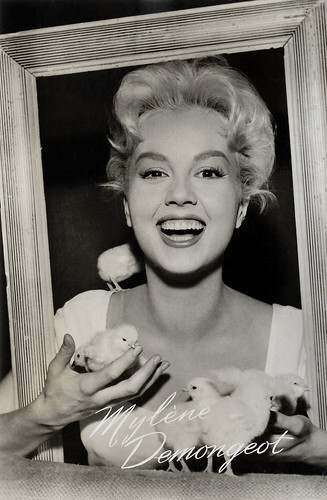
Dutch postcard by Uitg. Takken, Utrecht, no. AX 3864.
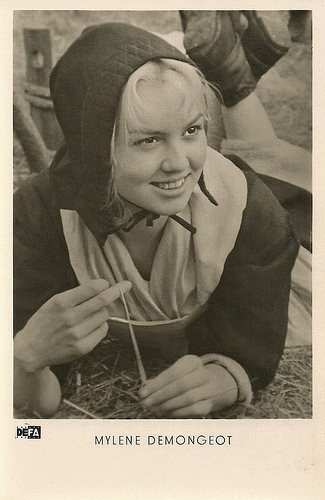
West German postcard. Photo: DEFA. Publicity still for Les sorcières de Salem (1957).
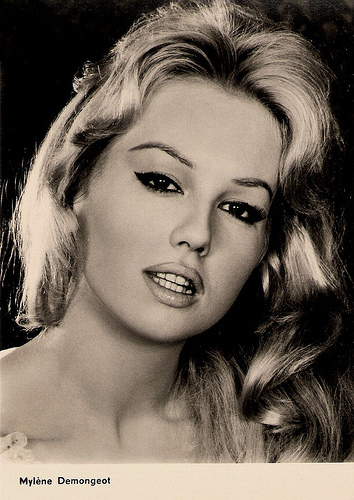
East German postcard by VEB Progress Film-Vertrieb, Berlin, no. 1852, 1963. Retail Price: 0,20 DM. Photo: Progress.
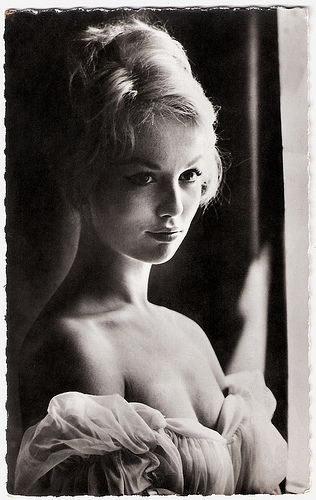
French postcard by Editions P.I., Paris, no. 1039, offered by Les Carbones Korès 'Carboplane. Photo: H. Coste.
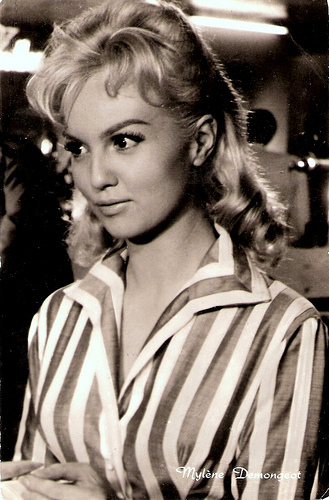
Dutch postcard by IFP, Amsterdam, no. 3014.
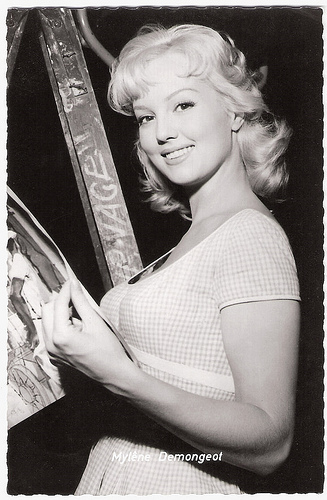
West German postcard by Kolibri-Verlag G.m.b.H, Minden/Westf. Sent by mail in the Netherlands in 1964.
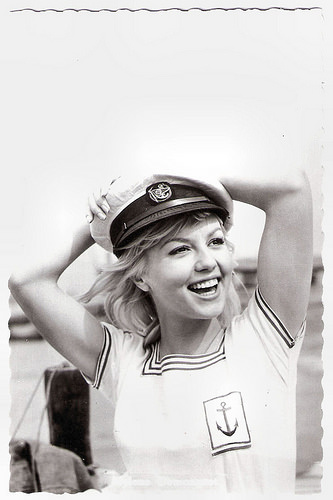
Dutch postcard by Uitg. N.V. v.h. Weenenk & Snel, Baarn, no. 133.
Manipulative but humorous
With appearances in three or four feature films yearly, Mylène Demongeot would rise to international fame in the late 1950s.
Demongeot's first notable leading role was in Sois belle et tais-toi/Be Beautiful But Shut Up (Marc Allégret, 1958) opposite Henri Vidal , where she played a 17-year-old jewel smuggler.
She further developed her screen image of a manipulative but humorous blond mistress opposite David Niven in Bonjour tristesse (Otto Preminger, 1958), and opposite Alain Delon in the comedy Faibles femmes/Three Murderesses (Michel Boisrond, 1959).
Many of her screen assignments were along the ooh-la-la lines of her Swedish maid in the British Upstairs and Downstairs (Ralph Thomas, 1959).
In Italy, she played opposite Steve Reeves in the Peplum (sword and sandal epic) La battaglia di Maratona/Giant of Marathon (Jacques Tourneur, 1959), with Rosanna Schiaffino and Elsa Martinelli in La notte brava/Bad Girls Don't Cry (Mauro Bolognini, 1959) based on a script by Pier Paolo Pasolini, again with Elsa Martinelli in the comedy Un amore a Roma/Love in Rome (Dino Risi, 1960) and with Roger Moore in Il ratto delle sabine/Romulus and the Sabines (Richard Pottier, 1961).
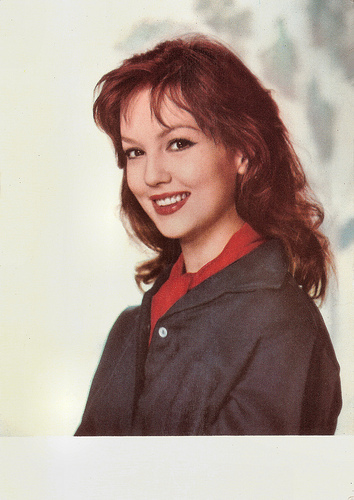
French postcard by Editions P.I., Paris, no. 1022. Photo: Sam Lévin.
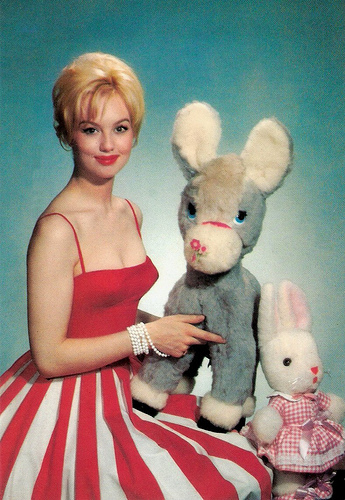
Spanish postcard by Oscarcolor, no. 266.
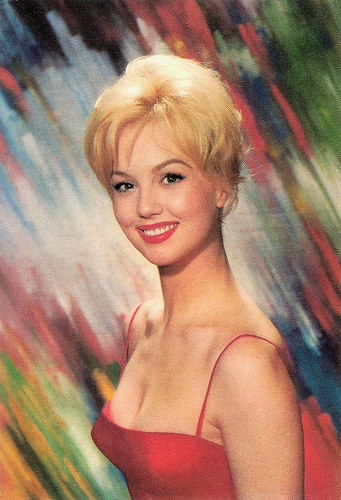
Spanish postcard by Oscarcolor, no. 268.
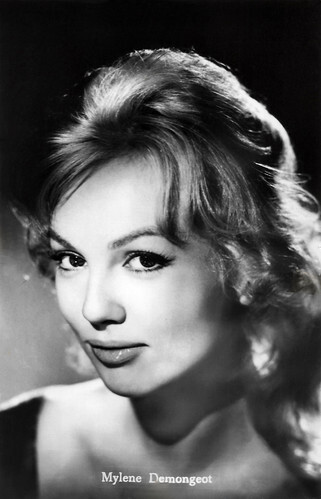
Dutch postcard by Hercules, Haarlem, no. 129. Photo: Rank. Publicity still for Upstairs and Downstairs (Ralph Thomas, 1959).
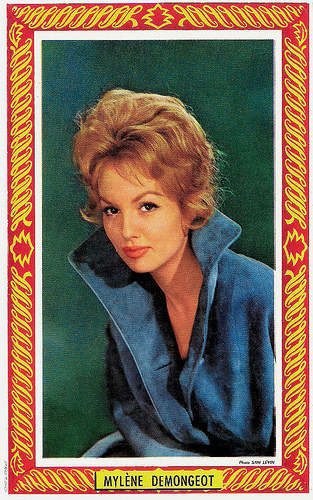
French postcard by St. Anne, Marseille. Photo: Sam Lévin.
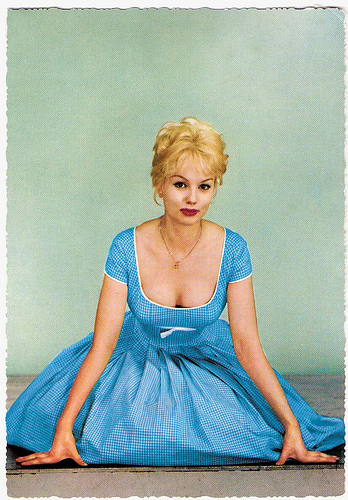
German postcard by Krüger, no. 902/41. Photo: Sam Lévin.
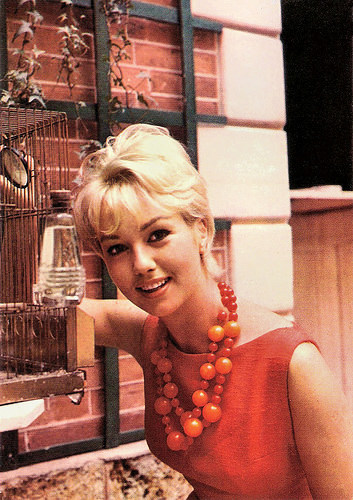
French postcard by Editions Borde, Paris, no. 130. Photo: Morel.
Milady de Winter
Among Mylène Demongeot's best-known film works are the role of manipulative Milady de Winter in the two-part adventure film Les trois mousquetaires/The Three Musketeers (Bernard Borderie, 1961) and the role of Helen in the Fantômas trilogy (André Hunebelle, 1964-1967), co-starring with Jean Marais and Louis de Funès .
Other incidental interesting films were À cause, à cause d'une femme (Michel Deville, 1963) with Jacques Charrier , the comedy 12 + 1 (Nicolas Gessner, 1969) with Sharon Tate, and the Canadian drama Quelques arpents de neige/A Few Acres of Snow (Denis Héroux, 1972).
Although she gradually fazed out of her stereotypical image of a beautiful French coquette, she still looked pretty convincing in the image of a mid-aged Madame, which she developed in the 1980s in films like Tenue de soirée/Evening Dress (Bertrand Blier, 1986) starring Gérard Depardieu .
On TV she appeared in the detective series Il professore/Big Man (Steno, 1988-1989) starring Bud Spencer , and in The Man Who Lived at the Ritz (Desmond Davis, 1988).
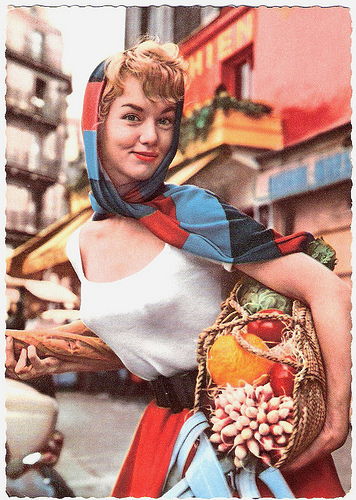
West German postcard by Universum-Film Aktiengesellschaft (UFA), Berlin-Tempelhof, no. CK 150. Retail price: 30 Pfg. Photo: Klaus Collignon / UFA.
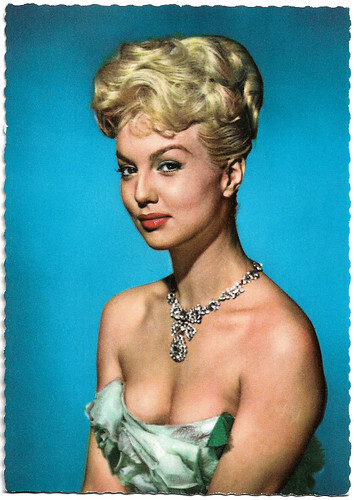
West German postcard by Universum-Film Aktiengesellschaft (UFA), Berlin-Tempelhof, no. CK-196. Photo: Sam Lévin / UFA.
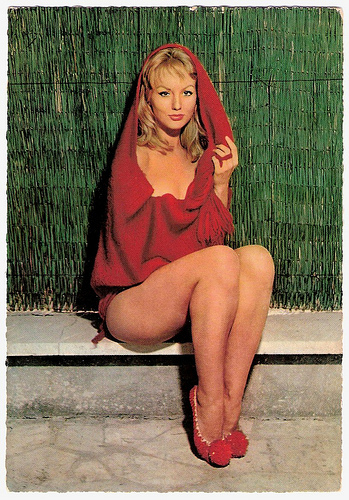
West German postcard by Krüger, no. 902/66. Photo: Bernard of Hollywood.

West German postcard by Krüger, no. 902/326. Photo: Gérard Decaux.

German postcard by Krüger, no. 902/327. Photo: Gérard Decaux.
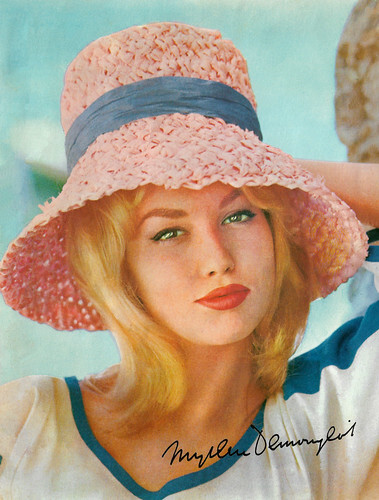
Big Dutch collectors card.
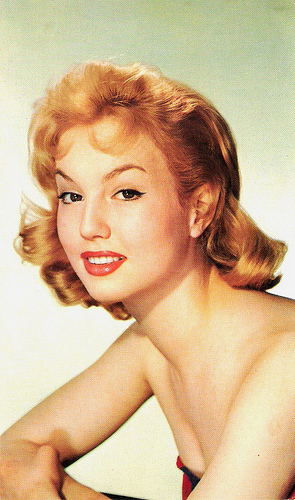
French postcard by E.D.U.G., offered by Corvisart, Epinal, no. 29. Photo: Sam Lévin.
Comeback
Mylène Demongeot was the co-owner of Kangarou Films, a production company she had founded with her late husband, director Marc Simenon, the son of Georges Simenon.
During the 1970s and 1980s, they produced a number of unsuccessful films like Par le sang des autres/By the Blood of Others (Marc Simenon, 1974) and Signé Furax/Signed Furax (Marc Simenon, 1981). Marc Simenon died in 1999.
Demongeot made a comeback in the crime drama 36 Quai des Orfevres/Department 36 (Olivier Marchal, 2004) starring Daniel Auteuil, and Victoire (Stephanie Murat, 2004) as the mother of Sylvie Testud.
Later films were La Californie/French California (Jacques Fieschi, 2006) based on a short story by Georges Simenon, the hit comedy Camping (Fabien Onteniente, 2006), and the sequel Camping 2 (Fabien Onteniente, 2010). With director Hiner Saleem, she made Sous les toits de Paris/Beneath the Rooftops of Paris (Hiner Saleem, 2007) and Si tu meurs, je te tue/If You Die, I'll Kill You (Hiner Saleem, 2011).
Demongeot also wrote several books, the best known are Tiroirs Secrets (Secret drawers, 2001) and Animalement vôtre (Animally Yours.2005). In the 2000s Demongeot made a pilgrimage to the birthplace of her mother in Kharkiv, Ukraine. There she planted a commemorative tree and presented her autobiographical book, 'Les Lilas de Kharkov' (The Lilacs of Kharkiv, 1990).
In 2006 she was named Commander in the Order of Arts and Letters for her achievements in acting. Her latest films included the comedy-drama Elle s'en va/On My Way (Emmanuelle Bercot, 2013), starring Catherine Deneuve , and Camping 3 (Fabien Onteniente, 2016), which became the second highest-grossing domestic film in France in 2016, with 3,228,313 tickets sold.
Mylene Demongéot died on 1 December 2022 in Paris at the age of 87. In October 2022, she announced that her peritoneal cancer, from which she had been declared cured in 2019, had returned.
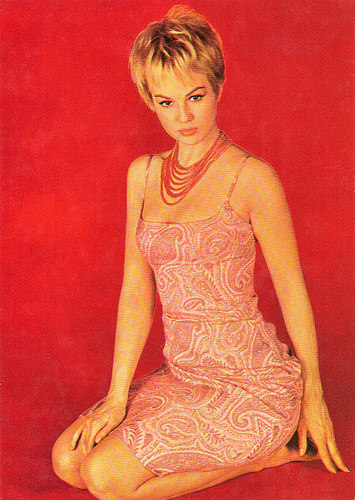
Romanian postcard by Casa Filmului Acin, no. 558.
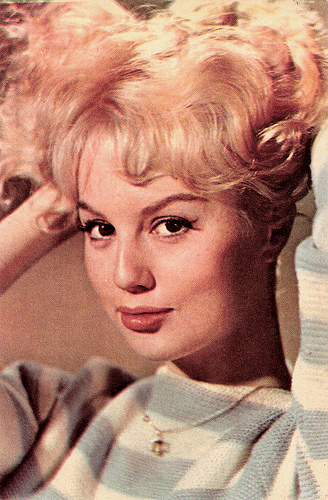
Belgian postcard by Cox, no. 42.
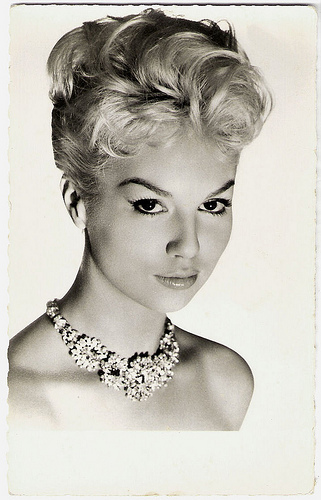
French postcard by Editions P.I., Paris, no. 955. Photo: Sam Lévin.
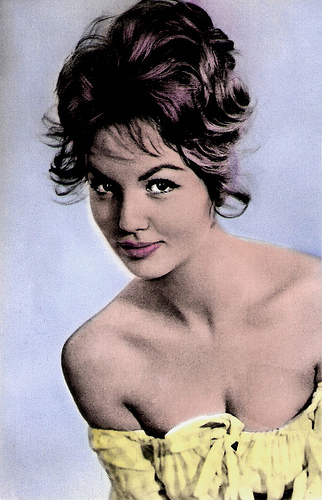
Yugoslavian postcard by Studio Sombor, no. 294.
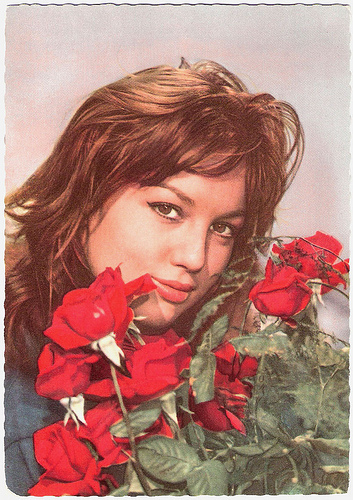
German postcard by UFA (Universum-Film Aktiengesellschaft), Berlin-Tempelhof, no. CK-268. Retail price: 300 Pfg. Photo: UFA.
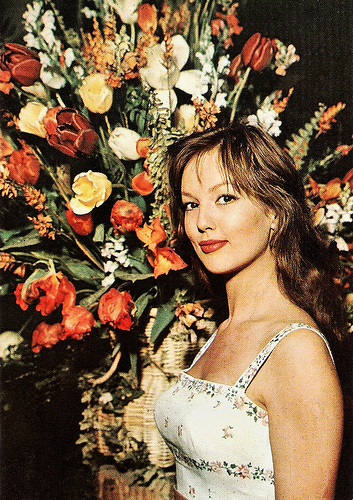
French postcard by Editions P.I., Paris, no. 1035. Photo: D. Roger.
Sources: (IMDb), Hal Erickson (AllMovie), Personal website (French), Allociné (French), Wikipedia, and

German postcard by Kruger, no. 902/162.

French postcard by Editions P.I., Paris, no. 1066. Photo: Dimitri/Dalmas.

German postcard by Kruger, no. 902/76.

French postcard by Editions P.I., Paris, no. 1014. Photo: Sam Lévin.

French postcard by E.D.U.G., no. 143. Photo: Sam Lévin.

French postcard by E.D.U.G., no. 501. Photo: Sam Lévin.
Seduction Scene
Marie-Helene Demongeot was born in Nice, France in 1935 into a family of actors. Her parents met in Shanghai, China, and moved to Nice, France.
Her mother, Klaudia Trubnikova, was a Russian-Ukrainian emigre from Kharkiv who escaped from the horrors of the Russian Civil War. Her father, Alfred Demongeot, was of French-Italian heritage. The family was bilingual and young Demongeot was able to use Russian and French, but eventually switched to French. She grew up in Nice.
After the war, at 13 she went to Paris and continued her education there. She studied piano under the tutelage of Marguerite Long and Yves Nat. At the age of 15, she became a model in the atelier of Pierre Cardin and studied dramatic art with Marie Ventura at Le Cours Simon in Paris.
Two years later she made her film debut with a supporting role in Les enfants de l'amour/Children of Love (Léonide Moguy, 1953) starring Etchika Choureau .
More small roles followed in Futures Vedettes/Joy of Living (Marc Allégret, 1955) with Brigitte Bardot , and the British musical comedy It's a Wonderful World (Val Guest, 1956).
Then she had her breakthrough at the side of Yves Montand and Simone Signoret with a memorable seduction scene in Les sorcières de Salem/The Crucible (Raymond Rouleau, 1957), based on the play by Arthur Miller.

Dutch postcard by Uitg. Takken, Utrecht, no. AX 3864.

West German postcard. Photo: DEFA. Publicity still for Les sorcières de Salem (1957).

East German postcard by VEB Progress Film-Vertrieb, Berlin, no. 1852, 1963. Retail Price: 0,20 DM. Photo: Progress.

French postcard by Editions P.I., Paris, no. 1039, offered by Les Carbones Korès 'Carboplane. Photo: H. Coste.

Dutch postcard by IFP, Amsterdam, no. 3014.

West German postcard by Kolibri-Verlag G.m.b.H, Minden/Westf. Sent by mail in the Netherlands in 1964.

Dutch postcard by Uitg. N.V. v.h. Weenenk & Snel, Baarn, no. 133.
Manipulative but humorous
With appearances in three or four feature films yearly, Mylène Demongeot would rise to international fame in the late 1950s.
Demongeot's first notable leading role was in Sois belle et tais-toi/Be Beautiful But Shut Up (Marc Allégret, 1958) opposite Henri Vidal , where she played a 17-year-old jewel smuggler.
She further developed her screen image of a manipulative but humorous blond mistress opposite David Niven in Bonjour tristesse (Otto Preminger, 1958), and opposite Alain Delon in the comedy Faibles femmes/Three Murderesses (Michel Boisrond, 1959).
Many of her screen assignments were along the ooh-la-la lines of her Swedish maid in the British Upstairs and Downstairs (Ralph Thomas, 1959).
In Italy, she played opposite Steve Reeves in the Peplum (sword and sandal epic) La battaglia di Maratona/Giant of Marathon (Jacques Tourneur, 1959), with Rosanna Schiaffino and Elsa Martinelli in La notte brava/Bad Girls Don't Cry (Mauro Bolognini, 1959) based on a script by Pier Paolo Pasolini, again with Elsa Martinelli in the comedy Un amore a Roma/Love in Rome (Dino Risi, 1960) and with Roger Moore in Il ratto delle sabine/Romulus and the Sabines (Richard Pottier, 1961).

French postcard by Editions P.I., Paris, no. 1022. Photo: Sam Lévin.

Spanish postcard by Oscarcolor, no. 266.

Spanish postcard by Oscarcolor, no. 268.

Dutch postcard by Hercules, Haarlem, no. 129. Photo: Rank. Publicity still for Upstairs and Downstairs (Ralph Thomas, 1959).

French postcard by St. Anne, Marseille. Photo: Sam Lévin.

German postcard by Krüger, no. 902/41. Photo: Sam Lévin.

French postcard by Editions Borde, Paris, no. 130. Photo: Morel.
Milady de Winter
Among Mylène Demongeot's best-known film works are the role of manipulative Milady de Winter in the two-part adventure film Les trois mousquetaires/The Three Musketeers (Bernard Borderie, 1961) and the role of Helen in the Fantômas trilogy (André Hunebelle, 1964-1967), co-starring with Jean Marais and Louis de Funès .
Other incidental interesting films were À cause, à cause d'une femme (Michel Deville, 1963) with Jacques Charrier , the comedy 12 + 1 (Nicolas Gessner, 1969) with Sharon Tate, and the Canadian drama Quelques arpents de neige/A Few Acres of Snow (Denis Héroux, 1972).
Although she gradually fazed out of her stereotypical image of a beautiful French coquette, she still looked pretty convincing in the image of a mid-aged Madame, which she developed in the 1980s in films like Tenue de soirée/Evening Dress (Bertrand Blier, 1986) starring Gérard Depardieu .
On TV she appeared in the detective series Il professore/Big Man (Steno, 1988-1989) starring Bud Spencer , and in The Man Who Lived at the Ritz (Desmond Davis, 1988).

West German postcard by Universum-Film Aktiengesellschaft (UFA), Berlin-Tempelhof, no. CK 150. Retail price: 30 Pfg. Photo: Klaus Collignon / UFA.

West German postcard by Universum-Film Aktiengesellschaft (UFA), Berlin-Tempelhof, no. CK-196. Photo: Sam Lévin / UFA.

West German postcard by Krüger, no. 902/66. Photo: Bernard of Hollywood.

West German postcard by Krüger, no. 902/326. Photo: Gérard Decaux.

German postcard by Krüger, no. 902/327. Photo: Gérard Decaux.

Big Dutch collectors card.

French postcard by E.D.U.G., offered by Corvisart, Epinal, no. 29. Photo: Sam Lévin.
Comeback
Mylène Demongeot was the co-owner of Kangarou Films, a production company she had founded with her late husband, director Marc Simenon, the son of Georges Simenon.
During the 1970s and 1980s, they produced a number of unsuccessful films like Par le sang des autres/By the Blood of Others (Marc Simenon, 1974) and Signé Furax/Signed Furax (Marc Simenon, 1981). Marc Simenon died in 1999.
Demongeot made a comeback in the crime drama 36 Quai des Orfevres/Department 36 (Olivier Marchal, 2004) starring Daniel Auteuil, and Victoire (Stephanie Murat, 2004) as the mother of Sylvie Testud.
Later films were La Californie/French California (Jacques Fieschi, 2006) based on a short story by Georges Simenon, the hit comedy Camping (Fabien Onteniente, 2006), and the sequel Camping 2 (Fabien Onteniente, 2010). With director Hiner Saleem, she made Sous les toits de Paris/Beneath the Rooftops of Paris (Hiner Saleem, 2007) and Si tu meurs, je te tue/If You Die, I'll Kill You (Hiner Saleem, 2011).
Demongeot also wrote several books, the best known are Tiroirs Secrets (Secret drawers, 2001) and Animalement vôtre (Animally Yours.2005). In the 2000s Demongeot made a pilgrimage to the birthplace of her mother in Kharkiv, Ukraine. There she planted a commemorative tree and presented her autobiographical book, 'Les Lilas de Kharkov' (The Lilacs of Kharkiv, 1990).
In 2006 she was named Commander in the Order of Arts and Letters for her achievements in acting. Her latest films included the comedy-drama Elle s'en va/On My Way (Emmanuelle Bercot, 2013), starring Catherine Deneuve , and Camping 3 (Fabien Onteniente, 2016), which became the second highest-grossing domestic film in France in 2016, with 3,228,313 tickets sold.
Mylene Demongéot died on 1 December 2022 in Paris at the age of 87. In October 2022, she announced that her peritoneal cancer, from which she had been declared cured in 2019, had returned.

Romanian postcard by Casa Filmului Acin, no. 558.

Belgian postcard by Cox, no. 42.

French postcard by Editions P.I., Paris, no. 955. Photo: Sam Lévin.

Yugoslavian postcard by Studio Sombor, no. 294.

German postcard by UFA (Universum-Film Aktiengesellschaft), Berlin-Tempelhof, no. CK-268. Retail price: 300 Pfg. Photo: UFA.

French postcard by Editions P.I., Paris, no. 1035. Photo: D. Roger.
Sources: (IMDb), Hal Erickson (AllMovie), Personal website (French), Allociné (French), Wikipedia, and
Published on December 03, 2022 22:00
December 2, 2022
Gösta Berling Saga (1924)
Gösta Berlings saga/The Atonement of Gösta Berling (Mauritz Stiller, 1924) was an adaptation of the first novel by Selma Lagerlöf. Gösta was portrayed by Lars Hanson and Greta Garbo appears here for the first time under the name "Garbo". The cinematography was by Julius Jaenzon, and the art direction was by Vilhelm Bryde with Edgar Ulmer collaborating on the set design.
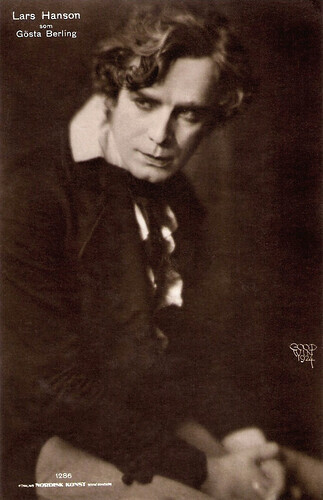
Swedish postcard by Förlag Nordisk Konst, Stockholm, no. 1286. Photo: Goodwin, 1924. Lars Hanson as Gösta Berling in Gösta Berlings saga/The Atonement of Gösta Berling (Mauritz Stiller, 1924).
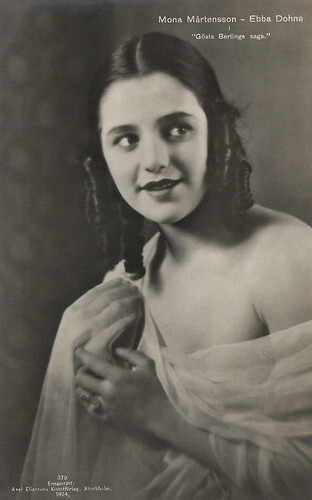
Swedish postcard by Axel Eliassons Förlag, Stockholm, no. 379, 1924. Photo: Svenska-Film. Mona Mårtenson as Ebba Dolna in Gösta Berlings saga/The Atonement of Gosta Berling (Mauritz Stiller, 1924).
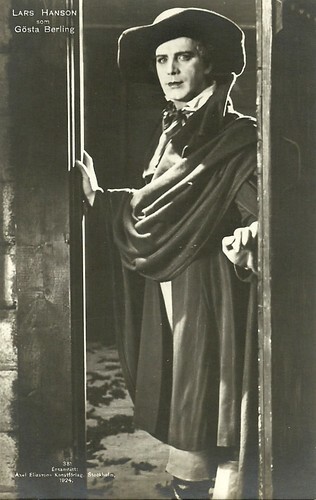
Swedish postcard by Axel Eliassons Konstförlag, Stockholm, no. 381. Lars Hanson as the title character in Gösta Berlings saga/The Atonement of Gosta Berling (Mauritz Stiller 1924).
A novel out of the stories and people of her homeland
'Gösta Berlings Saga' is the first novel by the Swedish writer Selma Lagerlöf. The book was first published in 1891 by Albert Bonniers Förlag in Stockholm.
In Gösta Berling, Selma Lagerlöf is a romantic; the book is a reaction to the realism that prevailed at the time. As a child, she had absorbed the folk tales of her surroundings, and in the autumn of 1881, while walking down the street in Stockholm, she suddenly had the idea of making a novel out of the stories and people of her homeland. Thus the idea for 'Gösta Berlings Saga' was born.
In the summer of 1890, a Swedish magazine, Idun, organised a novella competition and offered a prize for the best novel of a certain length. Lagerlöf entered the contest with five chapters of 'Gösta Berlings Saga', a story that was then beginning to take shape in her mind. She won the competition.
In 1891 the complete novel was finally published. It is set in Värmland in the 1820s and is about the deposed Lutheran vicar Gösta Berling, who becomes the leader of the cavaliers at Ekeby. The adventurous lives of these cavaliers, former officers and impoverished noblemen who have found a freehold on the Ekeby estate and spend their days in love adventures, making music, playing cards and similar amusements, are presented in numerous quite independent chapters.
The story of Gösta Berling, who is purified into a better person after various experiences, forms the framework for a series of rather loosely connected episodes. The reviews were initially negative, with conservative and liberal critics united in their disapproval. Sales were also poor. It was not until 1893, when the well-known Danish literary critic Georg Brandes published an extraordinarily positive review of the Danish translation, that the assessment of the novel changed.
Over time, the success of Gösta Berling grew more and more, and today it is one of the best-known and most widely read Swedish books. 'Gösta Berlings Saga' has been called the epic prose of Swedish rural life. In 1924, the book was filmed, starring the then unknown Greta Garbo , and the popular actors Lars Hanson and Gerda Lundequist.
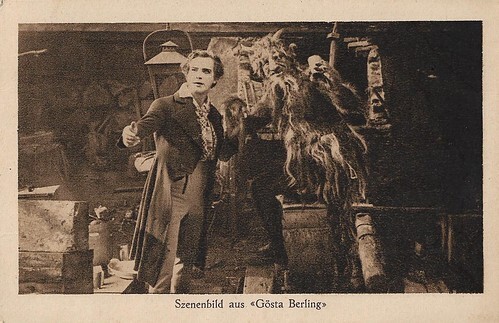
German postcard by Trianon for the German premiere of the film on 20 August 1924, at the Berlin Theater am Nollendorfplatz. Photo: Svenska Film of the Trianon-Film-Konzern, Berlin (also in Leipzig, Frankfurt a.M., Düsseldorf and Hamburg). Lars Hanson in Gösta Berlings saga/The Atonement of Gösta Berling (Mauritz Stiller, 1924).
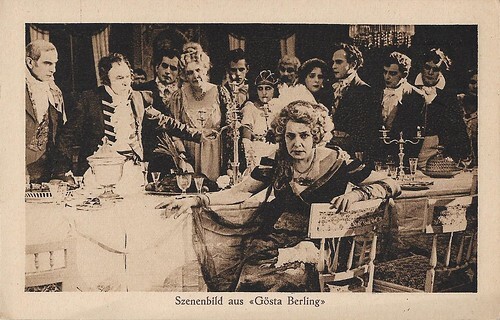
German postcard by Trianon for the German premiere of the film on 20 August 1924, at the Berlin Theater am Nollendorfplatz. Photo: Svenska Film of the Trianon-Film-Konzern, Berlin (also in Leipzig, Frankfurt a.M., Düsseldorf and Hamburg). Gerda Lundequist as the Major's Wife and Lady of the Estate Ekeby, Margaretha Samzelius, in Gösta Berlings saga/The Atonement of Gösta Berling (Mauritz Stiller, 1924).
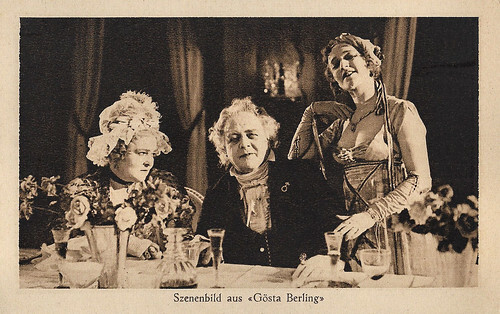
German postcard by Trianon-Film, 1924. Photo: Svenska-Film. Karin Swanström, Sixten Malmerfelt and Jenny Hasselqvist in Gösta Berlings saga/The Atonement of Gosta Berling (Mauritz Stiller, 1924).
The last great masterpiece of Swedish silent cinema
The film adaptation, Gösta Berlings saga/The Saga of Gösta Berling (Mauritz Stiller, 1924), premiered in two parts in Stockholm on 10 and 17 March 1924. Lars Hanson played the young priest Gösta Berling, who suffers a crisis of meaning in the Swedish countryside around 1820. Emotionally unstable, at the beginning of the plot Gösta Berling is completely a slave to his lusts and gives in to drunkenness and womanising.
After a scandal, he leaves the parish in the dead of night to wander the countryside as a good-for-nothing. With a bunch of other drifters, he comes to Ekeby, the castle of the rich Major Samzelius and his wife (Gerda Lundequist). There he meets the innocent Countess Elisabeth Dohna ( Greta Garbo ), who helps Gösta to find inner strength and strength of character. Before the two of them can begin a future together, they have to go through many adventures, such as the burning of Ekeby Castle, set by the mad Major Samzelius (Otto Elg-Lundberg).
Gösta Berlings saga/The Atonement of Gösta Berling ended the Swedish creative period of director Mauritz Stiller. Stiller's forte was elegantly staged relationship comedies like Erotikon (1920), but his greatest commercial successes came with opulent literary adaptations. Among them were two works by Swedish author Selma Lagerlöf, Herr Arnes pengar/Sir Arne's Treasure from 1919 and Gunnar Hedes saga/Snowbound from 1923.
The young Greta Gustafson was given the opportunity in the late spring of 1923 to participate in a casting for the upcoming of Stiller's film adaptation Gösta Berlings saga/The Atonement of Gösta Berling, together with her colleague Mona Mårtenson . Stiller discovered a performing quality in the girl, who was only seventeen at the time, that prompted him to give her the important role of Countess Elisabeth.
Shortly after the extensive filming began, Stiller also arranged for the young woman to adopt the stage name Greta Garbo . There are various versions of how the choice came about, the simplest being that the name Garbo was a development of the original suggestion Mona Gabor, which was based on the phonetic sound of a former prince of Transylvania. The actress officially adopted the name Greta Garbo on 9 November 1923.
The shooting, which lasted almost a whole year, was an ordeal for the completely inexperienced actress. Stiller, who as a director was equally a perfectionist and an autocratic ruler, forced Greta Garbo to unconditional obedience to his instructions. Through endless repetitions of individual scenes and targeted verbal attacks, he steered Greta Garbo in the direction he had intended from the beginning. Garbo gave herself completely into the hands of her mentor and finally accepted without complaint the sometimes violent insults when, in Stiller's opinion, she had not given her best performance.
After the film was shot, Mauritz Stiller went to Hollywood via Berlin together with his protégée Garbo. Gösta Berlings saga/The Atonement of Gösta Berling (Mauritz Stiller, 1924) is today considered the last great masterpiece of Swedish silent cinema. The spectacular fire at Ekeby Castle was the most expensive sequence ever filmed in Sweden at the time. Stiller used the entire technical repertoire, such as rapid editing sequences and lighting effects, to bring the drama of the action to the screen. Another well-known shot showed Elisabeth Dohna fleeing in her horse-drawn sleigh in frantic flight across a frozen lake from a pack of wolves. However, Stiller used specially trained German shepherds for the sequence, hanging weights on their tails so that they would show the typical posture of wolves in the 'longshots'.
The film was originally released in two parts in Sweden, Gösta Berlings saga del I on 10 March 1924, and Gösta Berlings saga del II seven days later. The two-part version was also released in Finland and Norway, but for the rest of the world a shorter, one-part export version was made. In 1927 the film was recut, almost halving its running time. This was the only version that was archived. In 1933 a sound version was released theatrically in Stockholm, with the intertitles removed, along with additional edits and some reordering of the scenes. Most of the missing material was discovered 20 years later and a restored version with new intertitles was released in theatres. The Swedish Film Institute added newly found fragments throughout the years, but as of the 1975 restoration about 450 metres of film from the original cut remained missing. In February 2018, the completion of a new, comprehensive restoration was announced. The 2018 version is 16 minutes longer than the previous restoration and brings the film close to its original running time. It also restores the film's tinting scheme for the first time since its original release.
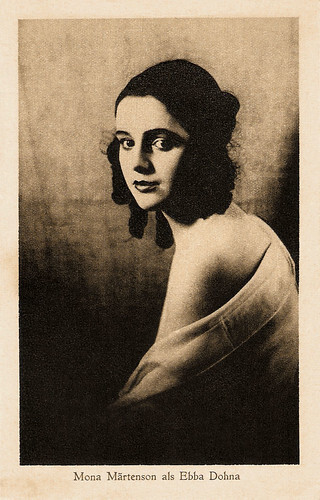
German postcard by Trianon-Film, 1924. Photo: Svenska-Film. Mona Mårtenson in Gösta Berlings saga/The Atonement of Gosta Berling (Mauritz Stiller, 1924), based on the novel by Selma Lagerlöf.
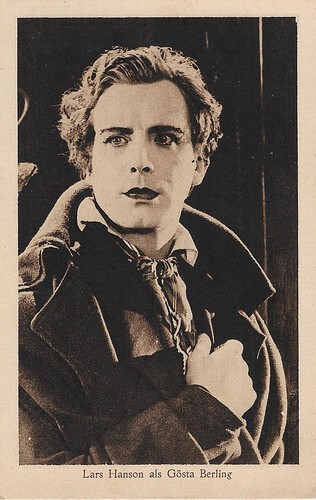
German postcard by Trianon for the German premiere of the film on 20 August 1924, at the Berlin Theater am Nollendorfplatz. Photo: Svenska Film of the Trianon-Film-Konzern, Berlin (also in Leipzig, Frankfurt a.M., Düsseldorf and Hamburg). Lars Hanson as Gösta Berling in Gösta Berlings saga/The Atonement of Gösta Berling (Mauritz Stiller, 1924).
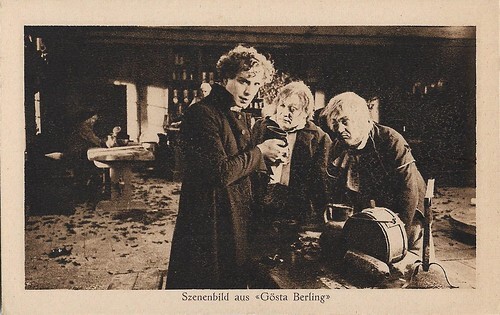
German postcard by Trianon for the German premiere of the film on 20 August 1924, at the Berlin Theater am Nollendorfplatz. Photo: Svenska Film of the Trianon-Film-Konzern, Berlin (also in Leipzig, Frankfurt a.M., Düsseldorf and Hamburg). Lars Hanson in Gösta Berlings saga/The Atonement of Gösta Berling (Mauritz Stiller, 1924).
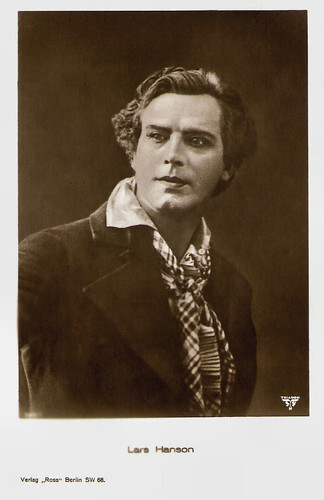
German postcard by Ross-Verlag, Berlin. Photo: Trianon. Lars Hanson in Gösta Berlings saga/The Atonement of Gösta Berling (Mauritz Stiller 1924).
Sources: Wikipedia (German and English) and IMDb.

Swedish postcard by Förlag Nordisk Konst, Stockholm, no. 1286. Photo: Goodwin, 1924. Lars Hanson as Gösta Berling in Gösta Berlings saga/The Atonement of Gösta Berling (Mauritz Stiller, 1924).

Swedish postcard by Axel Eliassons Förlag, Stockholm, no. 379, 1924. Photo: Svenska-Film. Mona Mårtenson as Ebba Dolna in Gösta Berlings saga/The Atonement of Gosta Berling (Mauritz Stiller, 1924).

Swedish postcard by Axel Eliassons Konstförlag, Stockholm, no. 381. Lars Hanson as the title character in Gösta Berlings saga/The Atonement of Gosta Berling (Mauritz Stiller 1924).
A novel out of the stories and people of her homeland
'Gösta Berlings Saga' is the first novel by the Swedish writer Selma Lagerlöf. The book was first published in 1891 by Albert Bonniers Förlag in Stockholm.
In Gösta Berling, Selma Lagerlöf is a romantic; the book is a reaction to the realism that prevailed at the time. As a child, she had absorbed the folk tales of her surroundings, and in the autumn of 1881, while walking down the street in Stockholm, she suddenly had the idea of making a novel out of the stories and people of her homeland. Thus the idea for 'Gösta Berlings Saga' was born.
In the summer of 1890, a Swedish magazine, Idun, organised a novella competition and offered a prize for the best novel of a certain length. Lagerlöf entered the contest with five chapters of 'Gösta Berlings Saga', a story that was then beginning to take shape in her mind. She won the competition.
In 1891 the complete novel was finally published. It is set in Värmland in the 1820s and is about the deposed Lutheran vicar Gösta Berling, who becomes the leader of the cavaliers at Ekeby. The adventurous lives of these cavaliers, former officers and impoverished noblemen who have found a freehold on the Ekeby estate and spend their days in love adventures, making music, playing cards and similar amusements, are presented in numerous quite independent chapters.
The story of Gösta Berling, who is purified into a better person after various experiences, forms the framework for a series of rather loosely connected episodes. The reviews were initially negative, with conservative and liberal critics united in their disapproval. Sales were also poor. It was not until 1893, when the well-known Danish literary critic Georg Brandes published an extraordinarily positive review of the Danish translation, that the assessment of the novel changed.
Over time, the success of Gösta Berling grew more and more, and today it is one of the best-known and most widely read Swedish books. 'Gösta Berlings Saga' has been called the epic prose of Swedish rural life. In 1924, the book was filmed, starring the then unknown Greta Garbo , and the popular actors Lars Hanson and Gerda Lundequist.

German postcard by Trianon for the German premiere of the film on 20 August 1924, at the Berlin Theater am Nollendorfplatz. Photo: Svenska Film of the Trianon-Film-Konzern, Berlin (also in Leipzig, Frankfurt a.M., Düsseldorf and Hamburg). Lars Hanson in Gösta Berlings saga/The Atonement of Gösta Berling (Mauritz Stiller, 1924).

German postcard by Trianon for the German premiere of the film on 20 August 1924, at the Berlin Theater am Nollendorfplatz. Photo: Svenska Film of the Trianon-Film-Konzern, Berlin (also in Leipzig, Frankfurt a.M., Düsseldorf and Hamburg). Gerda Lundequist as the Major's Wife and Lady of the Estate Ekeby, Margaretha Samzelius, in Gösta Berlings saga/The Atonement of Gösta Berling (Mauritz Stiller, 1924).

German postcard by Trianon-Film, 1924. Photo: Svenska-Film. Karin Swanström, Sixten Malmerfelt and Jenny Hasselqvist in Gösta Berlings saga/The Atonement of Gosta Berling (Mauritz Stiller, 1924).
The last great masterpiece of Swedish silent cinema
The film adaptation, Gösta Berlings saga/The Saga of Gösta Berling (Mauritz Stiller, 1924), premiered in two parts in Stockholm on 10 and 17 March 1924. Lars Hanson played the young priest Gösta Berling, who suffers a crisis of meaning in the Swedish countryside around 1820. Emotionally unstable, at the beginning of the plot Gösta Berling is completely a slave to his lusts and gives in to drunkenness and womanising.
After a scandal, he leaves the parish in the dead of night to wander the countryside as a good-for-nothing. With a bunch of other drifters, he comes to Ekeby, the castle of the rich Major Samzelius and his wife (Gerda Lundequist). There he meets the innocent Countess Elisabeth Dohna ( Greta Garbo ), who helps Gösta to find inner strength and strength of character. Before the two of them can begin a future together, they have to go through many adventures, such as the burning of Ekeby Castle, set by the mad Major Samzelius (Otto Elg-Lundberg).
Gösta Berlings saga/The Atonement of Gösta Berling ended the Swedish creative period of director Mauritz Stiller. Stiller's forte was elegantly staged relationship comedies like Erotikon (1920), but his greatest commercial successes came with opulent literary adaptations. Among them were two works by Swedish author Selma Lagerlöf, Herr Arnes pengar/Sir Arne's Treasure from 1919 and Gunnar Hedes saga/Snowbound from 1923.
The young Greta Gustafson was given the opportunity in the late spring of 1923 to participate in a casting for the upcoming of Stiller's film adaptation Gösta Berlings saga/The Atonement of Gösta Berling, together with her colleague Mona Mårtenson . Stiller discovered a performing quality in the girl, who was only seventeen at the time, that prompted him to give her the important role of Countess Elisabeth.
Shortly after the extensive filming began, Stiller also arranged for the young woman to adopt the stage name Greta Garbo . There are various versions of how the choice came about, the simplest being that the name Garbo was a development of the original suggestion Mona Gabor, which was based on the phonetic sound of a former prince of Transylvania. The actress officially adopted the name Greta Garbo on 9 November 1923.
The shooting, which lasted almost a whole year, was an ordeal for the completely inexperienced actress. Stiller, who as a director was equally a perfectionist and an autocratic ruler, forced Greta Garbo to unconditional obedience to his instructions. Through endless repetitions of individual scenes and targeted verbal attacks, he steered Greta Garbo in the direction he had intended from the beginning. Garbo gave herself completely into the hands of her mentor and finally accepted without complaint the sometimes violent insults when, in Stiller's opinion, she had not given her best performance.
After the film was shot, Mauritz Stiller went to Hollywood via Berlin together with his protégée Garbo. Gösta Berlings saga/The Atonement of Gösta Berling (Mauritz Stiller, 1924) is today considered the last great masterpiece of Swedish silent cinema. The spectacular fire at Ekeby Castle was the most expensive sequence ever filmed in Sweden at the time. Stiller used the entire technical repertoire, such as rapid editing sequences and lighting effects, to bring the drama of the action to the screen. Another well-known shot showed Elisabeth Dohna fleeing in her horse-drawn sleigh in frantic flight across a frozen lake from a pack of wolves. However, Stiller used specially trained German shepherds for the sequence, hanging weights on their tails so that they would show the typical posture of wolves in the 'longshots'.
The film was originally released in two parts in Sweden, Gösta Berlings saga del I on 10 March 1924, and Gösta Berlings saga del II seven days later. The two-part version was also released in Finland and Norway, but for the rest of the world a shorter, one-part export version was made. In 1927 the film was recut, almost halving its running time. This was the only version that was archived. In 1933 a sound version was released theatrically in Stockholm, with the intertitles removed, along with additional edits and some reordering of the scenes. Most of the missing material was discovered 20 years later and a restored version with new intertitles was released in theatres. The Swedish Film Institute added newly found fragments throughout the years, but as of the 1975 restoration about 450 metres of film from the original cut remained missing. In February 2018, the completion of a new, comprehensive restoration was announced. The 2018 version is 16 minutes longer than the previous restoration and brings the film close to its original running time. It also restores the film's tinting scheme for the first time since its original release.

German postcard by Trianon-Film, 1924. Photo: Svenska-Film. Mona Mårtenson in Gösta Berlings saga/The Atonement of Gosta Berling (Mauritz Stiller, 1924), based on the novel by Selma Lagerlöf.

German postcard by Trianon for the German premiere of the film on 20 August 1924, at the Berlin Theater am Nollendorfplatz. Photo: Svenska Film of the Trianon-Film-Konzern, Berlin (also in Leipzig, Frankfurt a.M., Düsseldorf and Hamburg). Lars Hanson as Gösta Berling in Gösta Berlings saga/The Atonement of Gösta Berling (Mauritz Stiller, 1924).

German postcard by Trianon for the German premiere of the film on 20 August 1924, at the Berlin Theater am Nollendorfplatz. Photo: Svenska Film of the Trianon-Film-Konzern, Berlin (also in Leipzig, Frankfurt a.M., Düsseldorf and Hamburg). Lars Hanson in Gösta Berlings saga/The Atonement of Gösta Berling (Mauritz Stiller, 1924).

German postcard by Ross-Verlag, Berlin. Photo: Trianon. Lars Hanson in Gösta Berlings saga/The Atonement of Gösta Berling (Mauritz Stiller 1924).
Sources: Wikipedia (German and English) and IMDb.
Published on December 02, 2022 22:00
December 1, 2022
Randolph Scott
Randolph Scott (1898-1987) was a handsome American leading man who developed into one of Hollywood's greatest and most popular Western stars. From 1950 to 1953, he was among Hollywood's Top 10 box-office draws. He has appeared in more than 100 films, and of those, more than 60 are Westerns. With that number, he surpasses 'the' Western hero par excellence John Wayne.

British postcard in the Picturegoer Series, London, no. 799. Photo: Paramount.
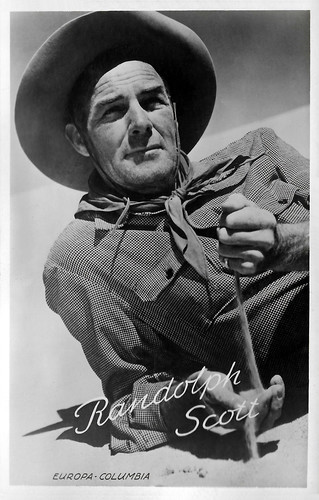
Dutch postcard. Photo: Europa - Columbia.
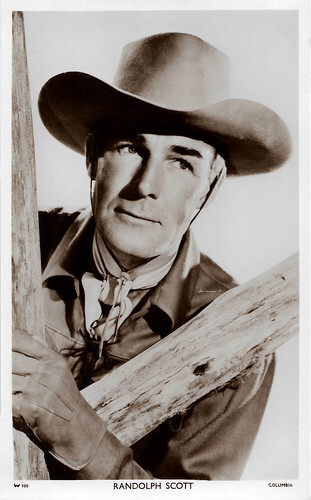
British postcard in the Picturegoer Series, London, no. W 980. Photo: Columbia.
Gaining much-needed acting experience
George Randolph Scott was born in 1898 as the second of six children of George and Lucy Crane Scott during a visit to Virginia. He was raised in Charlotte, North Carolina in a wealthy family. Because of his family's financial status, 'Randy' was able to attend private schools such as Woodberry Forest School. From an early age, Scott developed and displayed his athleticism, excelling in football, baseball, horse racing, and swimming.
After service with the U.S. Army in France in World War I, he attended the Georgia Institute of Technology but, after being injured playing football, he transferred to the University of North Carolina, from which he graduated with a degree in textile engineering and manufacturing.
Around 1927, he discovered acting and went to California, where he met Howard Hughes, who arranged a small part in a George O'Brien film called Sharp Shooters (John G. Blystone, 1928). Hughes also obtained an audition for him for Cecil B. DeMille 's Dynamite (1929), a role that went instead to Joel McCrea. He was hired to coach Gary Cooper in a Virginia dialect for The Virginian (Victor Fleming, 1929) and played a bit part in the film.
On the advice of Cecil B. DeMille , Scott gained much-needed acting experience by performing in stage plays with the Pasadena Playhouse. In 1931 Scott played his first leading role opposite Sally Blane in Women Men Marry (Charles Hutchison, 1931), a film, now apparently lost, made by a Poverty Row studio called Headline Pictures. In 1932 Scott appeared in a play at the Vine Street Theatre in Hollywood, 'Under a Virginia Moon'. Paramount scouts saw him and offered him a contract. Paramount cast him as the lead in Heritage of the Desert (Henry Hathaway, 1932), his first significant starring role and also the one that established him as a Western hero. Henry Hathaway made his directorial debut with Heritage of the Desert. The film was popular and Scott would go on to make ten 'B' Westerns loosely based on the novels of Zane Grey.
Scott met Cary Grant , another Paramount contract player, on the set of Hot Saturday (William A. Seiter, 1932) and the pair soon moved in together. Till 1944, they lived in a beach house known jocularly as Bachelor Hall. The close friendship between Scott and Grant and the steady stream of women into and out of Bachelor Hall fed rumour mills for years. Many believed that Grant and Scott were lovers, and the women were arranged by the film studios for public effect. This cohabitation ended in 1942 when Cary Grant married the Woolworth heiress Barbara Hutton, then the richest woman in the world. Scott remained close friends with Grant until the day he died. When he heard of his old friend's death, he reportedly put his head in his hands and wept. He himself would die a little over 2 months afterwards.
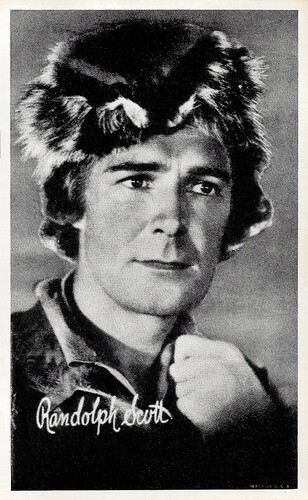
American postcard. Randolph Scott in The Last of the Mohicans (George B. Seitz, 1936).
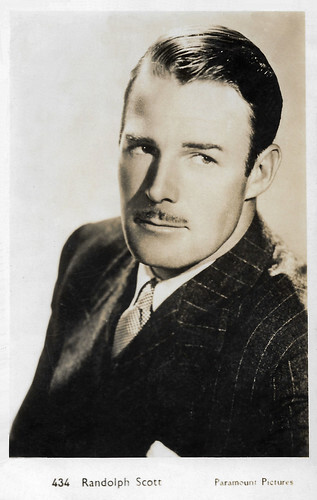
British postcard by Publicity Photographs LTD, London, no. 434. Photo: Paramount.
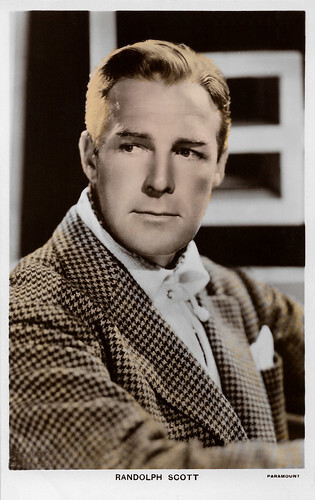
British postcard in the Colourgraph Series, London, no. C 256. Photo: Paramount.
Altering into a stoic, craggy, and uncompromising figure
Paramount loaned Randolph Scott to RKO Radio Pictures to support Fred Astaire , Ginger Rogers and Irene Dunne in Roberta (William A. Seiter, 1935), a hugely popular adaptation of the Broadway musical. He was loaned to independent producer Edward Small, to play Hawkeye in the adventure classic, The Last of the Mohicans (George B. Seitz, 1936), adapted from the 1826 novel by James Fenimore Cooper. A big hit, the film gave Scott his first unqualified 'A' picture success as a lead. He was a love interest for Mae West in Go West, Young Man (Henry Hathaway, 1936) and was reunited with Irene Dunne in a musical, High, Wide and Handsome (Rouben Mamoulian, 1937).
Randolph Scott married and divorced wealthy heiress Marion DuPont in the late 1930s. In the 1940s he appeared in several war films, notably To the Shores of Tripoli (H. Bruce Humberstone, 1942), Bombardier (Richard Wallace, 1943), the Canadian warship drama Corvette K-225 (Richard Rosson, 1943), Gung Ho! (Ray Enright, 1943) and China Sky (Ray Enright, 1945). Scott was a pleasant figure in comedies, dramas, and the occasional adventure, but it was not until he began focusing on Westerns in the late 1940s that he reached his greatest stardom. In 1946, after playing roles that had him wandering in and out of the saddle for many years, Scott appeared in Abilene Town (Edwin L. Marin, 1946), which cast him in what would become one of his classic images, the fearless lawman cleaning up a lawless town. The film cemented Scott's position as a cowboy hero; from this point on, all but two of his starring films would be Westerns.
He became one of the top box office stars of the 1950s and, in the Westerns of Budd Boetticher especially, a critically important figure in the Western as an art form. The seven films he shot under Boetticher's direction are classic Westerns: Seven Men from Now (1956), The Tall T (1956), Decision at Sundown (1957), Buchanan Rides Alone (1958), Westbound (1958), Ride Lonesome (1959) and Comanche Station (1960). His screen persona altered into that of a stoic, craggy, uncompromising figure, a tough, hard-bitten man seemingly unconnected to the light comedy lead he had been in the 1930s. In these films, the natural entourage is the rugged landscapes of the Californian Sierras.
Following a critically acclaimed, less-heroic-than-usual role in one of the classics of the genre, Ride the High Country (Sam Peckinpah, 1962) opposite Joel McCrea, Scott retired from films at the age of 64. A multimillionaire as a result of smart investments, Scott spent his remaining years playing golf and avoiding film industry affairs, stating that he didn't like publicity.
In 1987, he died in Beverly Hills of a heart and lung disease at the age of 89. He was survived by his second wife, Patricia Stillman, and their two adopted children, Christopher and Sandra. He was interred at Elmwood Cemetery, Charlotte, North Carolina, USA, just four blocks from his boyhood home at 312 W. 10th Street.
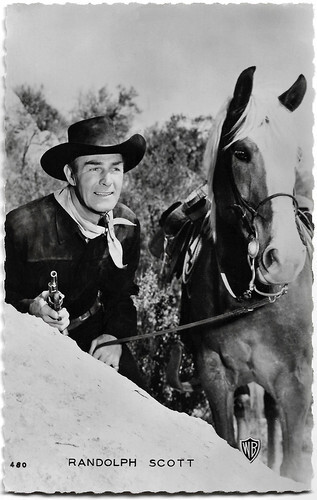
French postcard by Editions P.I., presented by Les Carbones Korès, Paris, no. 480. Photo: Warner Bros, 1953.Randolph Scott in Colt .45 (Edwin L. Marin, 1950).
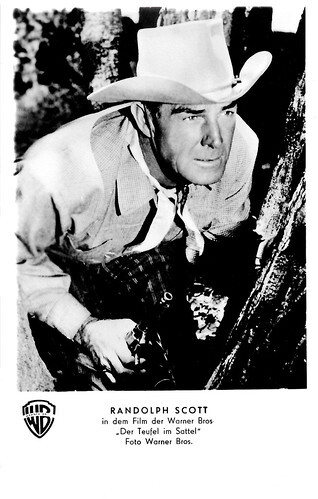
German postcard by Netter's Star Verlag, Berlin, no. 1475. Photo: Warner Bros. Randolph Scott in Tall Man Riding (Lesley Selander, 1955).
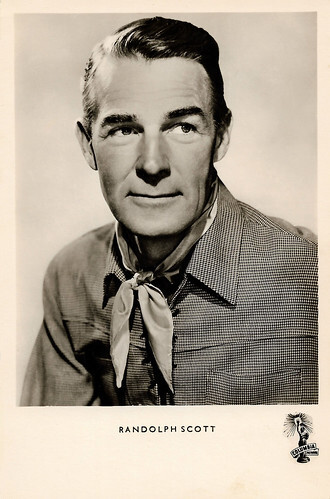
West-German postcard by Kunst und Bild, Berlin, no. A 123. Photo: Columbia.
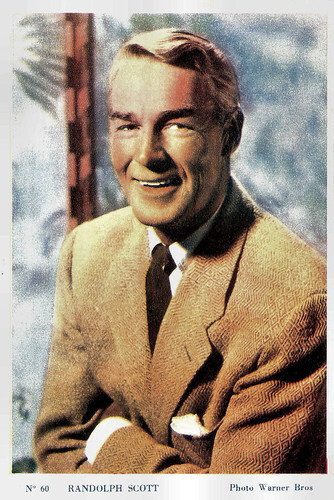
Belgian collectors card by Merbotex, Bruxelles, for cinéma Kursaal in Bertrix, no. 60. Photo: Warner Bros.
Sources: (IMDb), Wikipedia and .

British postcard in the Picturegoer Series, London, no. 799. Photo: Paramount.

Dutch postcard. Photo: Europa - Columbia.

British postcard in the Picturegoer Series, London, no. W 980. Photo: Columbia.
Gaining much-needed acting experience
George Randolph Scott was born in 1898 as the second of six children of George and Lucy Crane Scott during a visit to Virginia. He was raised in Charlotte, North Carolina in a wealthy family. Because of his family's financial status, 'Randy' was able to attend private schools such as Woodberry Forest School. From an early age, Scott developed and displayed his athleticism, excelling in football, baseball, horse racing, and swimming.
After service with the U.S. Army in France in World War I, he attended the Georgia Institute of Technology but, after being injured playing football, he transferred to the University of North Carolina, from which he graduated with a degree in textile engineering and manufacturing.
Around 1927, he discovered acting and went to California, where he met Howard Hughes, who arranged a small part in a George O'Brien film called Sharp Shooters (John G. Blystone, 1928). Hughes also obtained an audition for him for Cecil B. DeMille 's Dynamite (1929), a role that went instead to Joel McCrea. He was hired to coach Gary Cooper in a Virginia dialect for The Virginian (Victor Fleming, 1929) and played a bit part in the film.
On the advice of Cecil B. DeMille , Scott gained much-needed acting experience by performing in stage plays with the Pasadena Playhouse. In 1931 Scott played his first leading role opposite Sally Blane in Women Men Marry (Charles Hutchison, 1931), a film, now apparently lost, made by a Poverty Row studio called Headline Pictures. In 1932 Scott appeared in a play at the Vine Street Theatre in Hollywood, 'Under a Virginia Moon'. Paramount scouts saw him and offered him a contract. Paramount cast him as the lead in Heritage of the Desert (Henry Hathaway, 1932), his first significant starring role and also the one that established him as a Western hero. Henry Hathaway made his directorial debut with Heritage of the Desert. The film was popular and Scott would go on to make ten 'B' Westerns loosely based on the novels of Zane Grey.
Scott met Cary Grant , another Paramount contract player, on the set of Hot Saturday (William A. Seiter, 1932) and the pair soon moved in together. Till 1944, they lived in a beach house known jocularly as Bachelor Hall. The close friendship between Scott and Grant and the steady stream of women into and out of Bachelor Hall fed rumour mills for years. Many believed that Grant and Scott were lovers, and the women were arranged by the film studios for public effect. This cohabitation ended in 1942 when Cary Grant married the Woolworth heiress Barbara Hutton, then the richest woman in the world. Scott remained close friends with Grant until the day he died. When he heard of his old friend's death, he reportedly put his head in his hands and wept. He himself would die a little over 2 months afterwards.

American postcard. Randolph Scott in The Last of the Mohicans (George B. Seitz, 1936).

British postcard by Publicity Photographs LTD, London, no. 434. Photo: Paramount.

British postcard in the Colourgraph Series, London, no. C 256. Photo: Paramount.
Altering into a stoic, craggy, and uncompromising figure
Paramount loaned Randolph Scott to RKO Radio Pictures to support Fred Astaire , Ginger Rogers and Irene Dunne in Roberta (William A. Seiter, 1935), a hugely popular adaptation of the Broadway musical. He was loaned to independent producer Edward Small, to play Hawkeye in the adventure classic, The Last of the Mohicans (George B. Seitz, 1936), adapted from the 1826 novel by James Fenimore Cooper. A big hit, the film gave Scott his first unqualified 'A' picture success as a lead. He was a love interest for Mae West in Go West, Young Man (Henry Hathaway, 1936) and was reunited with Irene Dunne in a musical, High, Wide and Handsome (Rouben Mamoulian, 1937).
Randolph Scott married and divorced wealthy heiress Marion DuPont in the late 1930s. In the 1940s he appeared in several war films, notably To the Shores of Tripoli (H. Bruce Humberstone, 1942), Bombardier (Richard Wallace, 1943), the Canadian warship drama Corvette K-225 (Richard Rosson, 1943), Gung Ho! (Ray Enright, 1943) and China Sky (Ray Enright, 1945). Scott was a pleasant figure in comedies, dramas, and the occasional adventure, but it was not until he began focusing on Westerns in the late 1940s that he reached his greatest stardom. In 1946, after playing roles that had him wandering in and out of the saddle for many years, Scott appeared in Abilene Town (Edwin L. Marin, 1946), which cast him in what would become one of his classic images, the fearless lawman cleaning up a lawless town. The film cemented Scott's position as a cowboy hero; from this point on, all but two of his starring films would be Westerns.
He became one of the top box office stars of the 1950s and, in the Westerns of Budd Boetticher especially, a critically important figure in the Western as an art form. The seven films he shot under Boetticher's direction are classic Westerns: Seven Men from Now (1956), The Tall T (1956), Decision at Sundown (1957), Buchanan Rides Alone (1958), Westbound (1958), Ride Lonesome (1959) and Comanche Station (1960). His screen persona altered into that of a stoic, craggy, uncompromising figure, a tough, hard-bitten man seemingly unconnected to the light comedy lead he had been in the 1930s. In these films, the natural entourage is the rugged landscapes of the Californian Sierras.
Following a critically acclaimed, less-heroic-than-usual role in one of the classics of the genre, Ride the High Country (Sam Peckinpah, 1962) opposite Joel McCrea, Scott retired from films at the age of 64. A multimillionaire as a result of smart investments, Scott spent his remaining years playing golf and avoiding film industry affairs, stating that he didn't like publicity.
In 1987, he died in Beverly Hills of a heart and lung disease at the age of 89. He was survived by his second wife, Patricia Stillman, and their two adopted children, Christopher and Sandra. He was interred at Elmwood Cemetery, Charlotte, North Carolina, USA, just four blocks from his boyhood home at 312 W. 10th Street.

French postcard by Editions P.I., presented by Les Carbones Korès, Paris, no. 480. Photo: Warner Bros, 1953.Randolph Scott in Colt .45 (Edwin L. Marin, 1950).

German postcard by Netter's Star Verlag, Berlin, no. 1475. Photo: Warner Bros. Randolph Scott in Tall Man Riding (Lesley Selander, 1955).

West-German postcard by Kunst und Bild, Berlin, no. A 123. Photo: Columbia.

Belgian collectors card by Merbotex, Bruxelles, for cinéma Kursaal in Bertrix, no. 60. Photo: Warner Bros.
Sources: (IMDb), Wikipedia and .
Published on December 01, 2022 22:00
November 30, 2022
Alice Field
French actress Alice Field(1903-1969) started out in the silent film era. Her career got on steam in the 1930s when she starred in several French language versions of German film classics.
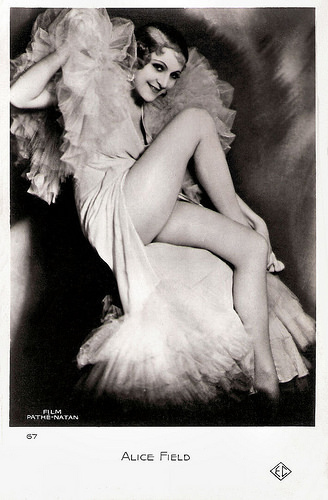
French postcard by EC, no. 67. Photo: Film Pathé-Nathan.
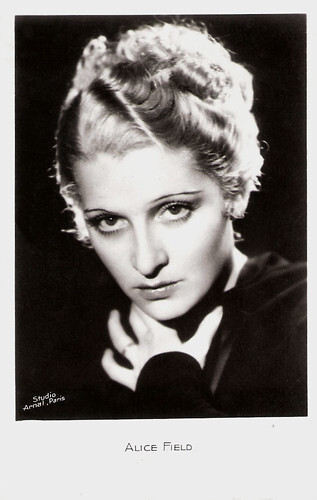
French postcard. Photo: Studio Arnal, Paris.
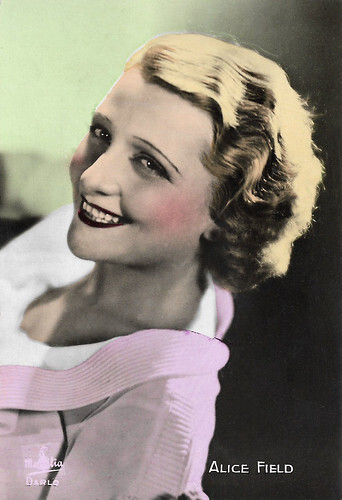
French collectors card by Massilia. Photo: Darlo.
Atlantis
Alice Field was born Alice Fille in Alger, France, now Algeria,in 1903.
She made her film debut opposite Saint-Granier in the silent production Villa Destin (Marcel L’Herbier, 1921), based on a play by Oscar Wilde. That same year she played the second wife of a well-to-do Algerian ( Marcel Vibert ) in Visages voilés... âmes closes/The Sheik's Wife (Henry Roussel, 1921).
She then focused on stage work but returned to the cinema when sound film was introduced. She played the wife of Constant Rémy in Atlantis (Ewald André Dupont, Jean Kemm, 1930), produced by British International Pictures at Elstree Studios and based on the 1929 West End play 'The Berg' by Ernest Raymond a heavily fictionalised version of the RMS Titanic story. It was filmed simultaneously with the English-language version, Atlantic (1929), the German-language version, Atlantik (1929) and the silent version, Atlantic (1929). Such Multiple-language versions were common in the early years of sound before dubbing became a more established practice.
Her film career got on steam. In the following years, Field appeared in several films. The mystery film La maison de La Flèche/The house of La Flèche (Henri Fescourt, 1930) with Annabella , was made at Twickenham Studios in London as part of a co-production that saw an English-language version directed by Leslie S. Hiscott. Next, she appeared in Le refuge/The Refuge (Léon Mathot, 1931) and Vous serez ma femme/You Will Be My Wife (Carl Boese, Serge de Poligny, 1932) with Roger Tréville . The latter was the alternative language version of the Ufa comedy Der Frechdachs/The Cheeky Devil (Carl Boese, Heinz Hille, 1932) with Willy Fritsch and Camilla Horn .
Throughout the 1930s, Field played leading and supporting roles in a dozen French films. Most of them were run-of-the-mill, but quite watchable are Cette vieille canaille/The Old Rogue (Anatole Litvak, 1933) featuring Harry Baur , and the crime drama Police mondaine/Worldly Police (Michel Bernheim, Christian Chamborant, 1937), in which she starred opposite Charles Vanel and Pierre Larquey.
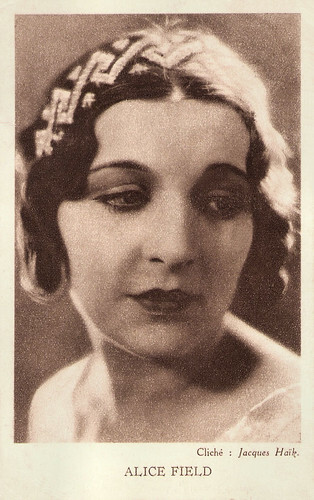
Belgian postcard by S.A. Cacao et Chocolat Kivou, Vilvorde. Photo: Jacques Haïk.
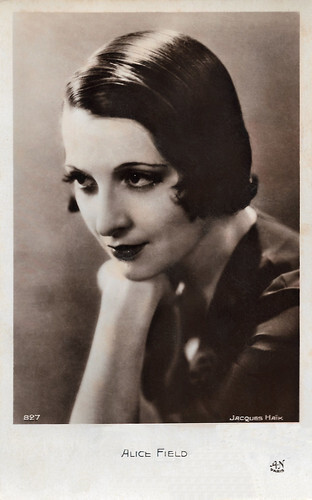
French postcard by A.N., Paris, no. 827. Photo: Jacques Haïk.
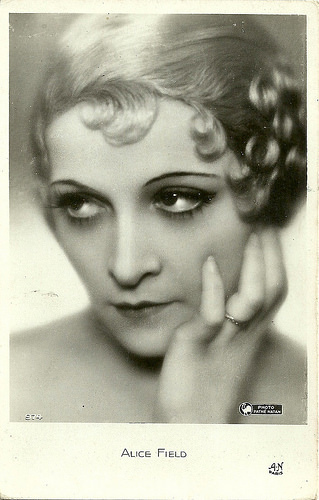
French postcard by A.N., Paris, no. 974. Photo: Pathé Natan.
Playtime
Alice Field starred in the spectacle Le tigre du Bengale/The Tiger of Eschnapur (Richard Eichberg, 1938) and the sequel Le tombeau hindou/The Indian Tomb (Richard Eichberg, 1938). These were the French language versions of the German two-parter Das indische Grabmal (Richard Eichberg, 1938) and Der Tiger von Eschnapur (Richard Eichberg, 1938).
These films were remakes of Joe May's 1919 silent films of the same name. Both versions were based on a novel by Thea Von Harbou, at one time the wife of director Fritz Lang . In turn, both Der Tiger von Eschnapur and Das Indische Grabmal were remade in 1959 by Fritz Lang .
During the 1940s, Field continued to star in French films. Among her films were the drama Campement 13/Camp 13 (Jacques Constant, 1940), and the comedy La loi du printemps/The law of spring (Jacques Daniel-Norman, 1942) with Pierre Renoir .
After the war, she kept busy although her parts became smaller. Among her films of the 1950s and 1960s are the comedy drama Au p'tit zouave/The little Zouave (Gilles Grangier, 1950) starring François Périer , the Euro-spy film Pleins feux sur Stanislas/Killer Spy (Jean-Charles Dudrumet, 1965) starring Jean Marais , and the romance Un garçon, une fille. Le dix-septième ciel/A boy, a girl. The seventeenth sky (Serge Korber, 1966) with Jean Louis Trintignant and Marie Dubois .
She continued to play roles on stage and also on television, like in the series Au théâtre ce soir/On stage tonight (1966-1970). One of her final film appearances was a small part as a customer at Royal Garden in the classic comedy Playtime (Jacques Tati, 1967) with Jacques Tati as Monsieur Hulot. Playtime is considered Tati's masterpiece and his most daring work.
Alice Field died in 1969 in Paris. She was 66.
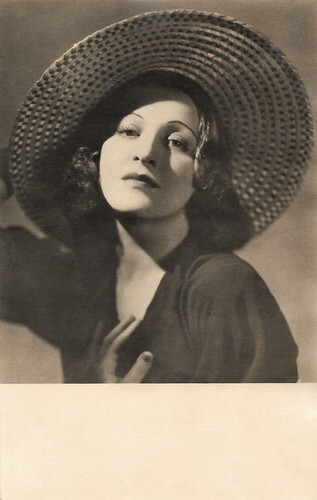
French postcard.
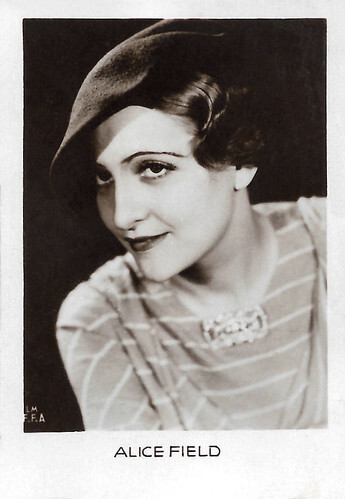
French collectors card by Ets Ungemach, Strasbourg, for Bonbons Loriot, Serie G: Cinema, sujet no. 2 (50 sujets).
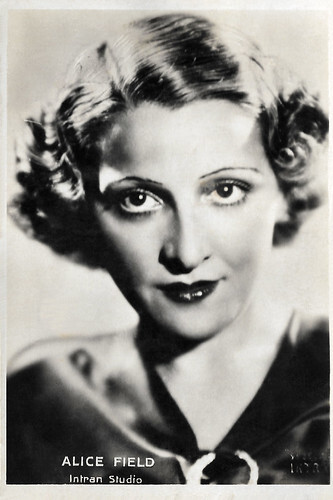
French collectors card. Photo: Intran Studio.
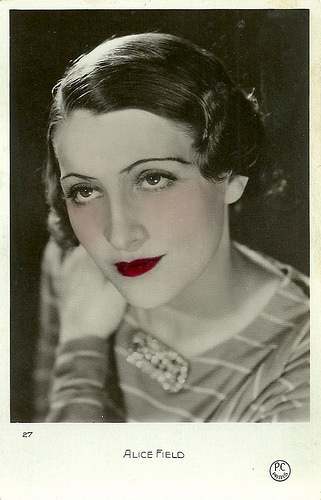
French postcard by P.C., Paris, no. 27.
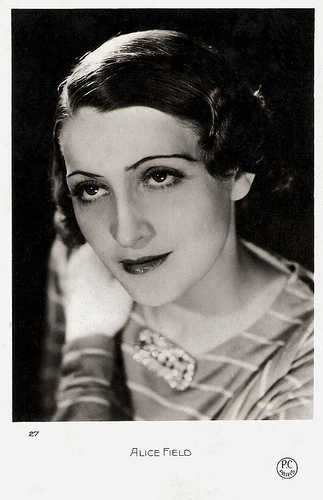
French postcard by P.C., Paris, no. 27.
Sources: AllMovie, Wikipedia (French and English) and .

French postcard by EC, no. 67. Photo: Film Pathé-Nathan.

French postcard. Photo: Studio Arnal, Paris.

French collectors card by Massilia. Photo: Darlo.
Atlantis
Alice Field was born Alice Fille in Alger, France, now Algeria,in 1903.
She made her film debut opposite Saint-Granier in the silent production Villa Destin (Marcel L’Herbier, 1921), based on a play by Oscar Wilde. That same year she played the second wife of a well-to-do Algerian ( Marcel Vibert ) in Visages voilés... âmes closes/The Sheik's Wife (Henry Roussel, 1921).
She then focused on stage work but returned to the cinema when sound film was introduced. She played the wife of Constant Rémy in Atlantis (Ewald André Dupont, Jean Kemm, 1930), produced by British International Pictures at Elstree Studios and based on the 1929 West End play 'The Berg' by Ernest Raymond a heavily fictionalised version of the RMS Titanic story. It was filmed simultaneously with the English-language version, Atlantic (1929), the German-language version, Atlantik (1929) and the silent version, Atlantic (1929). Such Multiple-language versions were common in the early years of sound before dubbing became a more established practice.
Her film career got on steam. In the following years, Field appeared in several films. The mystery film La maison de La Flèche/The house of La Flèche (Henri Fescourt, 1930) with Annabella , was made at Twickenham Studios in London as part of a co-production that saw an English-language version directed by Leslie S. Hiscott. Next, she appeared in Le refuge/The Refuge (Léon Mathot, 1931) and Vous serez ma femme/You Will Be My Wife (Carl Boese, Serge de Poligny, 1932) with Roger Tréville . The latter was the alternative language version of the Ufa comedy Der Frechdachs/The Cheeky Devil (Carl Boese, Heinz Hille, 1932) with Willy Fritsch and Camilla Horn .
Throughout the 1930s, Field played leading and supporting roles in a dozen French films. Most of them were run-of-the-mill, but quite watchable are Cette vieille canaille/The Old Rogue (Anatole Litvak, 1933) featuring Harry Baur , and the crime drama Police mondaine/Worldly Police (Michel Bernheim, Christian Chamborant, 1937), in which she starred opposite Charles Vanel and Pierre Larquey.

Belgian postcard by S.A. Cacao et Chocolat Kivou, Vilvorde. Photo: Jacques Haïk.

French postcard by A.N., Paris, no. 827. Photo: Jacques Haïk.

French postcard by A.N., Paris, no. 974. Photo: Pathé Natan.
Playtime
Alice Field starred in the spectacle Le tigre du Bengale/The Tiger of Eschnapur (Richard Eichberg, 1938) and the sequel Le tombeau hindou/The Indian Tomb (Richard Eichberg, 1938). These were the French language versions of the German two-parter Das indische Grabmal (Richard Eichberg, 1938) and Der Tiger von Eschnapur (Richard Eichberg, 1938).
These films were remakes of Joe May's 1919 silent films of the same name. Both versions were based on a novel by Thea Von Harbou, at one time the wife of director Fritz Lang . In turn, both Der Tiger von Eschnapur and Das Indische Grabmal were remade in 1959 by Fritz Lang .
During the 1940s, Field continued to star in French films. Among her films were the drama Campement 13/Camp 13 (Jacques Constant, 1940), and the comedy La loi du printemps/The law of spring (Jacques Daniel-Norman, 1942) with Pierre Renoir .
After the war, she kept busy although her parts became smaller. Among her films of the 1950s and 1960s are the comedy drama Au p'tit zouave/The little Zouave (Gilles Grangier, 1950) starring François Périer , the Euro-spy film Pleins feux sur Stanislas/Killer Spy (Jean-Charles Dudrumet, 1965) starring Jean Marais , and the romance Un garçon, une fille. Le dix-septième ciel/A boy, a girl. The seventeenth sky (Serge Korber, 1966) with Jean Louis Trintignant and Marie Dubois .
She continued to play roles on stage and also on television, like in the series Au théâtre ce soir/On stage tonight (1966-1970). One of her final film appearances was a small part as a customer at Royal Garden in the classic comedy Playtime (Jacques Tati, 1967) with Jacques Tati as Monsieur Hulot. Playtime is considered Tati's masterpiece and his most daring work.
Alice Field died in 1969 in Paris. She was 66.

French postcard.

French collectors card by Ets Ungemach, Strasbourg, for Bonbons Loriot, Serie G: Cinema, sujet no. 2 (50 sujets).

French collectors card. Photo: Intran Studio.

French postcard by P.C., Paris, no. 27.

French postcard by P.C., Paris, no. 27.
Sources: AllMovie, Wikipedia (French and English) and .
Published on November 30, 2022 22:00
November 29, 2022
La Collectionneuse: Jean Arthur
Rarely an actress had taken so much time to achieve recognition than Jean Arthur. She made her film debut in 1923 and had to wait for about thirteen years to become a full-fledged star and one of the most famous comedy queens of her time. She was part of a 1930s new breed of heroines: independent, strong-willed, breezy, quick-witted, no-nonsense and sassy. By becoming one of the quintessential epitomes of the working girl in her films, she paved the way for more accurate depictions of women in Hollywood. Her distinctive voice, at once squeaky, cracked, nasal and husky, which at times could change unpredictably in tones, became one of her principal assets and formed a winning combination with her perfect comic timing and endearing on-screen persona. Jean Arthur’s unique contributions to social and screwball comedies have been deservedly acknowledged by film historians.
When she was at the top, Jean Arthur stunned columnists by recoiling from interviews, by showing an aversion to publicity and by avoiding parties and nightclubs. She was even compared to Greta Garbo for her alleged elusiveness. In 1942, she received a Sour Apple Award for being the least cooperative actress in Hollywood. About the capital of cinema, she was adamant: "I hated the place - not the work, but the lack of privacy, those terrible, prying fan magazine writers and all the surrounding exploitation". In private, she was known to be shy and insecure and to be plagued with stage and screen fright. She also sought perfection in her work, always fearing not attaining the high standards of acting she had set for herself. In real life, she always took great care to retain her privacy, her individuality and her non-conformism and she could appear as anti-social to many people. She once said: "I’m not an adult, that’s my explanation of myself. Except when I’m working on a set, I have all the inhibitions and shyness of the bashful, backward child". She also declared: "As a character in a play, I feel as if I can be what people expect. As Jean Arthur, I never feel as if I know what people expect". For sure, she was a complex and conflicted person ... but what a good actress she became!
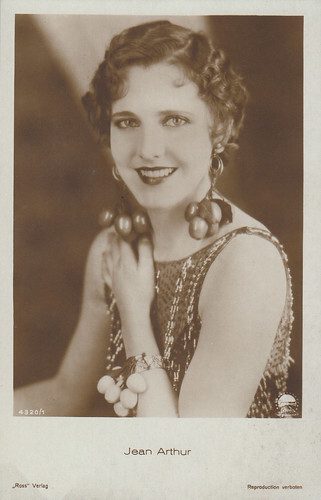
German postcard by Ross Verlag, no. 4320/1, 1929-1930. Photo: Paramount.
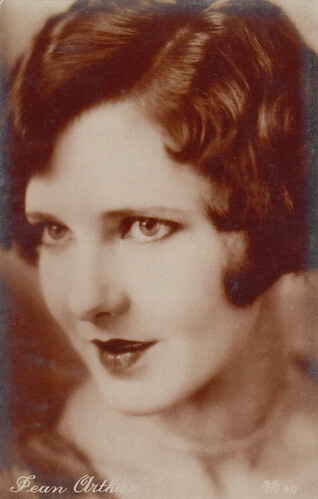
Spanish postcard by M.C., Barcelona, no. 90.
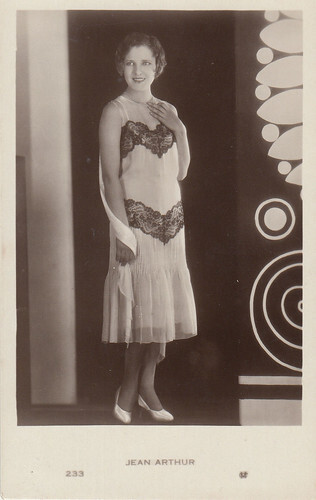
Spanish postcard by M.C., Barcelona, no. 233.
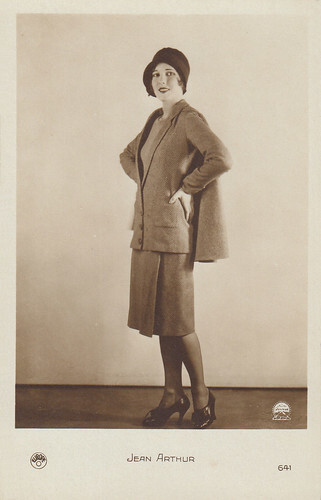
French postcard by Europe, no. 641. Photo: Paramount.
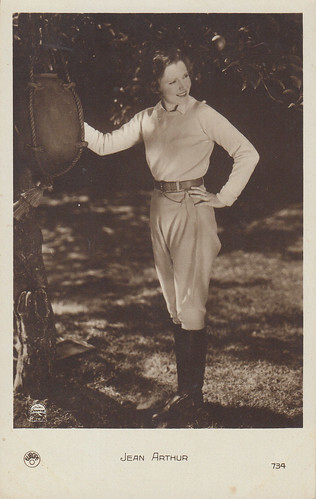
French postcard by Europe, no. 734. Photo: Paramount.
A long struggle to achieve recognition
Jean Arthur was born Gladys Georgianna Greene on the 17th of October 1900 in Plattsburgh, New York, U.S.A. Her father was a photographer. During the First World War, she took a job as a stenographer but later turned to photographic modelling. This led her to be noticed by Fox and she made her film debut in a supporting role in John Ford’s Cameo Kirby (1923). She took her stage name from Saint Joan of Arc / Jeanne d’Arc, who was one of her favourite heroines, and King Arthur. She was then given a leading part in The Temple of Venus (1923) but was found too inexperienced and was quickly replaced by Mary Philbin .
For a few years, she was mostly seen in comedy shorts and low-budget Westerns. In 1928, she got her break in the Paramount film Warming Up, which earned her good reviews. As a result, she was given a three-year contract. Unfortunately, during her stay at Paramount, she appeared mostly in inconsequential ingenue roles. Nevertheless, from time to time, she had the opportunity to impress the critics, for example in The Mysterious Dr Fu Manchu (1929) or as Clara Bow ’s conniving little sister in The Saturday Night Kid (1929).
At the time, she had an affair with David O’Selznick, who was then a rising young Paramount executive. He tried his best to promote her but it seemed that the company had somewhat lost interest in her and was not really convinced anymore that she would ever make it to the top. In 1931, her contract was not renewed and Jean Arthur decided to go on stage. Interestingly enough, her plays brought her on the whole more recognition than she ever had during her movie days.
After her personal success on Broadway in 'The Curtain Rises' (1933), an offer came from Columbia to play a reporter opposite Jack Holt in Whirlpool (1934). During filming, Columbia executives felt she had the makings of a star and decided to sign her to a five-year contract in February 1934. They put her in The Defense Rests (1934) and The Most Precious Thing in Life (1934) with mixed results but she soon shone as a hard-boiled working girl in John Ford’s The Whole Town’s Talking (1935).
Definitely gone was the nondescript ingenue of a few years before: a new image of Jean Arthur had emerged. Her career moved forward with such films as Party Wire (1935) or If You Could Only Cook (1935). After Carole Lombard had backed out, she was chosen by Frank Capra to play Babe Bennett, a cynical newspaperwoman who finally falls in love with the man she had been cheated on, in Mr Deeds Goes to Town (1936), opposite Gary Cooper . It finally made her a full-fledged star.
She then notably was William Powell ’s co-star in The Ex-Mrs Bradford (1936) and, as Calamity Jane, reunited with Gary Cooper in Cecil B. De Mille ’s The Plainsman (1937). She also showed her skills in films such as History Is Made at Night (1937) and Easy Living (1937).
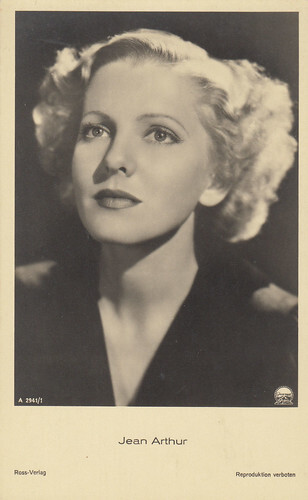
German postcard by Ross Verlag, no. A 2941/1, 1939-1940. Photo: Paramount.
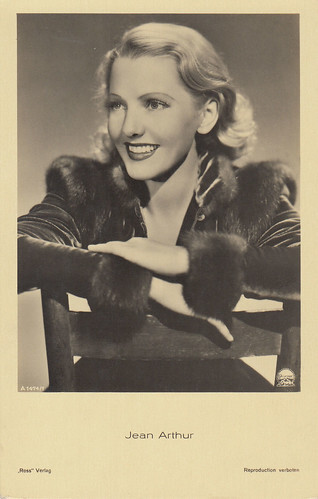
German postcard by Ross Verlag, no. A 1474/1, 1937-1938. Photo: Paramount.
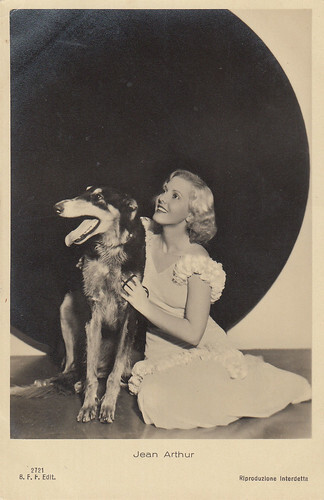
Italian postcard by Ballerini & Fratini, Firenze, no. 2721.
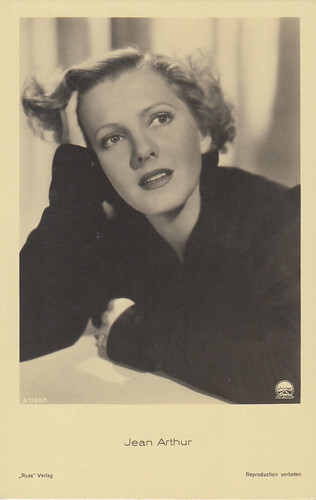
German postcard by Ross Verlag, no. A 1198/1, 1937-1938. Photo: Paramount.
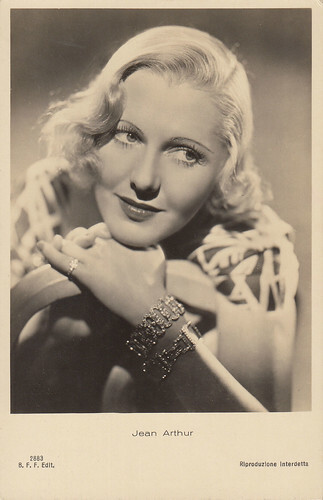
Italian postcard by Ballerini & Fratini, Firenze, no. 2883.
At the top of her profession
In March 1938, she signed a new contract with Columbia, succeeding in adding a clause which relieved her from any duty to participate in interviews or public appearances. In December 1938, she screen-tested for the role of Scarlett O’Hara in Gone With the Wind but most people agreed that she was not suited for the part.
She was again successfully directed by Frank Capra in You Can’t Take It with You (1938) and Mr Smith Goes to Washington (1939). Furthermore, she tremendously liked being directed by George Stevens in The Talk of the Town (1942) and The More the Merrier (1943), which got her her only Oscar nomination. She also joined the list of 'Hawksian Women' in Howard Hawks’ Only Angels Have Wings (1939).
Her other films include The Devil and Miss Jones (1941) and The Lady Takes a Chance (1943), which were produced by her then-husband Frank Ross for RKO. After The Impatient Years (1944), her contract with Columbia was over, much to her relief. Their relationship had been a stormy one and she had been suspended on several occasions.
In 1947, she signed a three-picture deal with Paramount. She only made two: Billy Wilder’s A Foreign Affair (1948) and George Stevens’ Western Shane (1953). She gave good performances in both but the ever-insecure actress thought Wilder had favoured Marlene Dietrich in the first and was not too fond of the latter as she "couldn’t use any comedy bits in it at all and just had to act old and worn out".
After she repeatedly turned down the scripts offered to her, Paramount bought out the rest of her contract and she never made another Hollywood movie. In the mid-1960s, she decided to give television a try and starred in 1965 in an episode of the popular series Gunsmoke. She was delighted by the results and was then featured in 1966 in a weekly 30-minute situation comedy program called The Jean Arthur Show, in which she played a lawyer. Unfortunately, it was a flop and was cancelled after twelve episodes. In August 1973, to the amazement of everyone, in view of her bashfulness, she agreed to appear, alongside Frank Capra, in the only talk show of her career, The Merv Griffin Show.
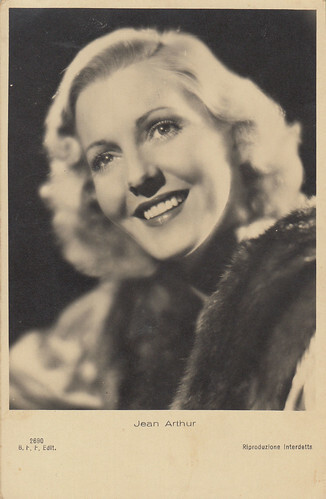
Italian postcard by Ballerini & Fratini, Firenze, no. 2690.
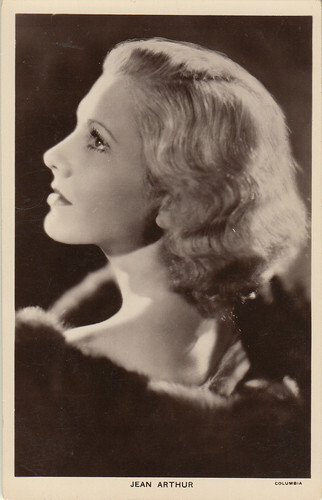
British postcard by Picturegoer, no. 438b. Photo: Columbia.
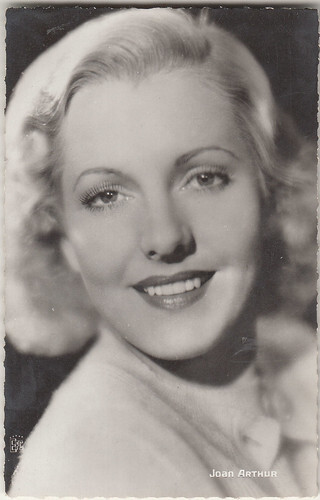
French postcard by Editions et publications cinématographiques (EPC), no. 164.

British postcard. Photo: Columbia. Jean Arthur in The Whole Town’s Talking (John Ford, 1935). Passport to Fame was the British premiere title.
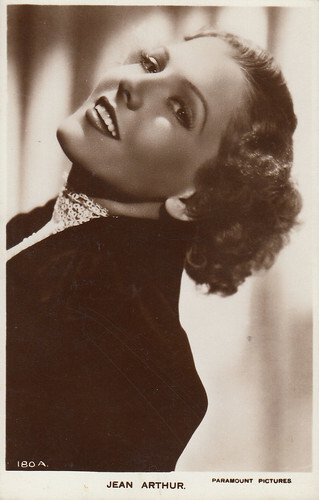
British postcard, no. 180 A. Photo: Paramount Pictures.
Jean Arthur’s later stage career: a big hit and several downs
In 1945, Jean Arthur was signed for the role of Billie Dawn in 'Born Yesterday,' a play Garson Kanin had written with her in mind. She opened with it in New Haven on the 20th of December 1945 and quit in Boston several days later on the 1st of January, pleading health reasons. She was quickly replaced by newcomer Judy Holliday, who triumphed with it on Broadway from February 1946 to December 1949 and got an Oscar in 1951 for the film version.
Ultimately, Jean Arthur was a hit on Broadway by playing in James Barrie’s 'Peter Pan', a role she had longed to play for a long time, from April 1950 to January 1951. In 1954, she toured with G.B. Shaw’s 'Saint Joan', beginning on the 17th of September. But she didn’t get along with director Harold Clurman and, if several critics were enthusiastic, some others were not overly convinced by her portrayal of Joan. Her self-confidence began to dwindle and she gave her last performance on the 6th of November, declaring that she was too exhausted to go on.
She took a revenge of sorts when she gave a very successful concert reading of the same play at the University of Berkeley from the 6th to the 15th of February 1964. In 1967, she accepted to play a spinster involved with hippies in 'The Freaking Out of Stephanie Blake'. The first preview on the 30th of October was a disaster. There wasn’t to be any opening night as, at the very beginning of November, she quit, amidst rumours of a nervous breakdown.
At the beginning of 1973, she accepted an offer from John Springer to appear on stage at the Manhattan Town Hall in his Legendary Ladies of the Movies series. For one evening, she would have been slated to answer questions from the audience, after a showing of film clips. But she quickly began to get cold feet, finally cancelled her participation and was replaced by Joan Crawford .
On the 17th of October 1975, she opened in Cleveland opposite Melvyn Douglas in 'First Monday' in October and played it for the last time on the 29th, allegedly suffering from a viral affection. It was the fourth time that she had pulled out of a legitimate stage production. There had been much speculation about this pattern. It’s commonly assumed that her illness symptoms were real, not feigned, but many thought that those troubles were mostly of psychosomatic origin.
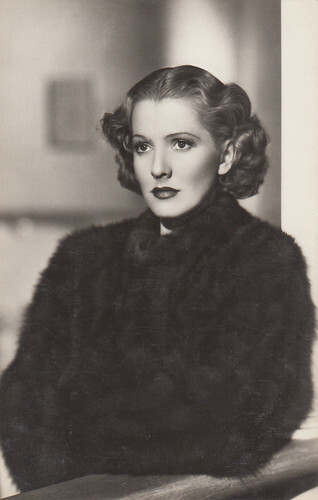
Spanish postcard by Infonal, no. 122.
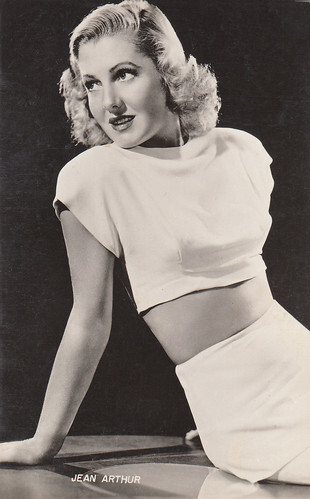
Vintage postcard.
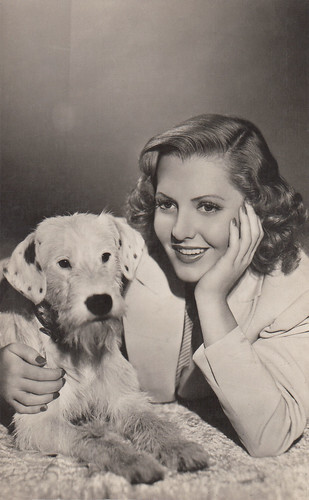
Spanish postcard by Archivo Bermejo.
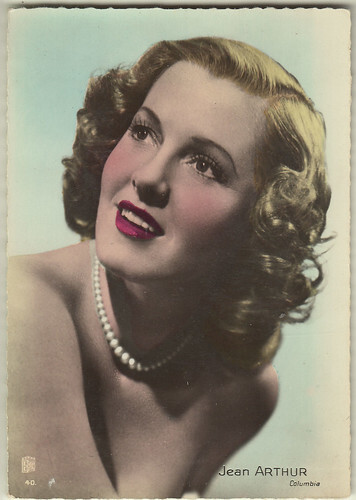
French postcard by EPC, no. 40. Photo: Columbia.
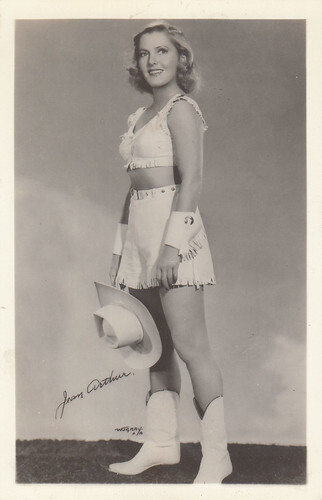
American postcard by W.J. Gray, L.A.
Jean Arthur as a teacher
After the 'The Freaking Out of Stephanie Blake' debacle, she taught drama at Vassar College from 1968 to 1972. Her methods didn’t win unanimity and, in the end, her relationship with the school director and several other teachers had become strained.
She had another ill-fated try at acting teaching at the North California School of the Arts in Winston-Salem and it was not a successful and happy experience for her. It only lasted one 1972-1973 semester.
In 1977, she sold her Driftwood Cottage, a place she had bought in Carmel in 1946, and moved to a new house called Bay Cottage in the same city. Still fiercely protecting her privacy, she embraced a certain measure of seclusion, spending much time gardening, tending her beloved cats (she had been an animal lover all her life) and reading books. True to herself, she continuously turned down interview requests.
In 1982, she was one of the very few stars not present when the American Film Institute honoured Frank Capra with a Life Achievement Award. In 1985, she declined to offer anecdotes in the documentary George Stevens: A Filmmaker’s Journey. She had a close circle of selected friends such as actor Roddy McDowall and Ellen Mastroianni, a neighbour she had met at the end of the 1950s, who took care of her until the end.
In 1989, she broke her hip and suffered a stroke, which left her an invalid. In June 1991, she had to move to a nursing home, where she passed away from heart failure on the 19th. According to her wishes, her body was cremated and her ashes were scattered at sea.
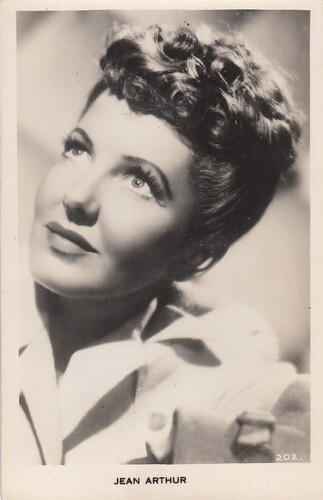
British postcard by Valentine’s, no.202.
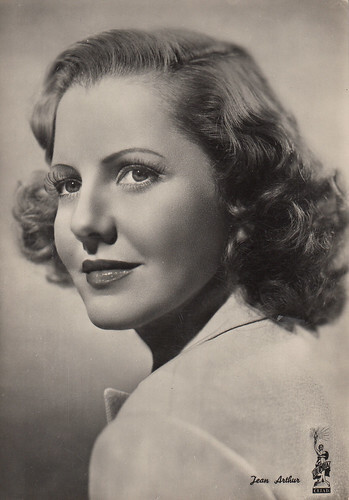
Italian postcard by Rotalfoto, Milano, no. 41. Photo: Columbia CEIAD.
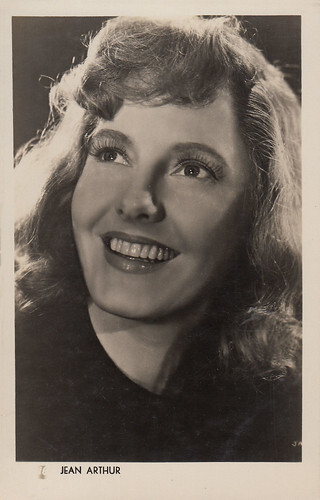
Spanish postcard by Kores Carboplan.
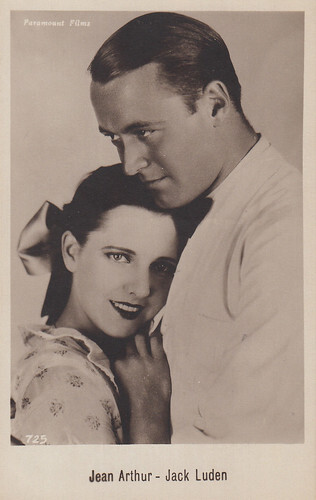
Italian postcard by G.B. Falci, Milano, no. 725. Jean Arthur and Jack Luden played together in Sins of the Fathers (Ludwig Berger, 1928).
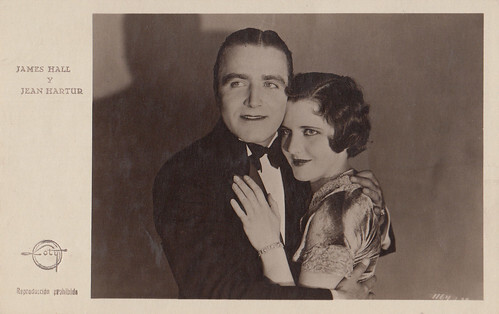
Spanish postcard by Loty, no. 1164. Jean Arthur and James Hall in The Canary Murder Case (Malcolm St. Clair, 1929).
Text and postcards: Marlene Pilaete.
When she was at the top, Jean Arthur stunned columnists by recoiling from interviews, by showing an aversion to publicity and by avoiding parties and nightclubs. She was even compared to Greta Garbo for her alleged elusiveness. In 1942, she received a Sour Apple Award for being the least cooperative actress in Hollywood. About the capital of cinema, she was adamant: "I hated the place - not the work, but the lack of privacy, those terrible, prying fan magazine writers and all the surrounding exploitation". In private, she was known to be shy and insecure and to be plagued with stage and screen fright. She also sought perfection in her work, always fearing not attaining the high standards of acting she had set for herself. In real life, she always took great care to retain her privacy, her individuality and her non-conformism and she could appear as anti-social to many people. She once said: "I’m not an adult, that’s my explanation of myself. Except when I’m working on a set, I have all the inhibitions and shyness of the bashful, backward child". She also declared: "As a character in a play, I feel as if I can be what people expect. As Jean Arthur, I never feel as if I know what people expect". For sure, she was a complex and conflicted person ... but what a good actress she became!

German postcard by Ross Verlag, no. 4320/1, 1929-1930. Photo: Paramount.

Spanish postcard by M.C., Barcelona, no. 90.

Spanish postcard by M.C., Barcelona, no. 233.

French postcard by Europe, no. 641. Photo: Paramount.

French postcard by Europe, no. 734. Photo: Paramount.
A long struggle to achieve recognition
Jean Arthur was born Gladys Georgianna Greene on the 17th of October 1900 in Plattsburgh, New York, U.S.A. Her father was a photographer. During the First World War, she took a job as a stenographer but later turned to photographic modelling. This led her to be noticed by Fox and she made her film debut in a supporting role in John Ford’s Cameo Kirby (1923). She took her stage name from Saint Joan of Arc / Jeanne d’Arc, who was one of her favourite heroines, and King Arthur. She was then given a leading part in The Temple of Venus (1923) but was found too inexperienced and was quickly replaced by Mary Philbin .
For a few years, she was mostly seen in comedy shorts and low-budget Westerns. In 1928, she got her break in the Paramount film Warming Up, which earned her good reviews. As a result, she was given a three-year contract. Unfortunately, during her stay at Paramount, she appeared mostly in inconsequential ingenue roles. Nevertheless, from time to time, she had the opportunity to impress the critics, for example in The Mysterious Dr Fu Manchu (1929) or as Clara Bow ’s conniving little sister in The Saturday Night Kid (1929).
At the time, she had an affair with David O’Selznick, who was then a rising young Paramount executive. He tried his best to promote her but it seemed that the company had somewhat lost interest in her and was not really convinced anymore that she would ever make it to the top. In 1931, her contract was not renewed and Jean Arthur decided to go on stage. Interestingly enough, her plays brought her on the whole more recognition than she ever had during her movie days.
After her personal success on Broadway in 'The Curtain Rises' (1933), an offer came from Columbia to play a reporter opposite Jack Holt in Whirlpool (1934). During filming, Columbia executives felt she had the makings of a star and decided to sign her to a five-year contract in February 1934. They put her in The Defense Rests (1934) and The Most Precious Thing in Life (1934) with mixed results but she soon shone as a hard-boiled working girl in John Ford’s The Whole Town’s Talking (1935).
Definitely gone was the nondescript ingenue of a few years before: a new image of Jean Arthur had emerged. Her career moved forward with such films as Party Wire (1935) or If You Could Only Cook (1935). After Carole Lombard had backed out, she was chosen by Frank Capra to play Babe Bennett, a cynical newspaperwoman who finally falls in love with the man she had been cheated on, in Mr Deeds Goes to Town (1936), opposite Gary Cooper . It finally made her a full-fledged star.
She then notably was William Powell ’s co-star in The Ex-Mrs Bradford (1936) and, as Calamity Jane, reunited with Gary Cooper in Cecil B. De Mille ’s The Plainsman (1937). She also showed her skills in films such as History Is Made at Night (1937) and Easy Living (1937).

German postcard by Ross Verlag, no. A 2941/1, 1939-1940. Photo: Paramount.

German postcard by Ross Verlag, no. A 1474/1, 1937-1938. Photo: Paramount.

Italian postcard by Ballerini & Fratini, Firenze, no. 2721.

German postcard by Ross Verlag, no. A 1198/1, 1937-1938. Photo: Paramount.

Italian postcard by Ballerini & Fratini, Firenze, no. 2883.
At the top of her profession
In March 1938, she signed a new contract with Columbia, succeeding in adding a clause which relieved her from any duty to participate in interviews or public appearances. In December 1938, she screen-tested for the role of Scarlett O’Hara in Gone With the Wind but most people agreed that she was not suited for the part.
She was again successfully directed by Frank Capra in You Can’t Take It with You (1938) and Mr Smith Goes to Washington (1939). Furthermore, she tremendously liked being directed by George Stevens in The Talk of the Town (1942) and The More the Merrier (1943), which got her her only Oscar nomination. She also joined the list of 'Hawksian Women' in Howard Hawks’ Only Angels Have Wings (1939).
Her other films include The Devil and Miss Jones (1941) and The Lady Takes a Chance (1943), which were produced by her then-husband Frank Ross for RKO. After The Impatient Years (1944), her contract with Columbia was over, much to her relief. Their relationship had been a stormy one and she had been suspended on several occasions.
In 1947, she signed a three-picture deal with Paramount. She only made two: Billy Wilder’s A Foreign Affair (1948) and George Stevens’ Western Shane (1953). She gave good performances in both but the ever-insecure actress thought Wilder had favoured Marlene Dietrich in the first and was not too fond of the latter as she "couldn’t use any comedy bits in it at all and just had to act old and worn out".
After she repeatedly turned down the scripts offered to her, Paramount bought out the rest of her contract and she never made another Hollywood movie. In the mid-1960s, she decided to give television a try and starred in 1965 in an episode of the popular series Gunsmoke. She was delighted by the results and was then featured in 1966 in a weekly 30-minute situation comedy program called The Jean Arthur Show, in which she played a lawyer. Unfortunately, it was a flop and was cancelled after twelve episodes. In August 1973, to the amazement of everyone, in view of her bashfulness, she agreed to appear, alongside Frank Capra, in the only talk show of her career, The Merv Griffin Show.

Italian postcard by Ballerini & Fratini, Firenze, no. 2690.

British postcard by Picturegoer, no. 438b. Photo: Columbia.

French postcard by Editions et publications cinématographiques (EPC), no. 164.

British postcard. Photo: Columbia. Jean Arthur in The Whole Town’s Talking (John Ford, 1935). Passport to Fame was the British premiere title.

British postcard, no. 180 A. Photo: Paramount Pictures.
Jean Arthur’s later stage career: a big hit and several downs
In 1945, Jean Arthur was signed for the role of Billie Dawn in 'Born Yesterday,' a play Garson Kanin had written with her in mind. She opened with it in New Haven on the 20th of December 1945 and quit in Boston several days later on the 1st of January, pleading health reasons. She was quickly replaced by newcomer Judy Holliday, who triumphed with it on Broadway from February 1946 to December 1949 and got an Oscar in 1951 for the film version.
Ultimately, Jean Arthur was a hit on Broadway by playing in James Barrie’s 'Peter Pan', a role she had longed to play for a long time, from April 1950 to January 1951. In 1954, she toured with G.B. Shaw’s 'Saint Joan', beginning on the 17th of September. But she didn’t get along with director Harold Clurman and, if several critics were enthusiastic, some others were not overly convinced by her portrayal of Joan. Her self-confidence began to dwindle and she gave her last performance on the 6th of November, declaring that she was too exhausted to go on.
She took a revenge of sorts when she gave a very successful concert reading of the same play at the University of Berkeley from the 6th to the 15th of February 1964. In 1967, she accepted to play a spinster involved with hippies in 'The Freaking Out of Stephanie Blake'. The first preview on the 30th of October was a disaster. There wasn’t to be any opening night as, at the very beginning of November, she quit, amidst rumours of a nervous breakdown.
At the beginning of 1973, she accepted an offer from John Springer to appear on stage at the Manhattan Town Hall in his Legendary Ladies of the Movies series. For one evening, she would have been slated to answer questions from the audience, after a showing of film clips. But she quickly began to get cold feet, finally cancelled her participation and was replaced by Joan Crawford .
On the 17th of October 1975, she opened in Cleveland opposite Melvyn Douglas in 'First Monday' in October and played it for the last time on the 29th, allegedly suffering from a viral affection. It was the fourth time that she had pulled out of a legitimate stage production. There had been much speculation about this pattern. It’s commonly assumed that her illness symptoms were real, not feigned, but many thought that those troubles were mostly of psychosomatic origin.

Spanish postcard by Infonal, no. 122.

Vintage postcard.

Spanish postcard by Archivo Bermejo.

French postcard by EPC, no. 40. Photo: Columbia.

American postcard by W.J. Gray, L.A.
Jean Arthur as a teacher
After the 'The Freaking Out of Stephanie Blake' debacle, she taught drama at Vassar College from 1968 to 1972. Her methods didn’t win unanimity and, in the end, her relationship with the school director and several other teachers had become strained.
She had another ill-fated try at acting teaching at the North California School of the Arts in Winston-Salem and it was not a successful and happy experience for her. It only lasted one 1972-1973 semester.
In 1977, she sold her Driftwood Cottage, a place she had bought in Carmel in 1946, and moved to a new house called Bay Cottage in the same city. Still fiercely protecting her privacy, she embraced a certain measure of seclusion, spending much time gardening, tending her beloved cats (she had been an animal lover all her life) and reading books. True to herself, she continuously turned down interview requests.
In 1982, she was one of the very few stars not present when the American Film Institute honoured Frank Capra with a Life Achievement Award. In 1985, she declined to offer anecdotes in the documentary George Stevens: A Filmmaker’s Journey. She had a close circle of selected friends such as actor Roddy McDowall and Ellen Mastroianni, a neighbour she had met at the end of the 1950s, who took care of her until the end.
In 1989, she broke her hip and suffered a stroke, which left her an invalid. In June 1991, she had to move to a nursing home, where she passed away from heart failure on the 19th. According to her wishes, her body was cremated and her ashes were scattered at sea.

British postcard by Valentine’s, no.202.

Italian postcard by Rotalfoto, Milano, no. 41. Photo: Columbia CEIAD.

Spanish postcard by Kores Carboplan.

Italian postcard by G.B. Falci, Milano, no. 725. Jean Arthur and Jack Luden played together in Sins of the Fathers (Ludwig Berger, 1928).

Spanish postcard by Loty, no. 1164. Jean Arthur and James Hall in The Canary Murder Case (Malcolm St. Clair, 1929).
Text and postcards: Marlene Pilaete.
Published on November 29, 2022 22:00
Paul van Yperen's Blog
- Paul van Yperen's profile
- 13 followers
Paul van Yperen isn't a Goodreads Author
(yet),
but they
do have a blog,
so here are some recent posts imported from
their feed.



